How To Learn How To Draw Portraits
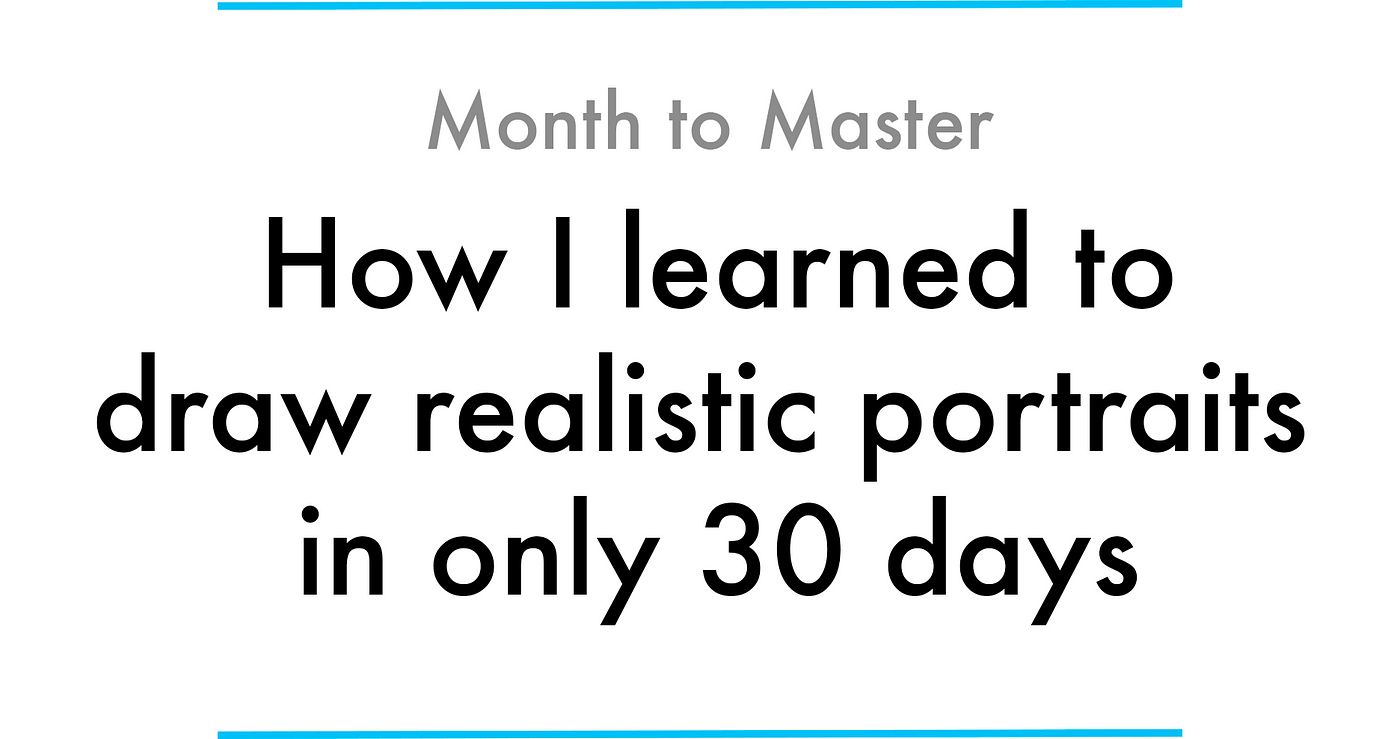
On December 1, 2016, I asked myself the question: With merely one month of practice, can I larn how to draw realistic portraits with only pencil and paper?
On December 24, 2016, after 26 hours of practice, I found out that the respond was yes.
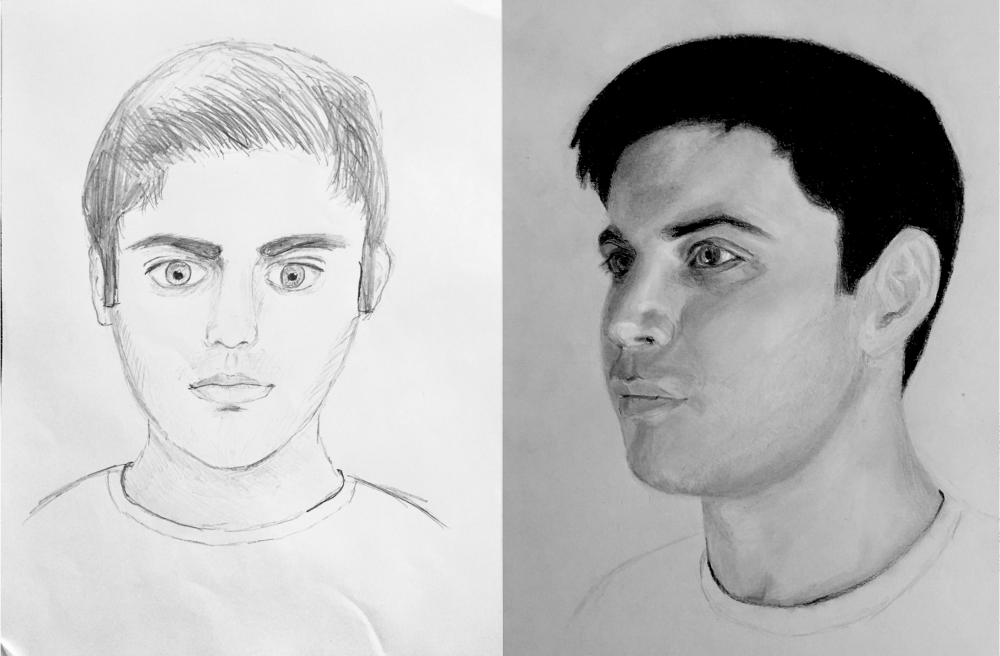
During the month of December, I documented my unabridged learning procedure in a serial of 31 daily blog posts, which are compiled here into a unmarried narrative. In this article, y'all tin relive my month of insights, frustrations, learning hacks, and triumphs, as I strive towards monthly mastery.

New month, new challenge.
For the calendar month of Dec, my goal is to describe a realistic self-portrait with but pencil and paper. Along the manner, in lodge to learn the fundamentals of drawing and portraiture, I will too depict many other faces, which will hopefully keep this month'due south posts more varied and interesting.
This new challenge starts today, December 1, 2016, and, by December 31, I promise to be a master of portrait drawing.
My starting point
I've had strong creative tendencies since I was a child, but I've never invested much in my fine art skills. Instead, I've channeled my artistic impulses mainly through music, moving-picture show, and computer-aided design.
Thus, to set a baseline for this month'due south claiming, I've drawn a earlier cocky-portrait with my current drawing skills. Although it's not the absolute worst thing e'er drawn, it sadly doesn't look very much like me.
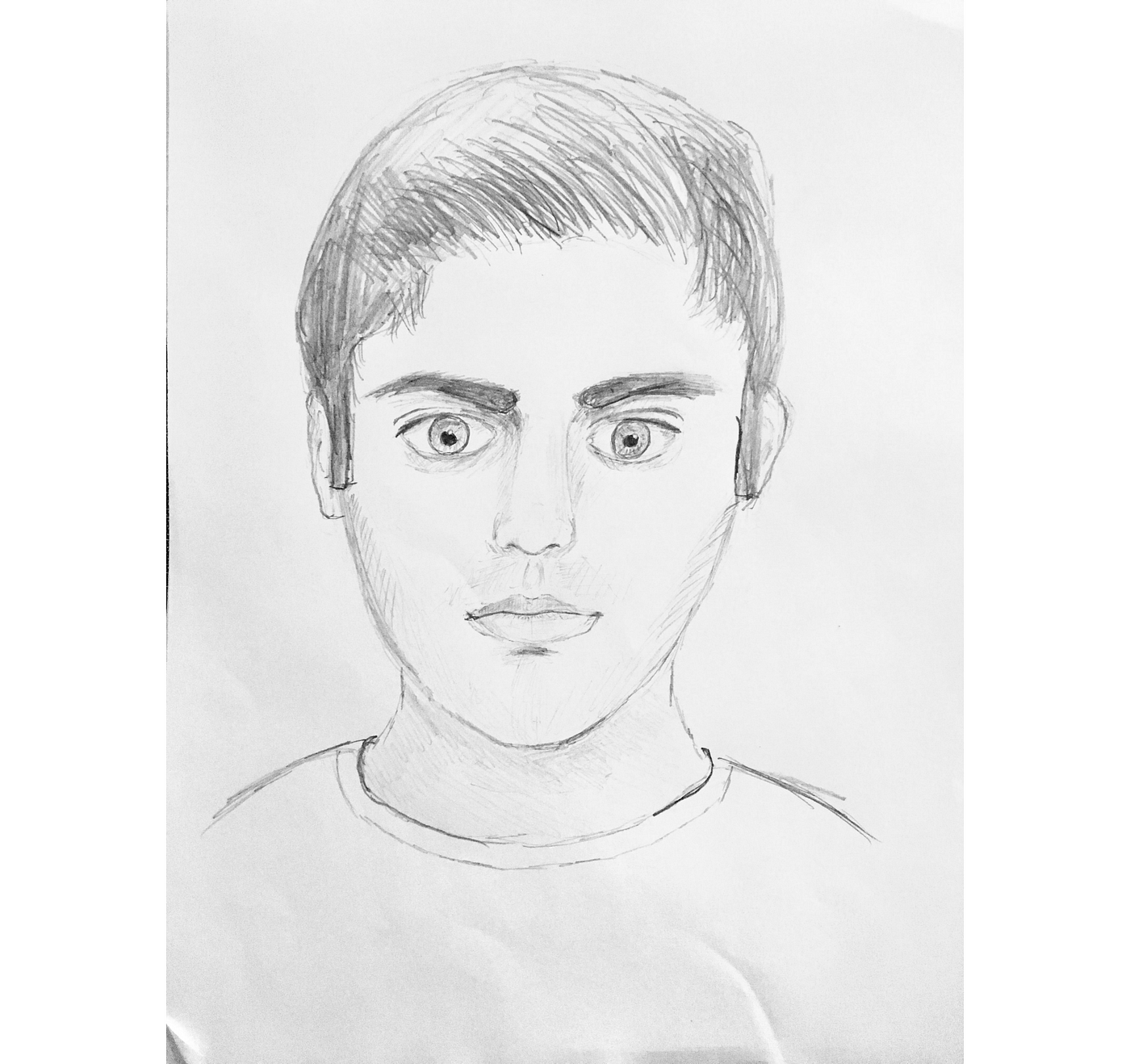
Measuring success
Measuring success for this challenge is certainly more subjective than last month (where I successfully memorized a deck of cards in less than two minutes).
In this instance, the best I can exercise is bear witness a photograph that demonstrates the level of drawing I'm aiming to reach…
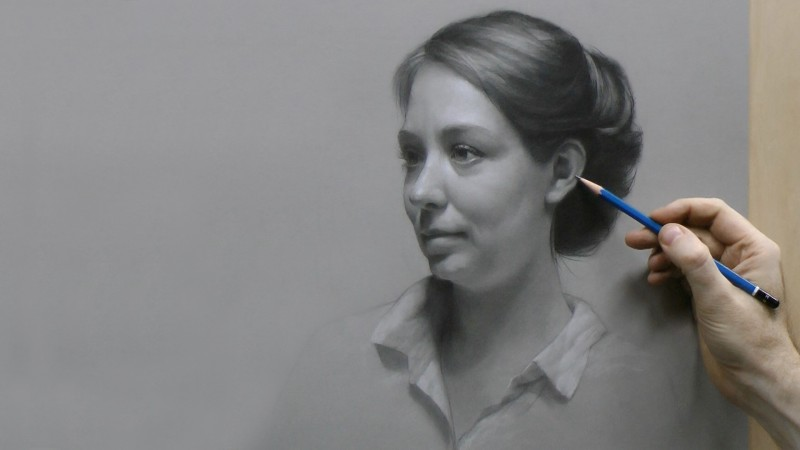
This portrait is the example drawn in the Vitruvian Studio Portrait Cartoon Course, which is the course I'll be following this month.
Clearly, there are major differences in realism between my starting drawing and this case portrait. So, if I can match the level of this example (which will be, of course, a subjective, only hopefully honest sentence), I volition consider this challenge a success.
With my goal set, it's time to start drawing…

In my life, I've created a off-white bit of (what I'll call) art. Nevertheless, I've done and then, not by relying on well-developed art skills, but instead, past cheating my style through the creative process.
Basically, I've used everything at my disposal (except for fine arts skills) to create artistically.
Y'all can make up one's mind if this is cheating or non, but either way, this month is going to exist different. This month, I am actually going to invest in my fine art skills. This month, I'k going to take a pencil and paper, and nothing else, and make information technology happen.
However, earlier I make information technology happen, I thought information technology would be fun to share some of my previous works.
ane. Lego Portraits (with the help of Photoshop)
During loftier school, whenever I was tasked with making someone a gift, I unremarkably opted to construct a custom Warhol-inspired portrait out of Legos.
Here are two portraits that I fabricated for my cousins Adam and Marissa.
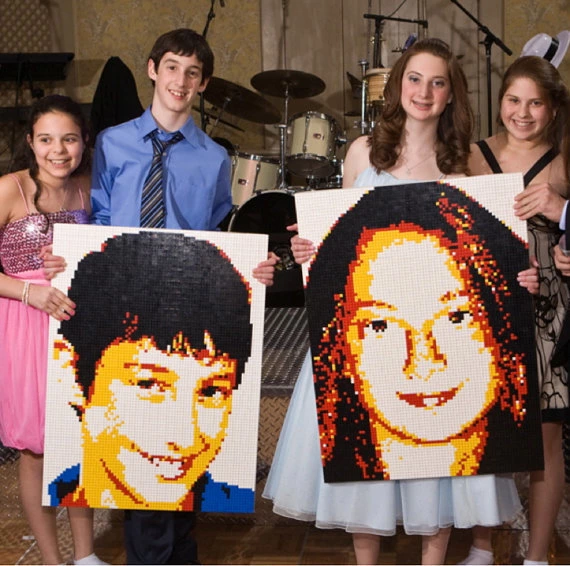
And some other i I made for my grandparents.
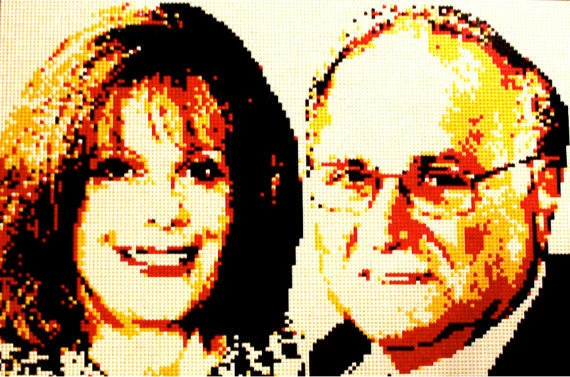
While these pieces may look similar they required some amount of artistic genius to pull off (practice they?), that'southward really non the case. Instead, these pieces just required some clever computational analysis, planning in Photoshop, and executional patience (while glueing and placing each Lego piece).
The computer was the existent artistic champion here.
2. Counterfeit paintings (using optical tricks)
I've besides experimented using optical tools (like mirrors and lens) to mechanically create. Although, I haven't invested enough time to produce anything worth sharing.
Tim Jenison, on the other hand, does have something worth sharing. Without any artistic preparation, he painted a nearly-verbal replica of a Vermeer painting solely using optical techniques.
Tim'south journey is documented in the Penn and Teller-produced film "Tim's Vermeer", which I highly recommend you check out.
Here'south Tim's final painting.
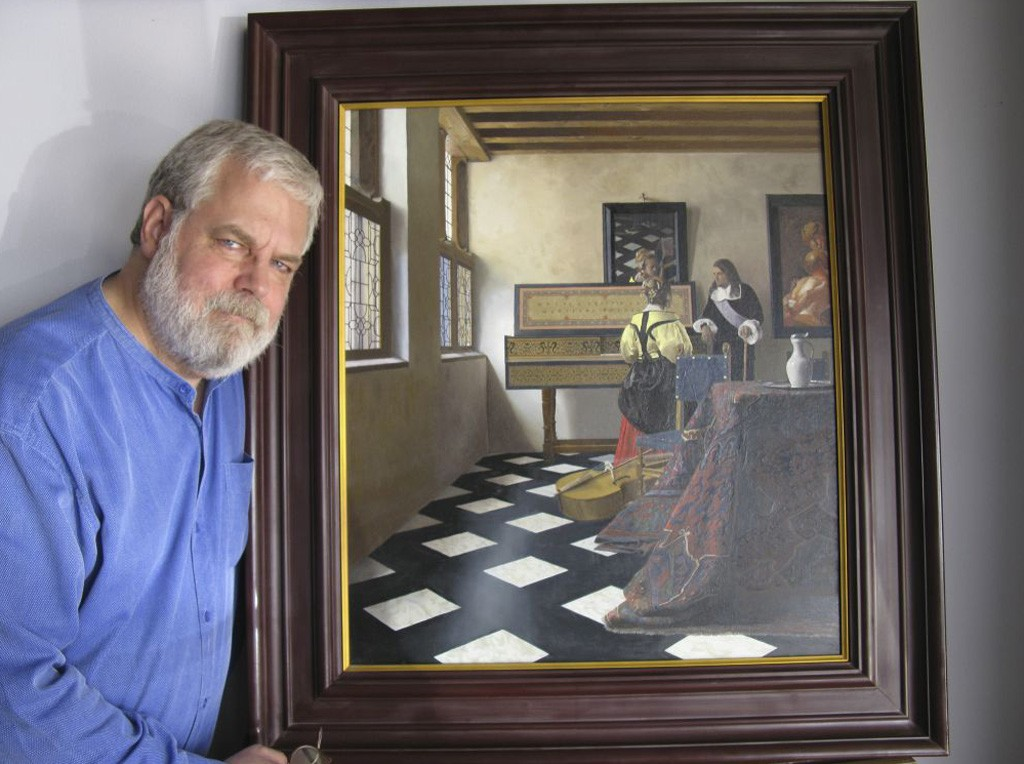
This month I'k simply using pencil and paper
While technology-aided art yet should probably count as art (in some capacity), this month, I'm committed to creating using merely the tools shown below: 9 black pencils, 1 white pencil, a few different erasers, and a greyness piece of paper (which I'll explain another fourth dimension).
It's going to be hard, but that's the point.
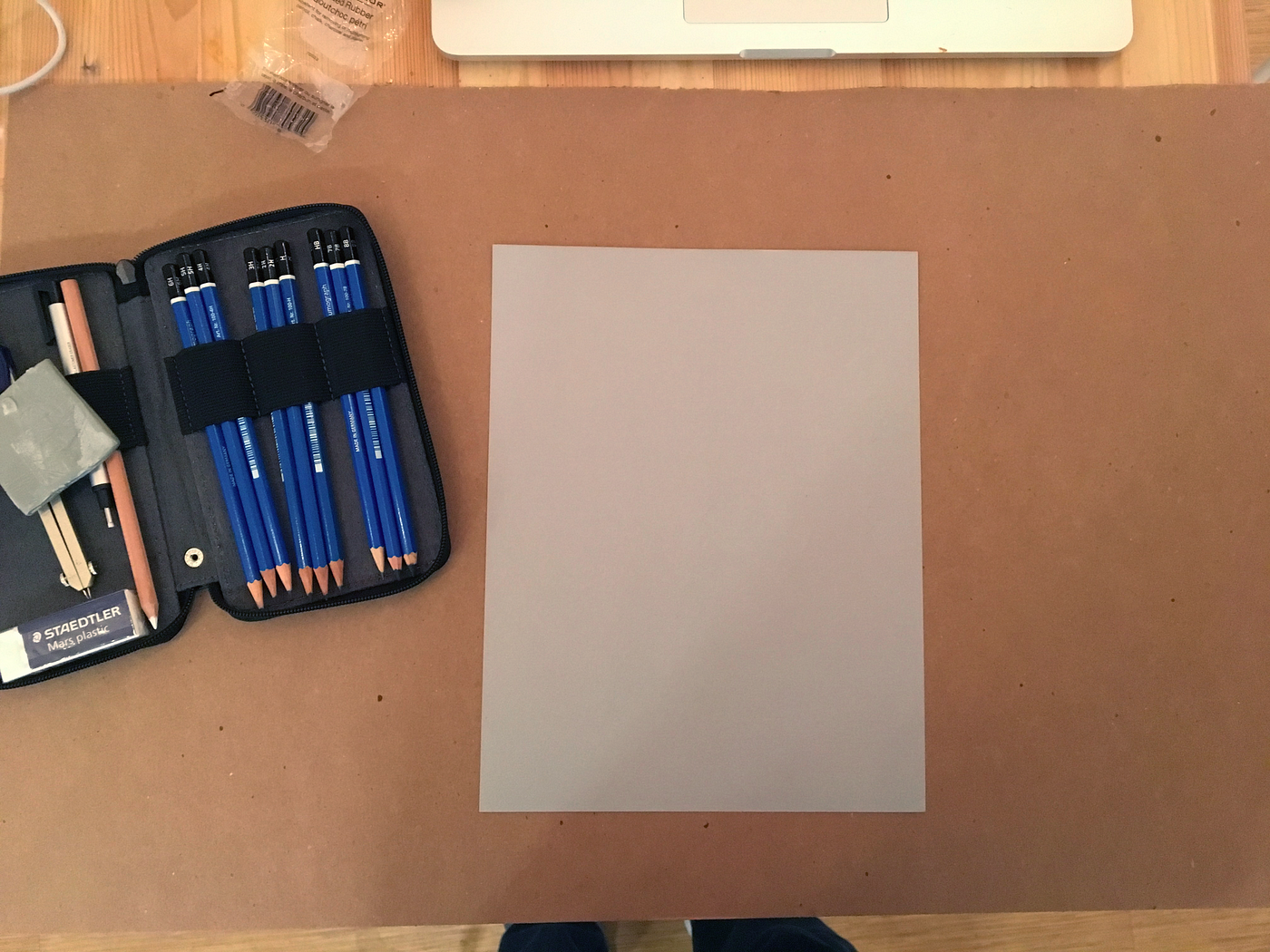

This month, to larn how to depict portraits, I'll be following the Portrait Drawing video grade from Vitruvian Studio.
Today, I spent 2.5 hours starting the course and starting time my start portrait.
Selecting who to draw
For my first piece, rather than cartoon the model from the form, I've chosen to draw Derren Chocolate-brown, who originally inspired me to pursuit portrait drawing.
Derren is a British illusionist, who I've been following for a while now, and who, I recently learned, casually paints portraits on the side.
Here are a few things he's casually painted.

Later on seeing these, I decided I also would like to be the kind of person that casually paints impressively good portraits on the side.
For now, before I get to the painting, I'll start off by mastering the drawing part of program.
This is the picture of Derren I'm drawing.
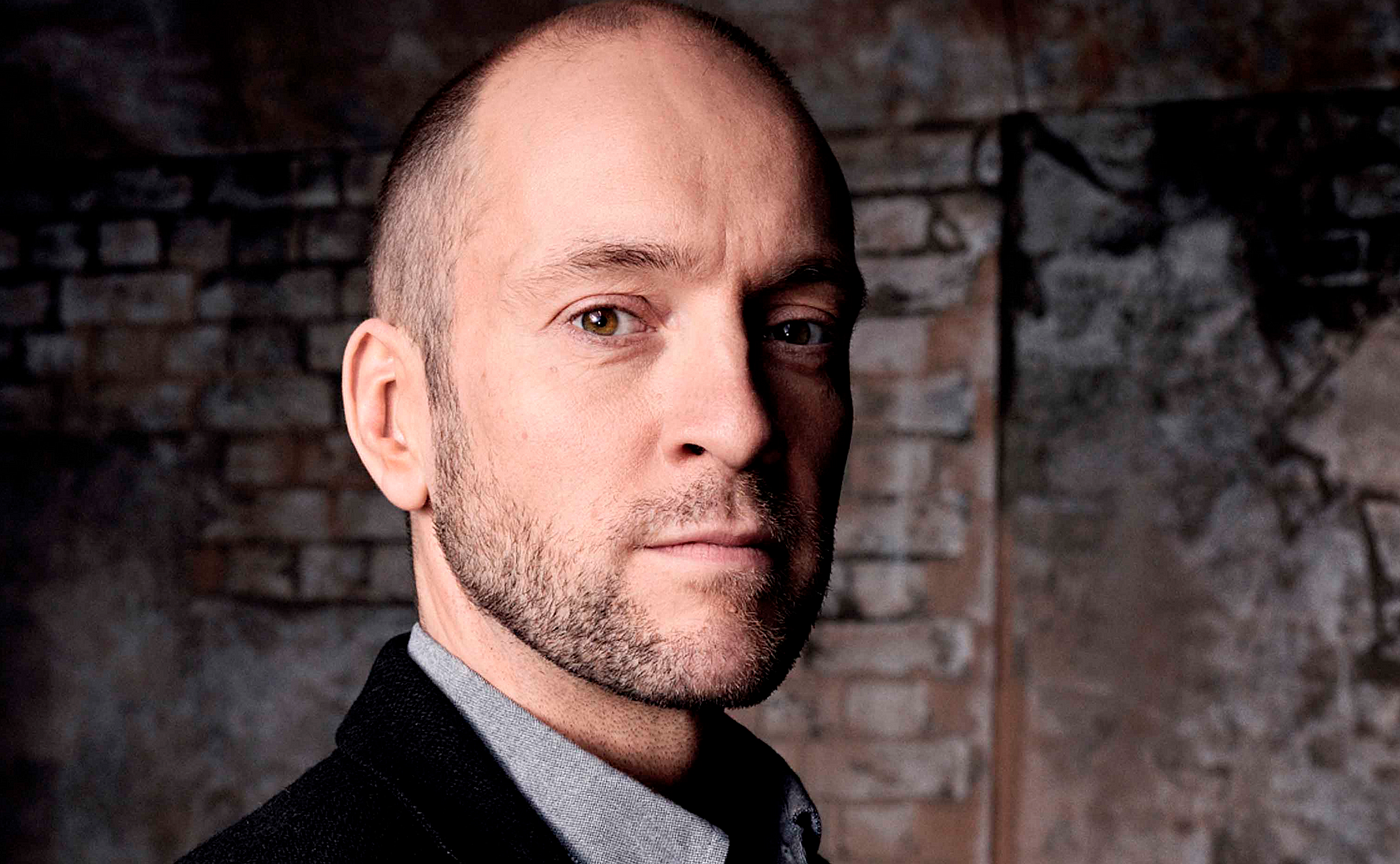
And hither's my setup.
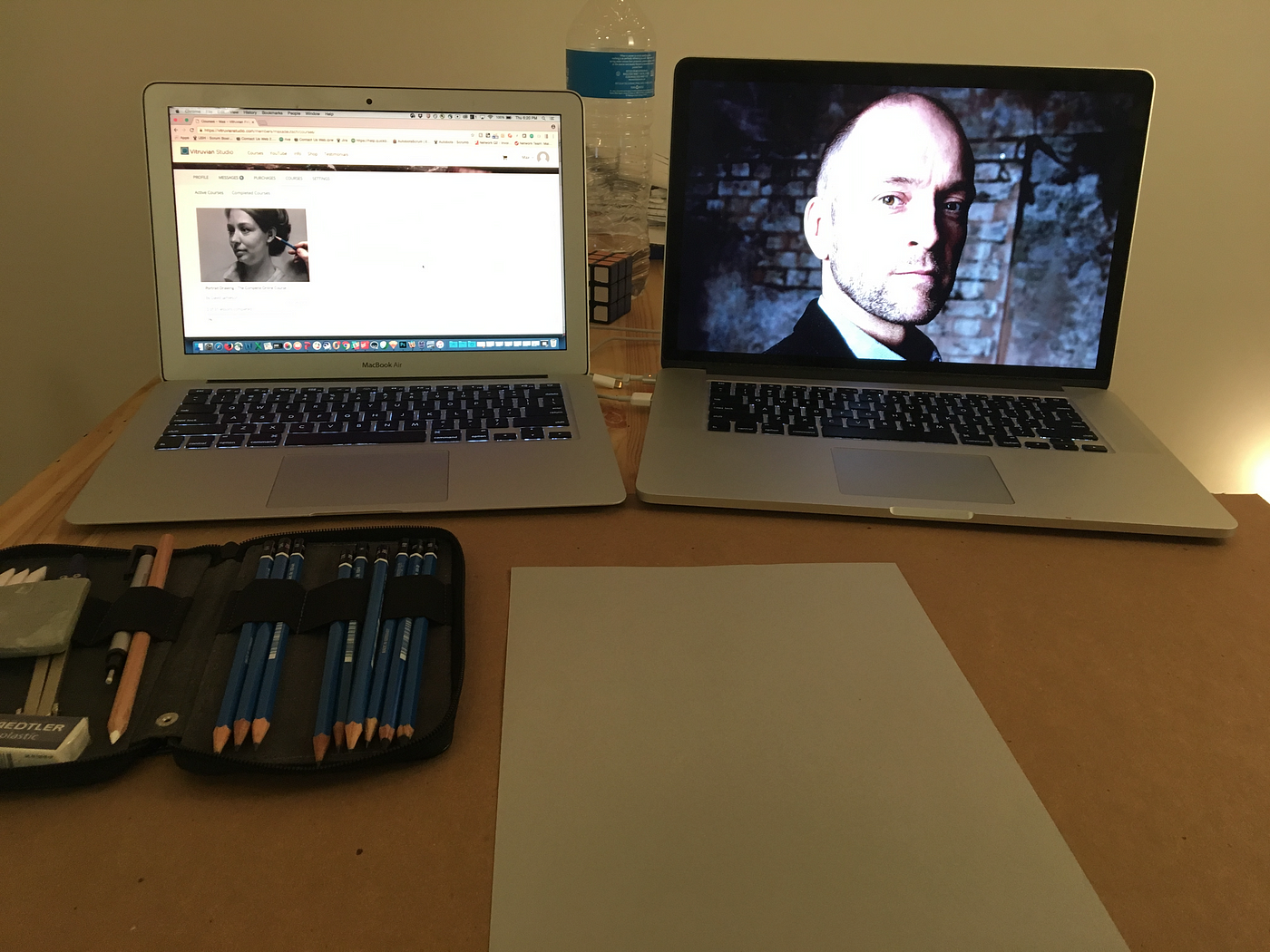
Starting the cartoon
The first module of the grade focuses on mapping out the portrait, which includes determining the shape of the head and locating the features.
Finding the top and bottom of the caput
I started by arbitrarily drawing 2 lines on the page to indicate the level of the top of the head and the level of the bottom of the caput.
Then, I arbitrarily marked, on the acme level, the highest indicate of the head, and and then used the bending between this bespeak and the bottom of the chin, to locate the bottom of the mentum on the page.

I also drew in the level of the notch of the cervix. The offset time, I drew it too low, so I moved it upward. I gauged this distances as a proposition of the head length.

Observe the leftmost and rightmost parts of the caput
With the topmost and bottommost points identified, I then needed to identify the leftmost and rightmost points.
To do this, I used a new technique I learned called triangulation. To triangulate a new point, I offset sight (try to visualize) the angles to this new point from two existing points. Then, I describe lines from the existing points in the management of the new point based on the sighted angles. Finally, I mark the new bespeak where the lines intersect.
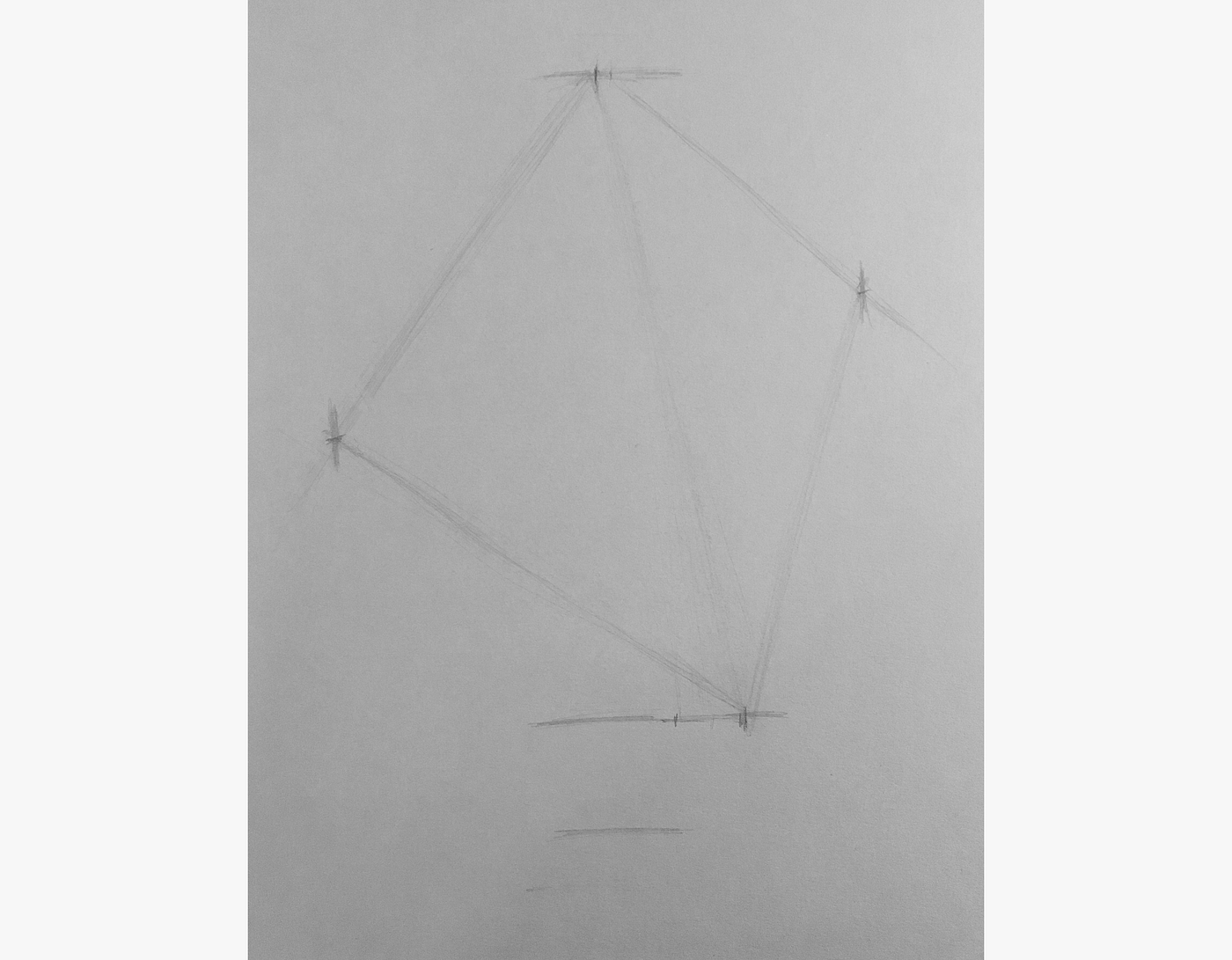
Afterwards checking the angles once again, I updated these two new points.

To cheque, I then sighted the angle betwixt the two new points, ensuring this angle matches what I see on Derren's head.

Drawing the shape of the caput
With these iv outer points drawn, the adjacent step is to describe in the shape of the head. To do this, I continued to triangulate more points, and draw in the necessary curves to connect them.

I continued in this style, until I outlined the entire shape of the head.
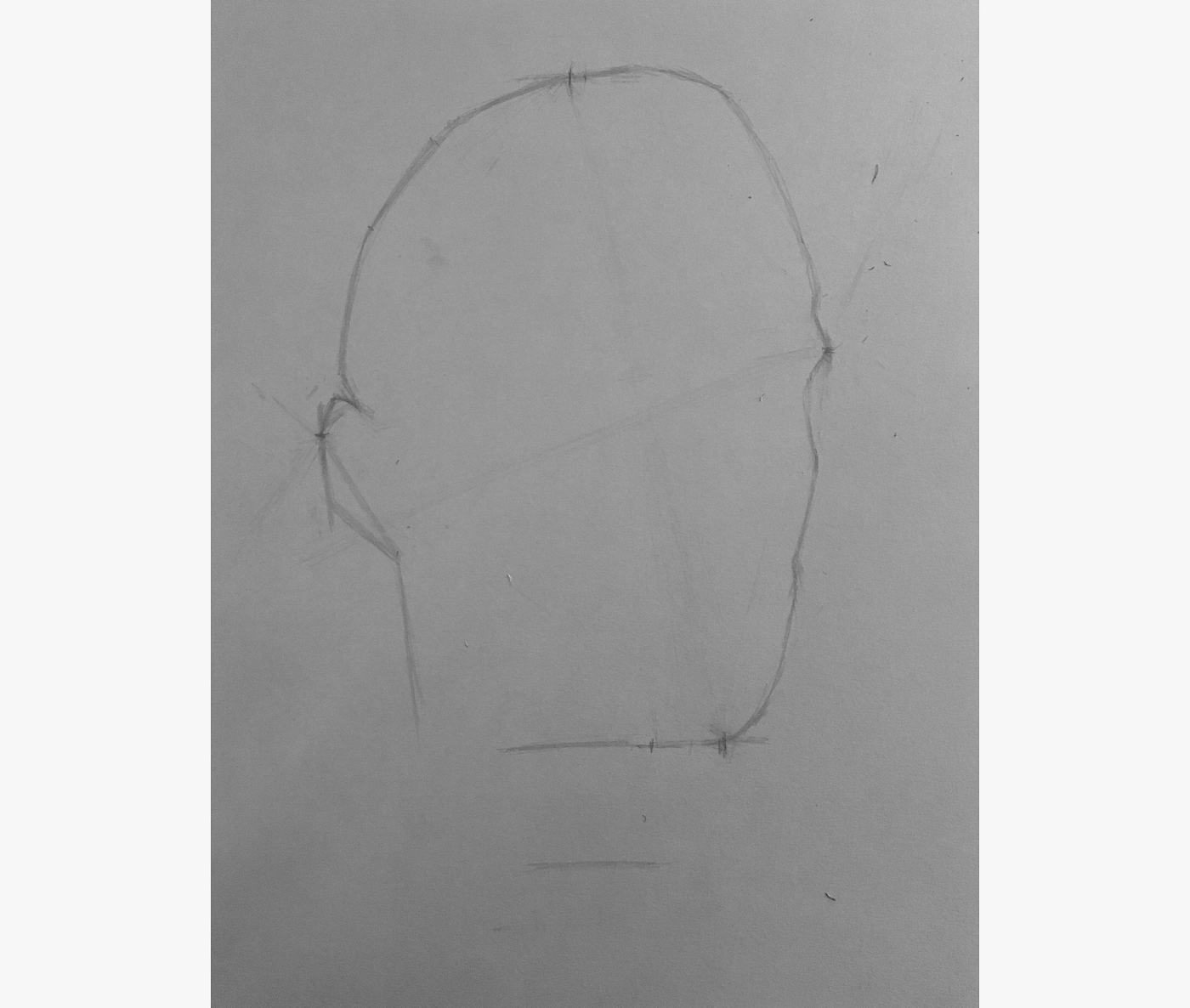
It didn't look quite right, so I checked a bunch of angles.
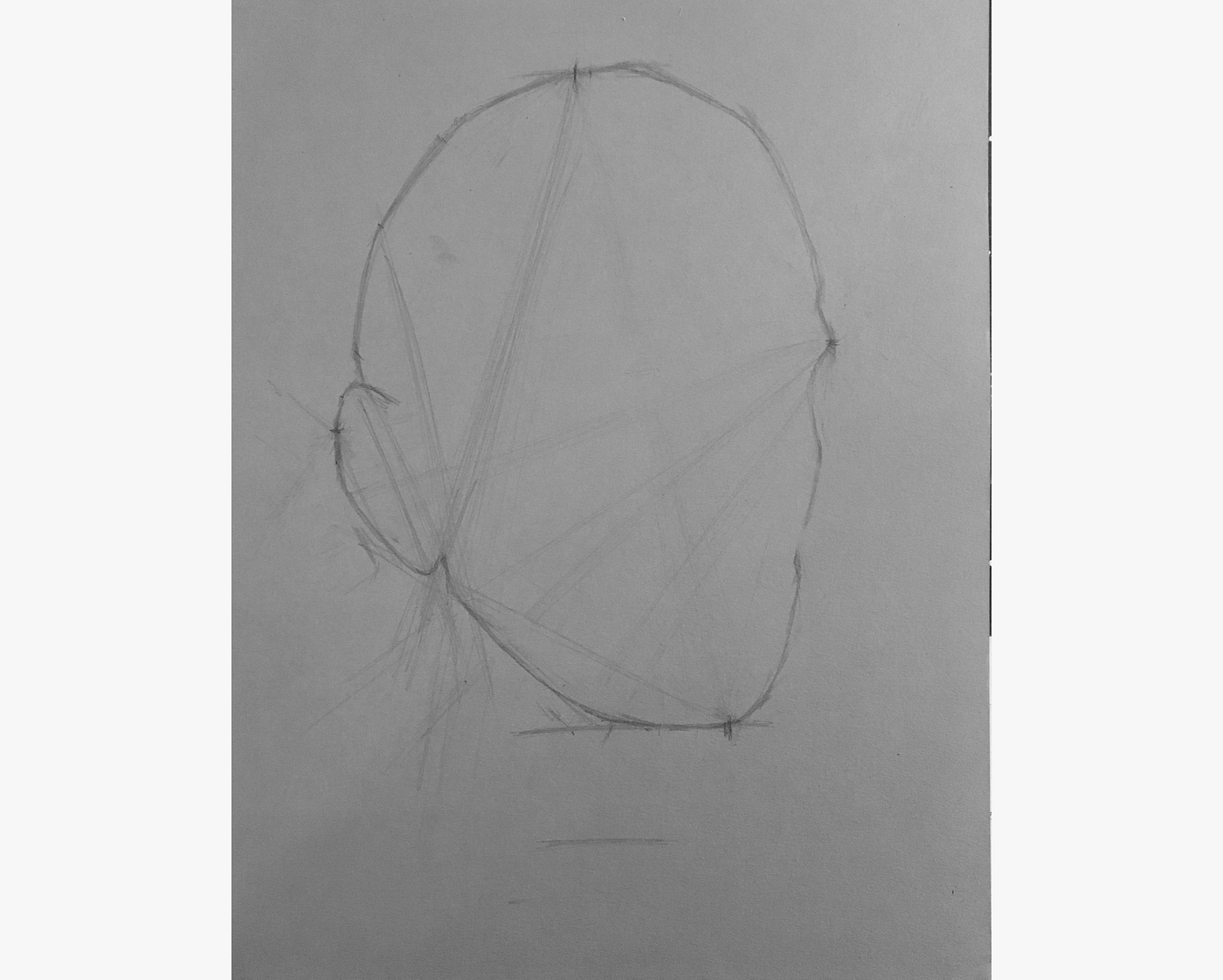
Once it seemed closer, I added in the neck and shoulders.
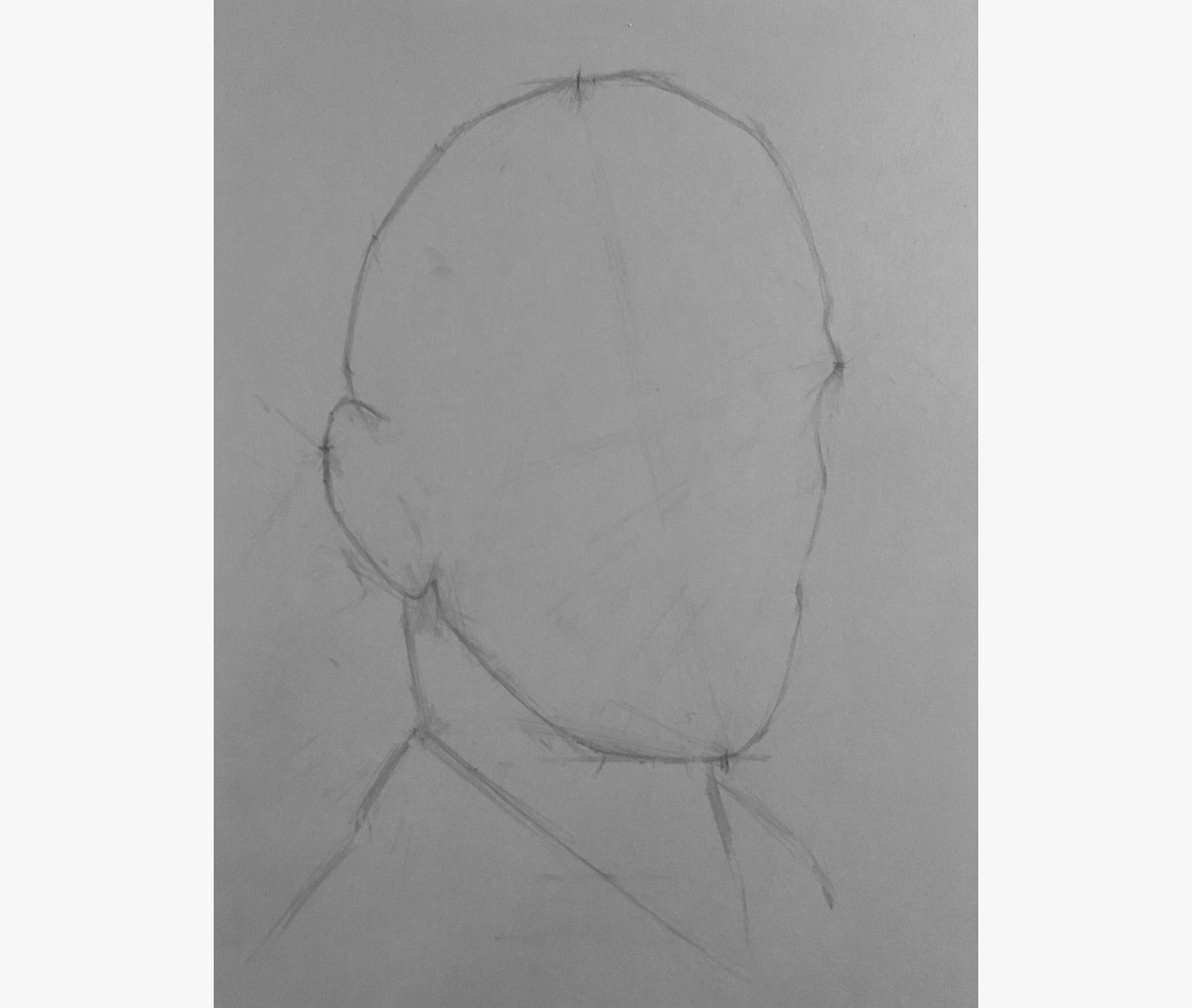
With the cervix and shoulders in place, it once again didn't look correct. And so, I checked more angles and made adjustments equally necessary (mostly to broaden the jaw)

The head was now looking pretty skillful, but the cervix and shoulders needed a few adjustments. I retriangulated, and adjusted the collar up.
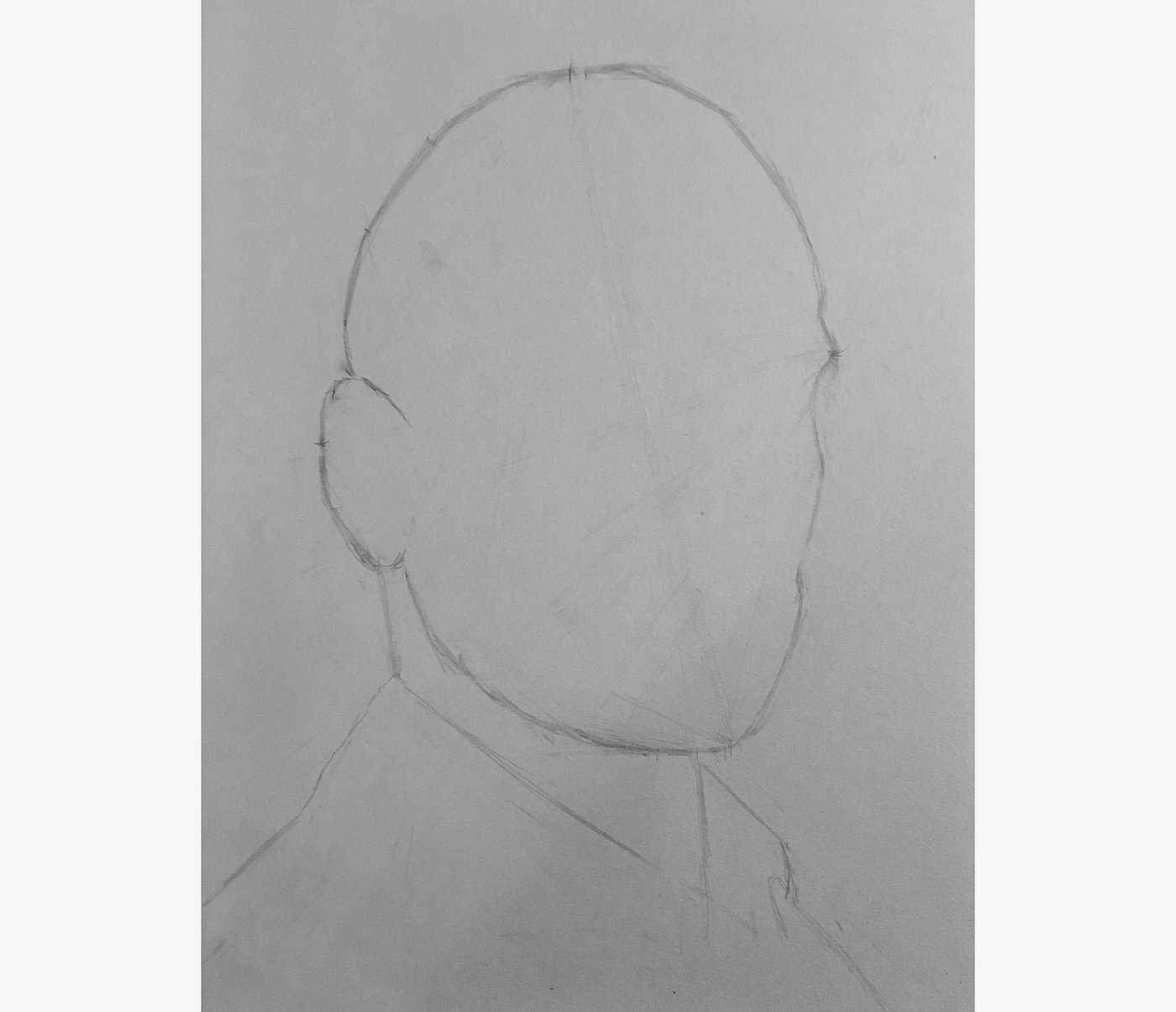
That's information technology for today
Getting to this bespeak took me 2.5 hours, which was split between watching the video form and drawing my Derren portrait.
So far, the portrait doesn't await like much, only I still learned a bunch today. I particularly similar the triangulation technique, which makes cartoon much more procedural and mathematical (a.k.a. easier for me).
Tomorrow, I'll continue following the course, and offset drawing in the facial features.

Yesterday, I started post-obit along with the Vitruvian Studio portrait course, and began drawing a portrait of Derren Brownish.
Hither'south what I achieved yesterday.
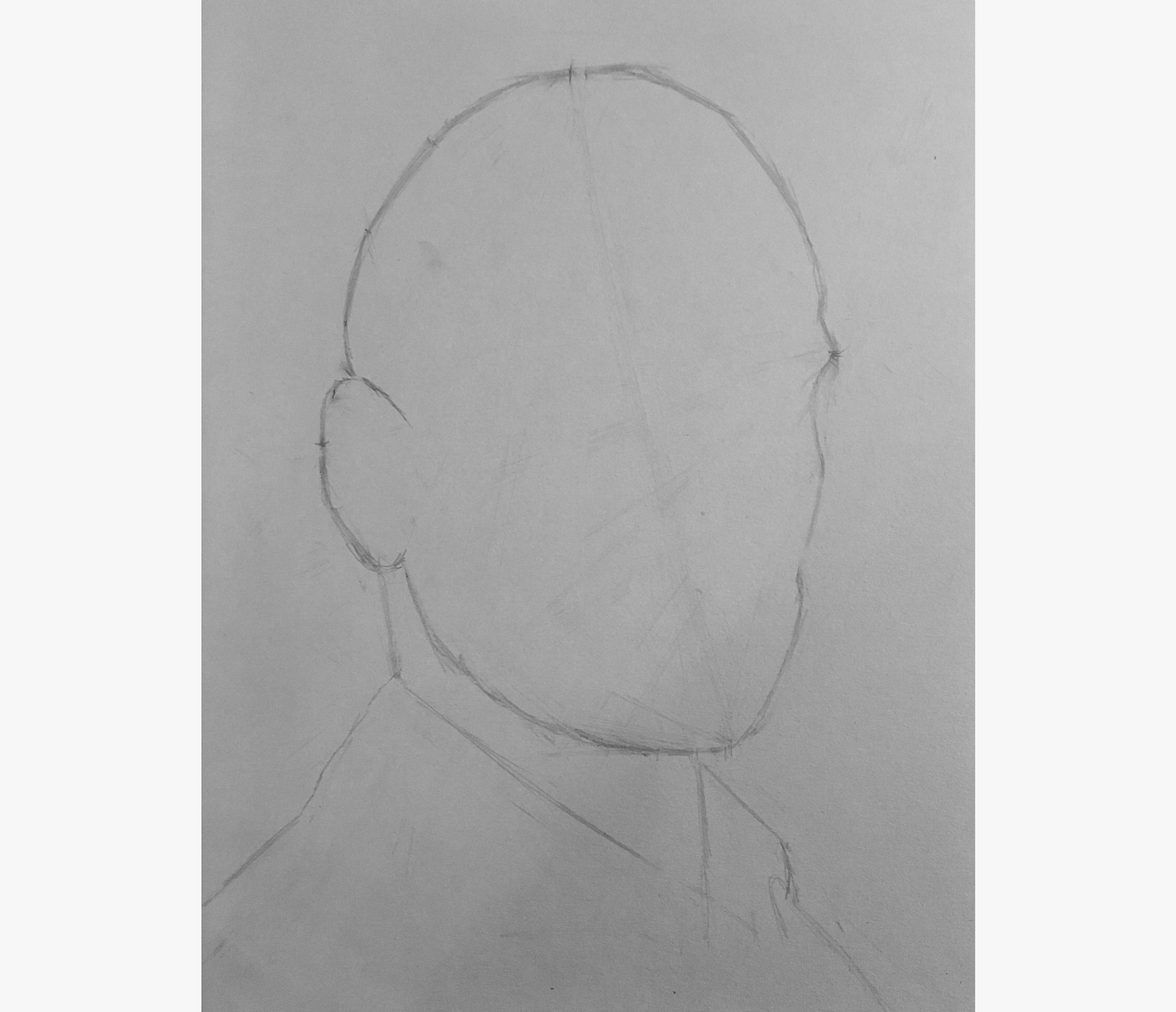
And here'due south my finish goal (more than or less).
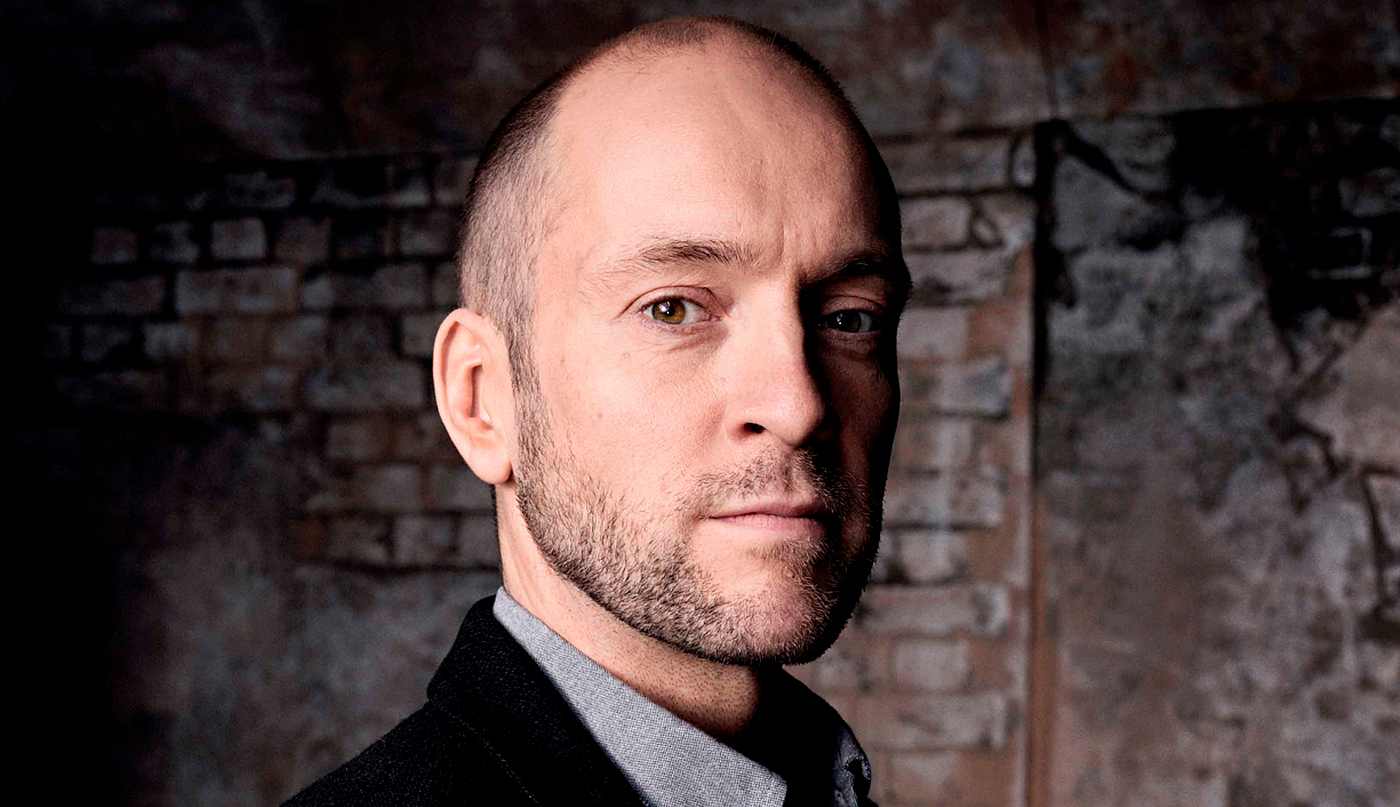
Today, I spent another two.five hours watching the course and working on the portrait.
Today's progress
Drawing in guides
The first thing I did today was add construction lines to my cartoon. These construction lines are designed to act as landmarks and help me eventually place the facial features.
Showtime, I drew in the vertical center line, which volition help me laterally identify the features.
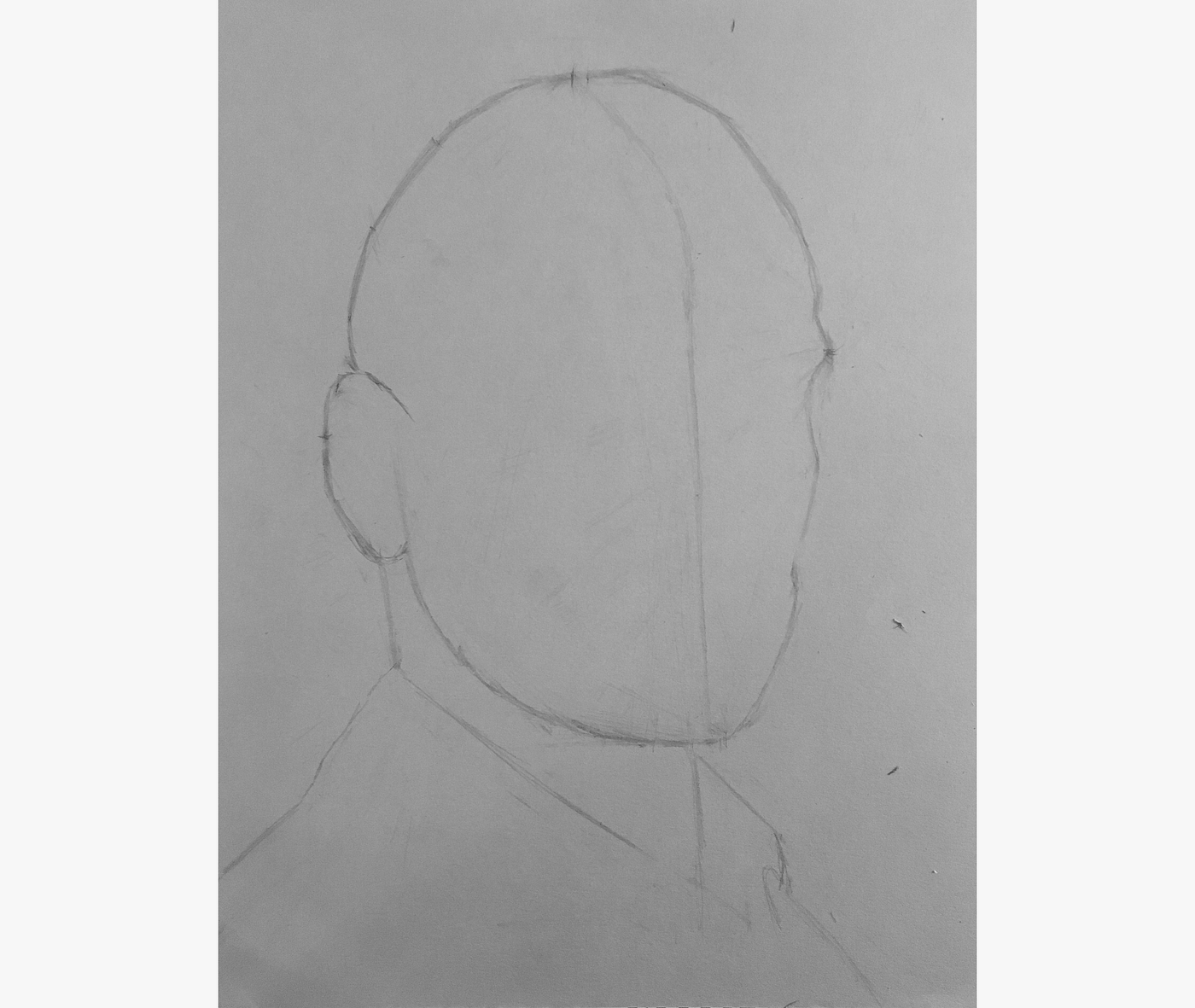
Then, I marked centre level, to showtime gauging the features' vertical placement.
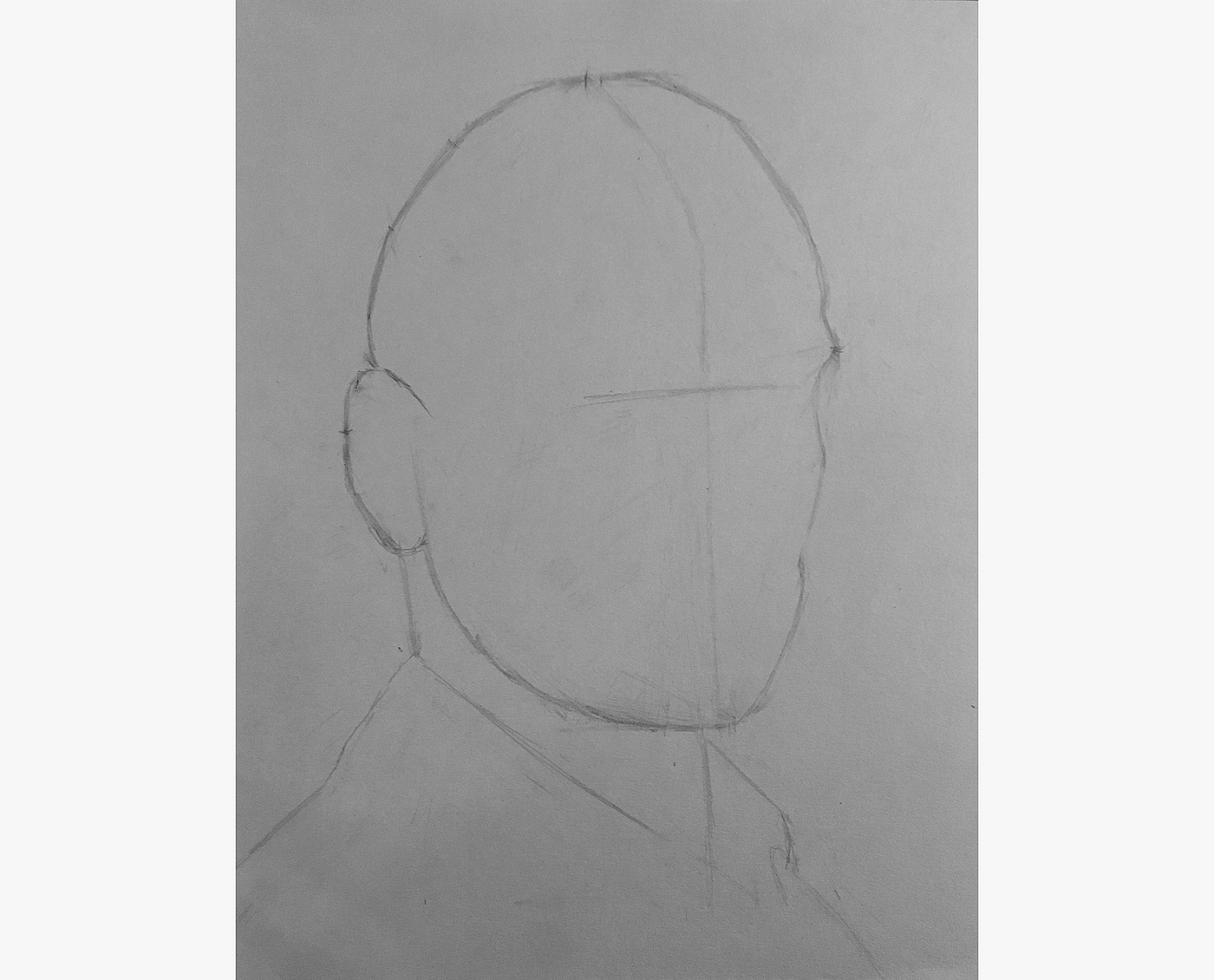
I followed upwards with the levels of the brows, nose, and lips.
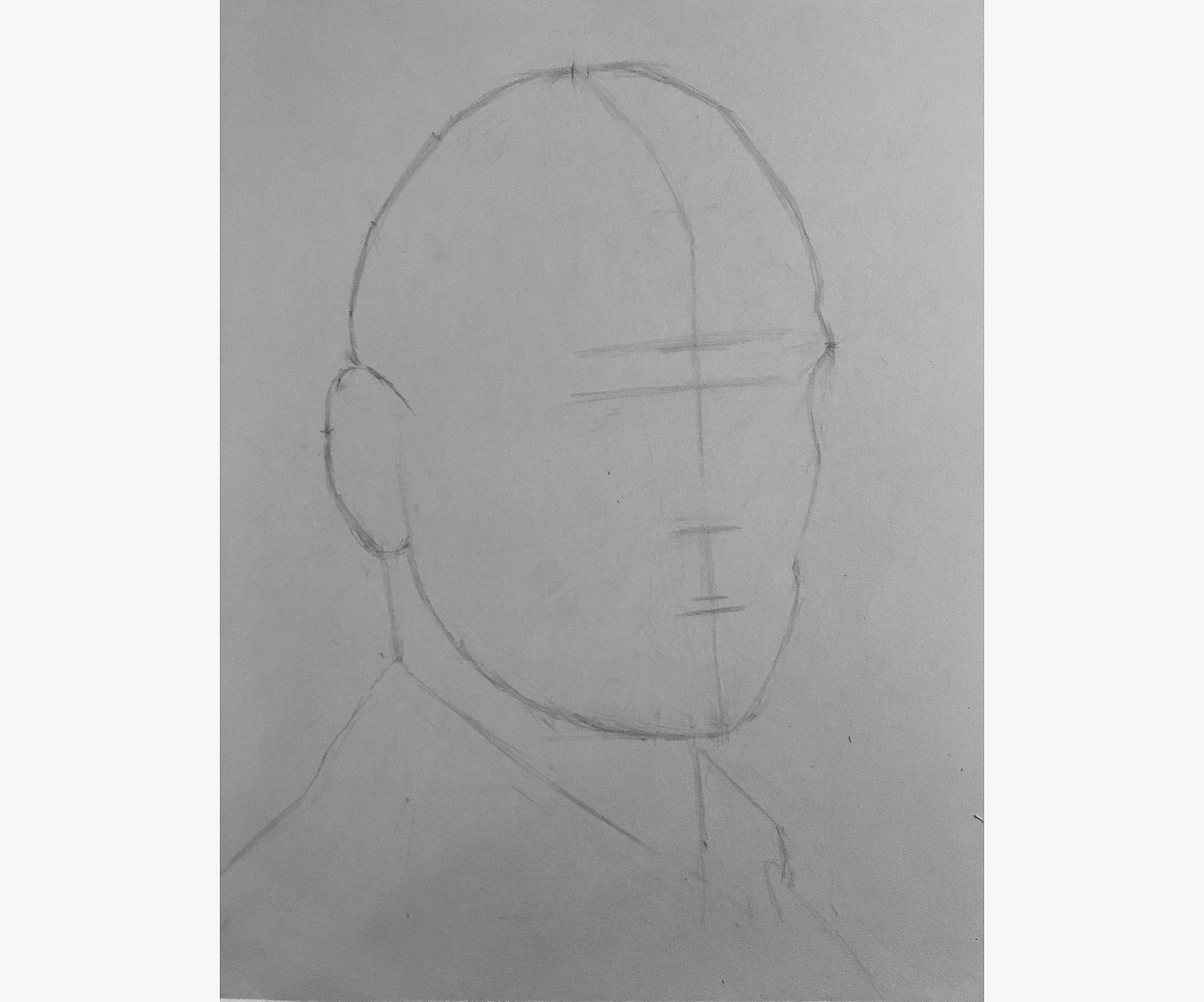
I made a scrap of a mistake here. I drew the horizontal construction lines perpendicular to the center line (which seemed reasonable), simply did not mimic the angle of the features in the actual drawing.
Then, I sighted the correct angles, and adjusted the structure lines accordingly.

Blocking in the features
With the structure lines equally references, I was then prepare to kickoff blocking in the facial features.
I started past adjusting the eye line slightly for the nose, and marking the nose'due south outer purlieus.
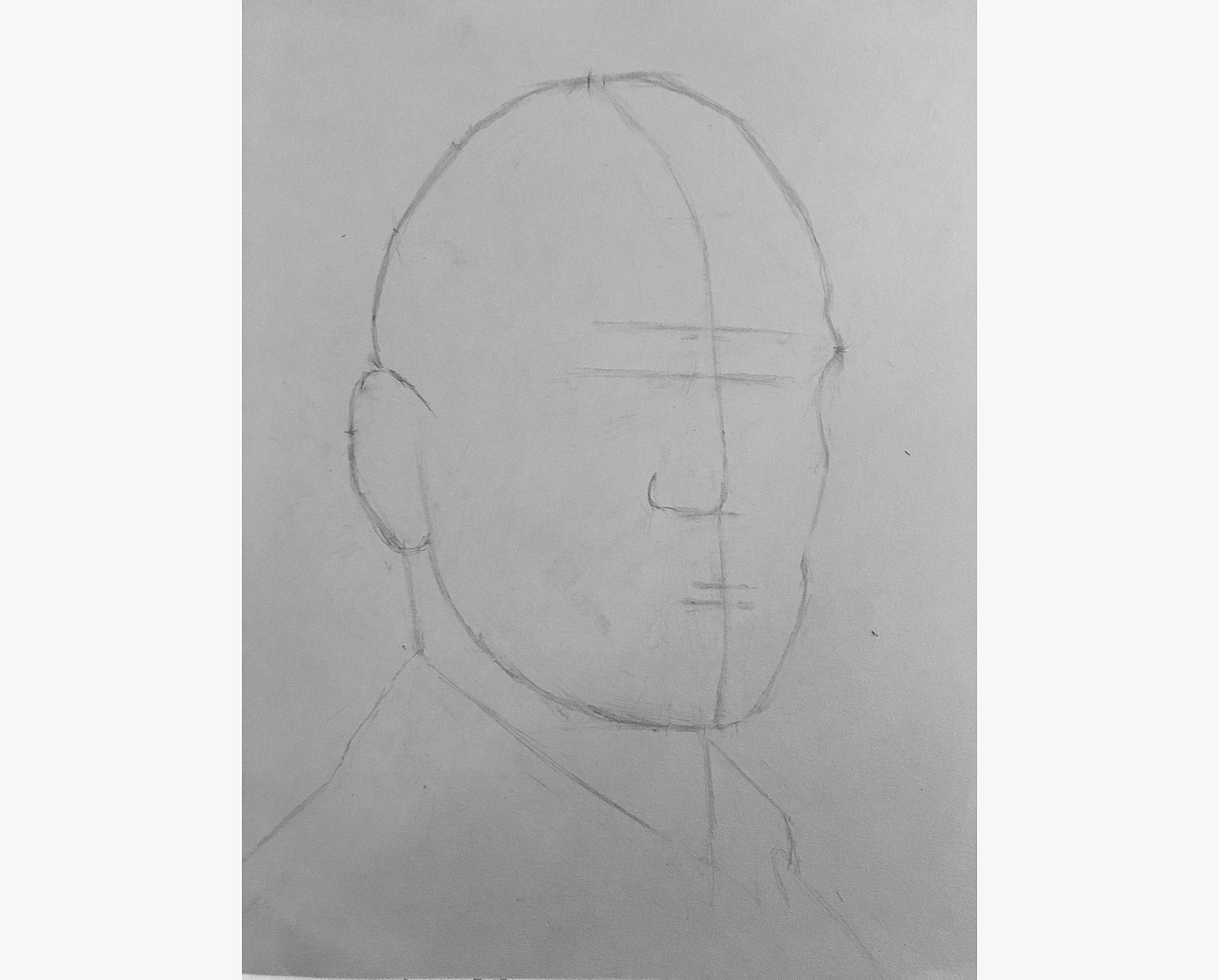
Then, I drew in shapes for the brows.
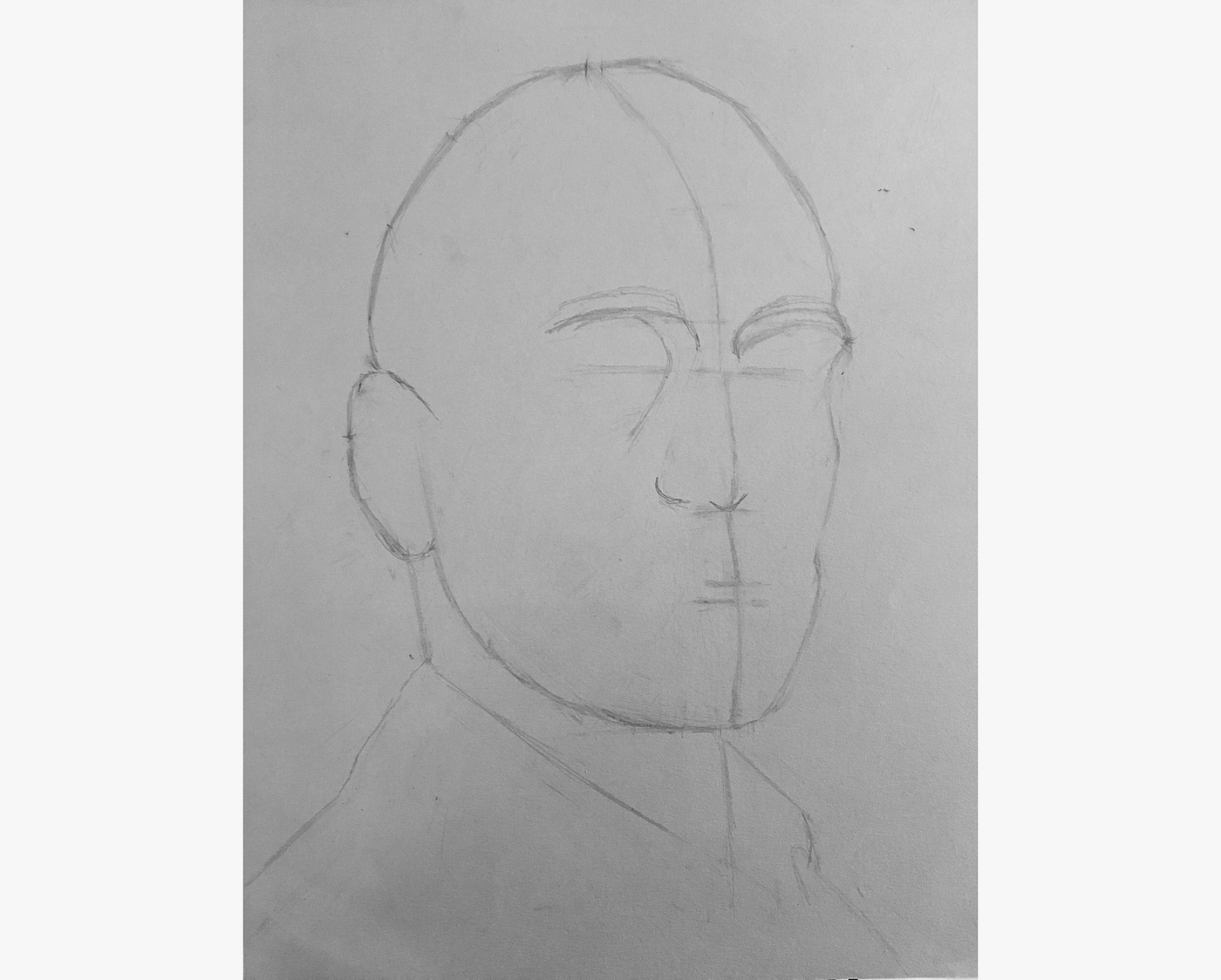
Next, I included the centre sockets and some more detail effectually the olfactory organ.
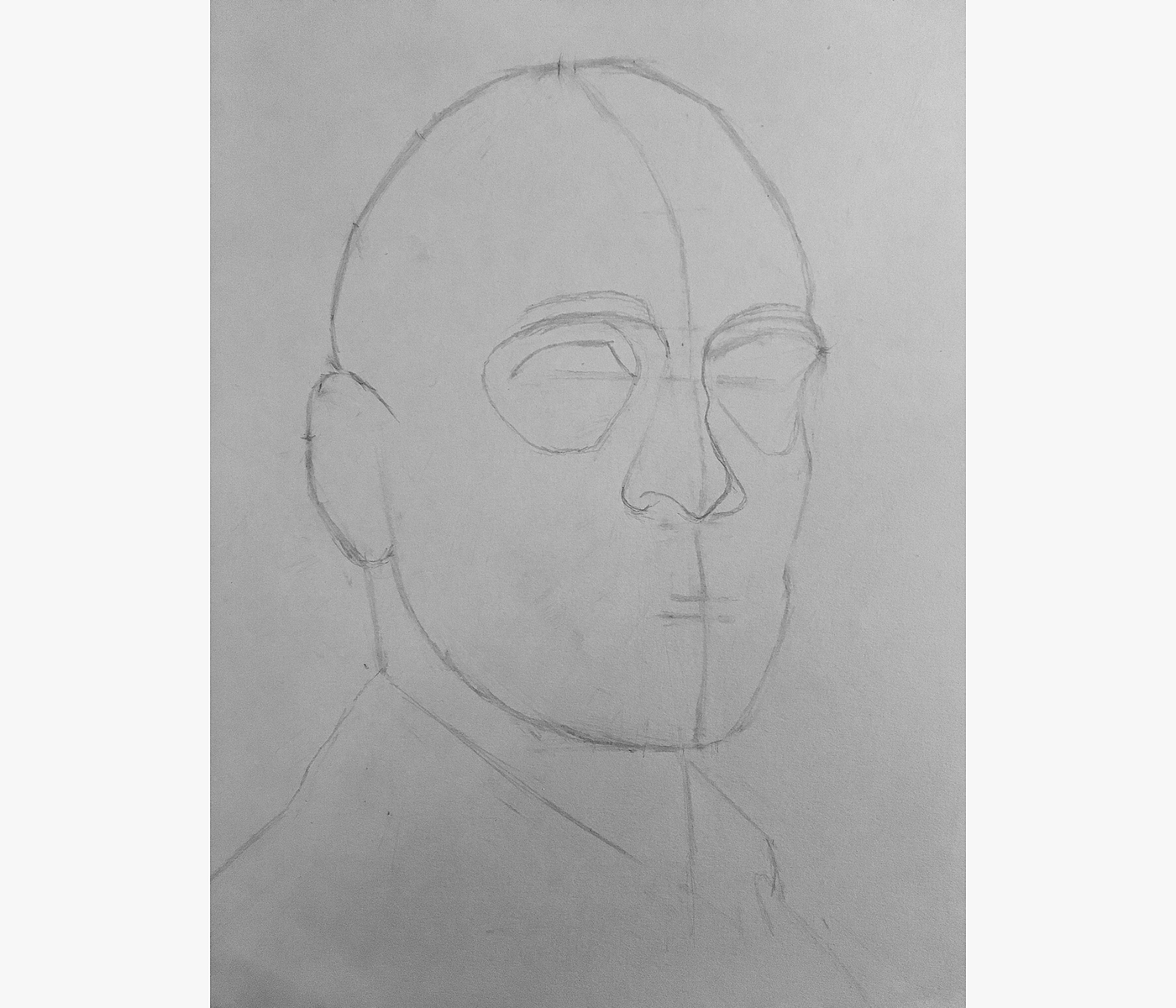
Finally, I added in shapes for the eyelids and eyes, and finished up for the twenty-four hour period.
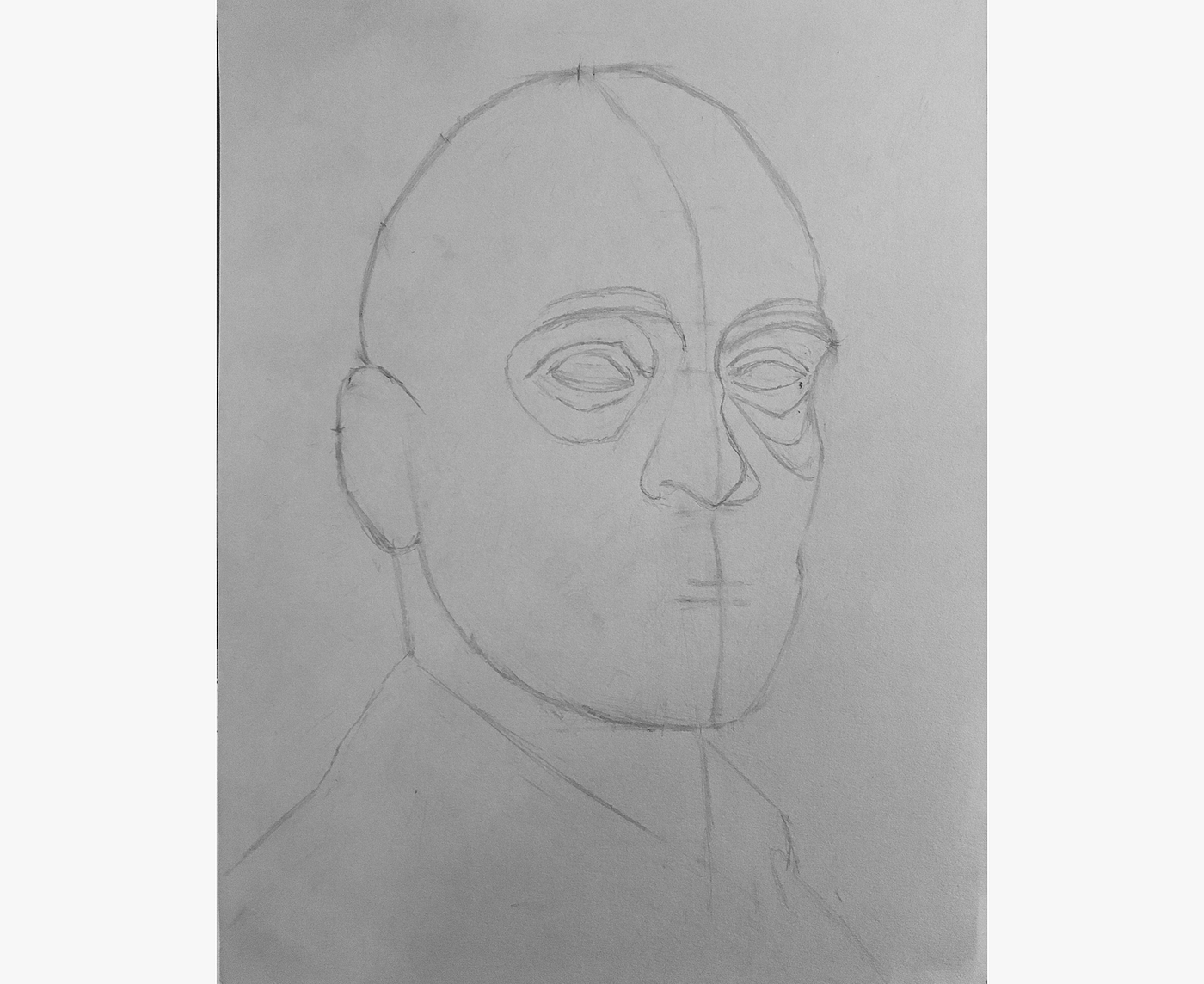
Reaching this signal took some other two.5 hours.
Progress nevertheless seems fairly ho-hum on the cartoon, but I'g making a conscious effort to work carefully through the blocking in phase (so I tin do what I'm learning, and and so I tin can ensure the portrait is built on a strong foundation).
I'll starting time detailing the features tomorrow.

Today, for the third mean solar day in a row, I spent 2.5 hours on my Derren Brown drawing. Withal, dissimilar the other days, today, I feel like I fabricated a lot of progress.
Terminate blocking in the features
Picking up where I left off, I continued to block in shapes for the features.

I added in the center line of the lips and the shadow on the olfactory organ.

I then finished the lips and added a line for the mentum.
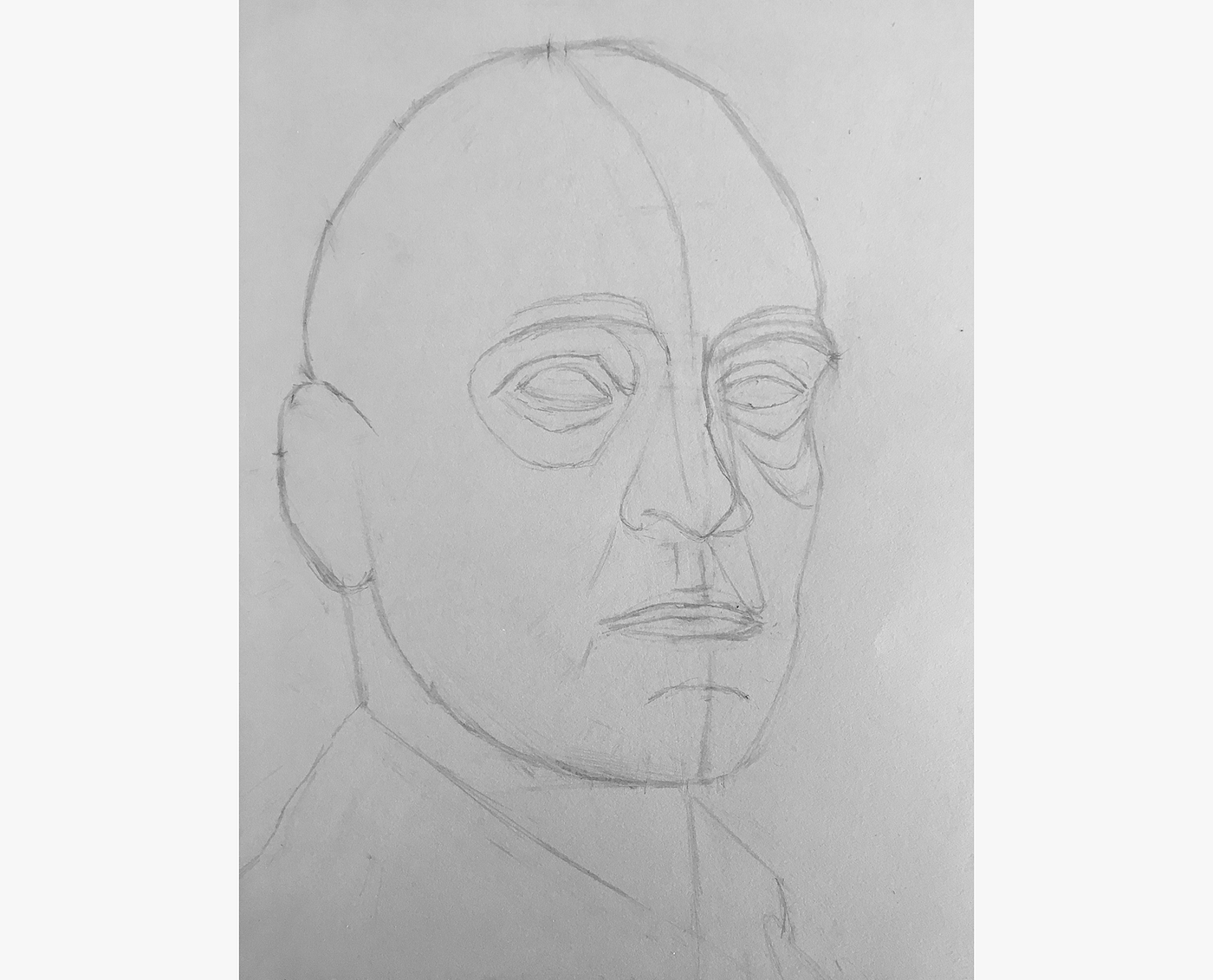
Lastly, I blocked in the chief structures of the ear and added an outline for the beard.
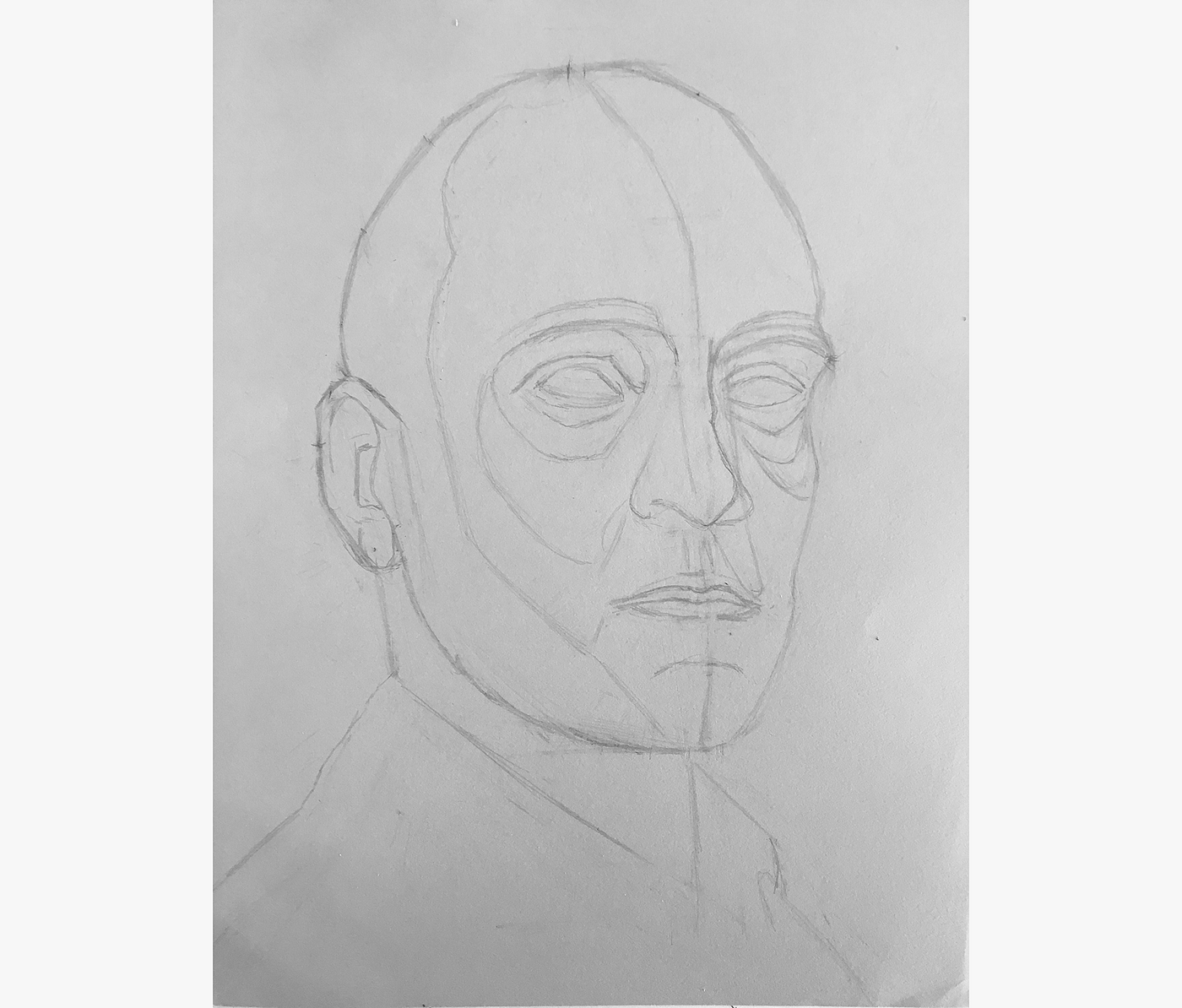
Cartoon in shadow/highlight shapes
With the features in place, I next blocked in shapes for the shadows and highlights.

With these tonal contours in identify, I darkened the shadow areas slightly, giving the portrait some roundness and iii-dimensionality.
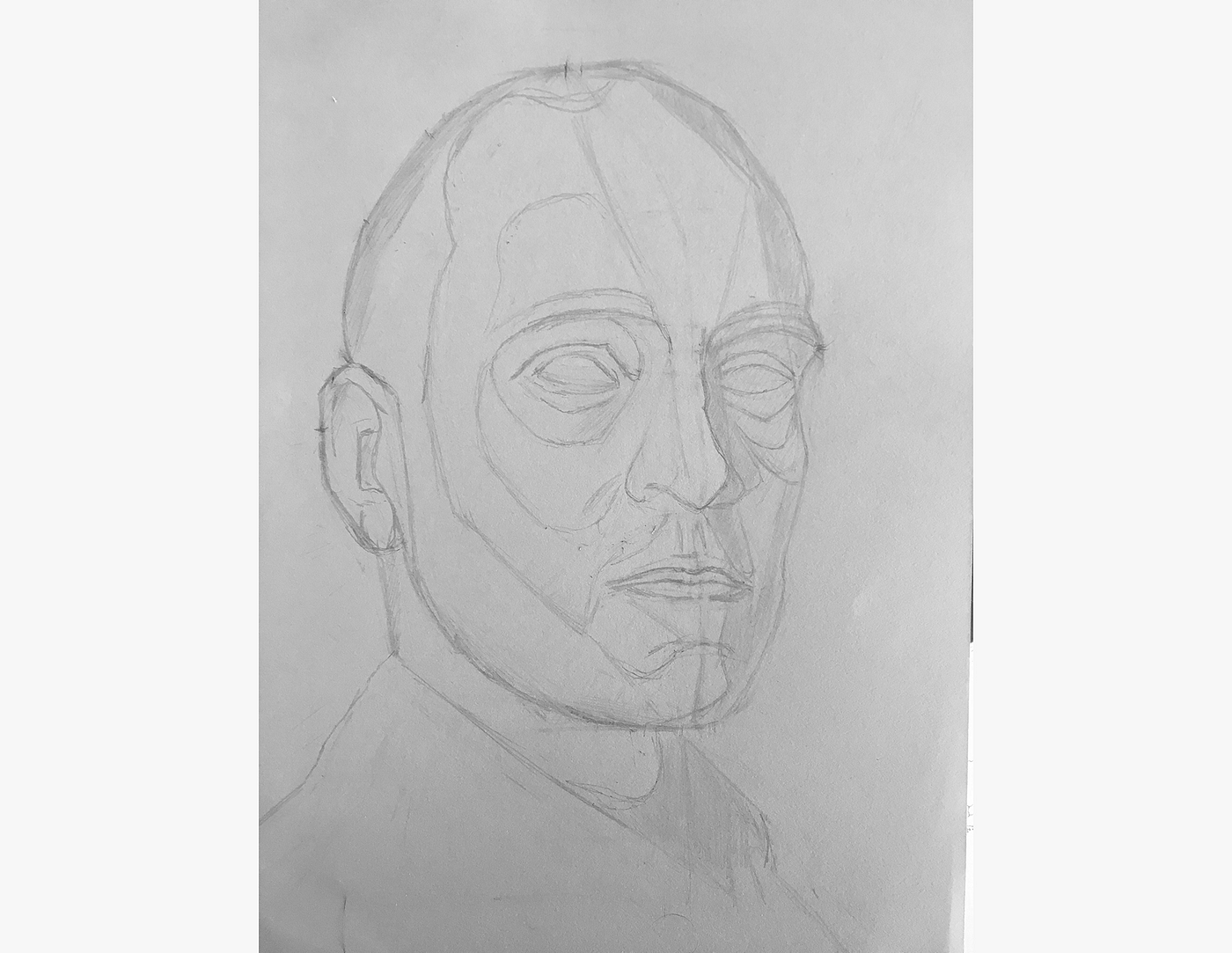
Detailing features
With the features and shadows blocked in, I detailed the features, starting with the eyes.
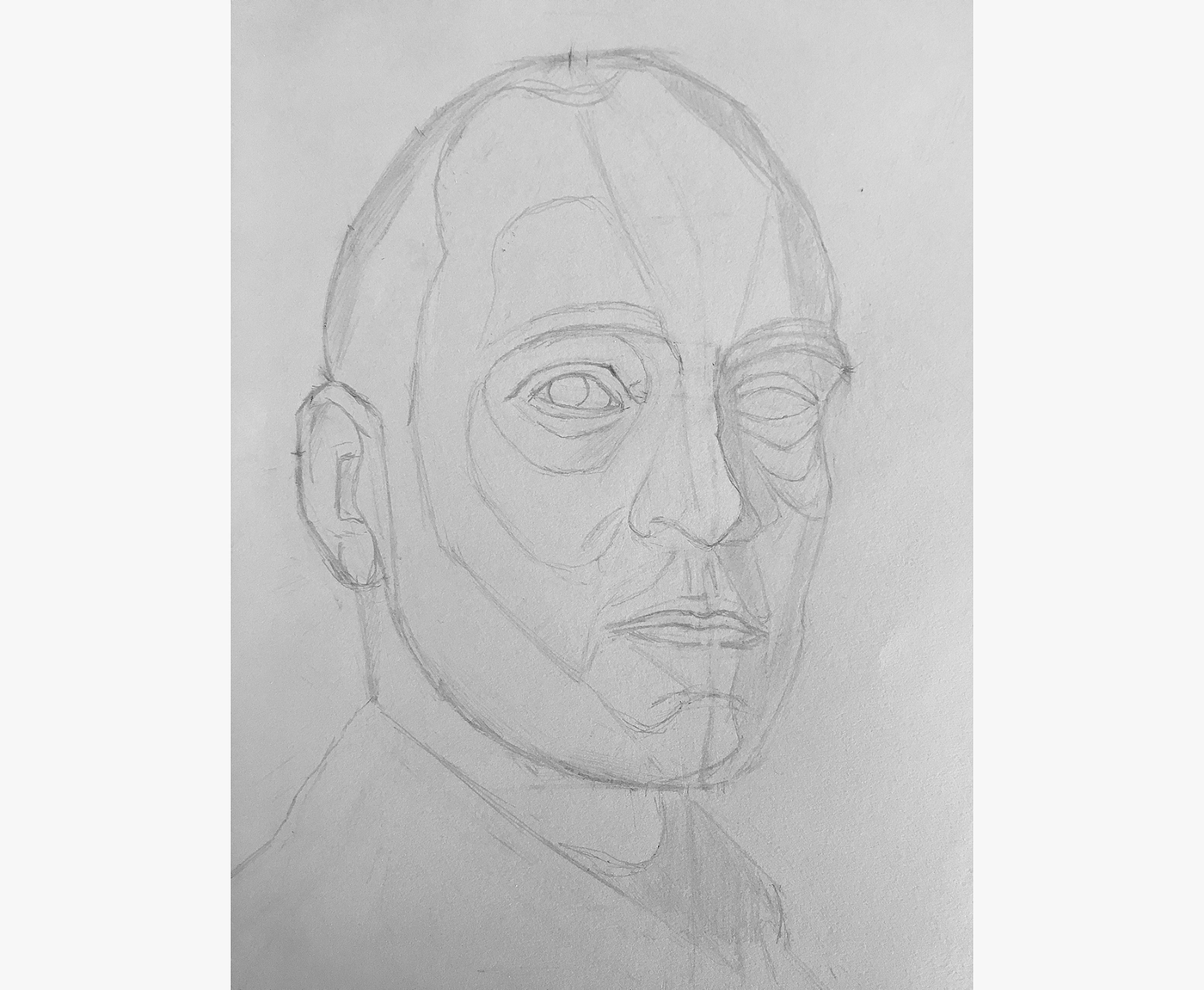
Left heart done.
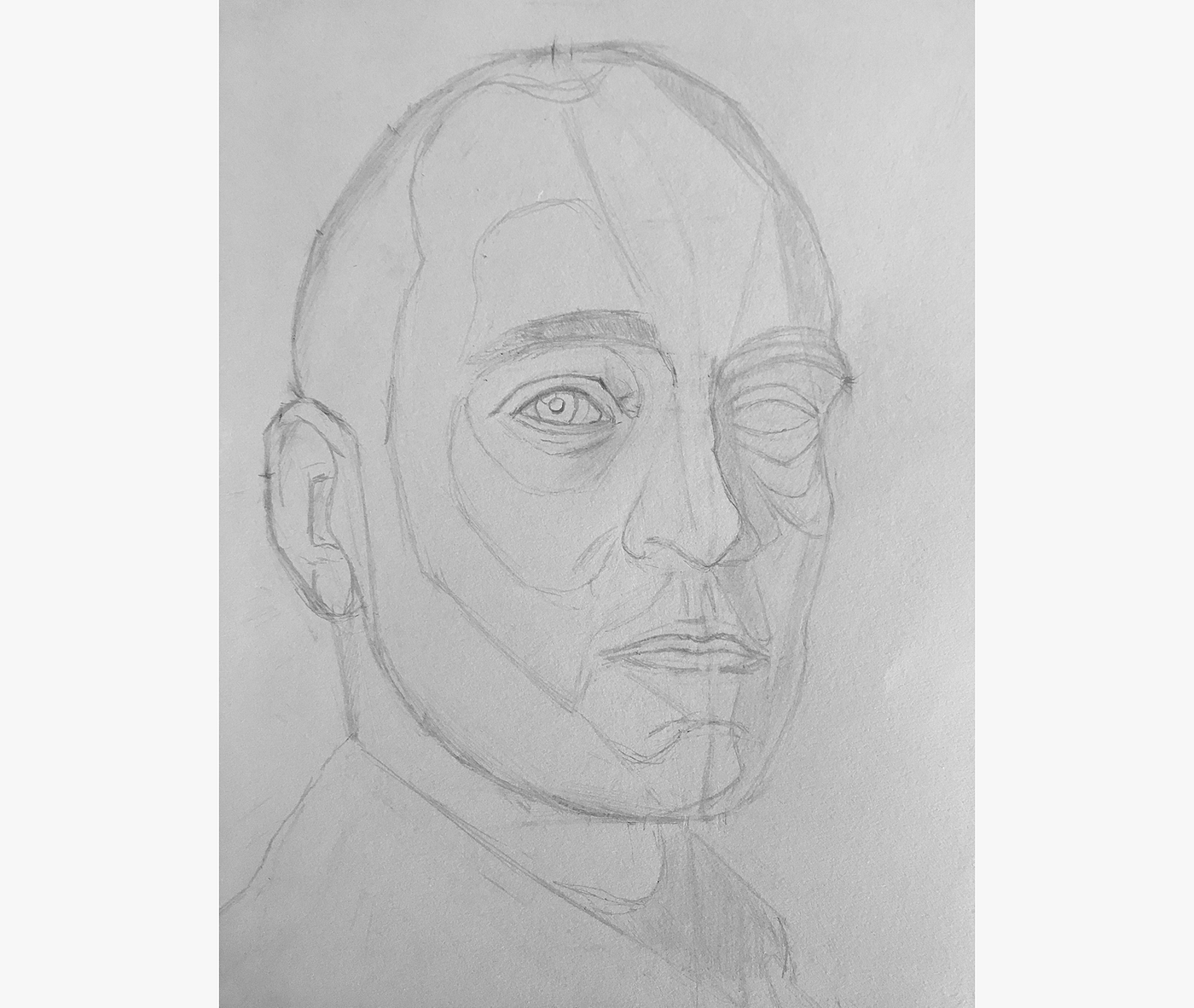
Right eye done.
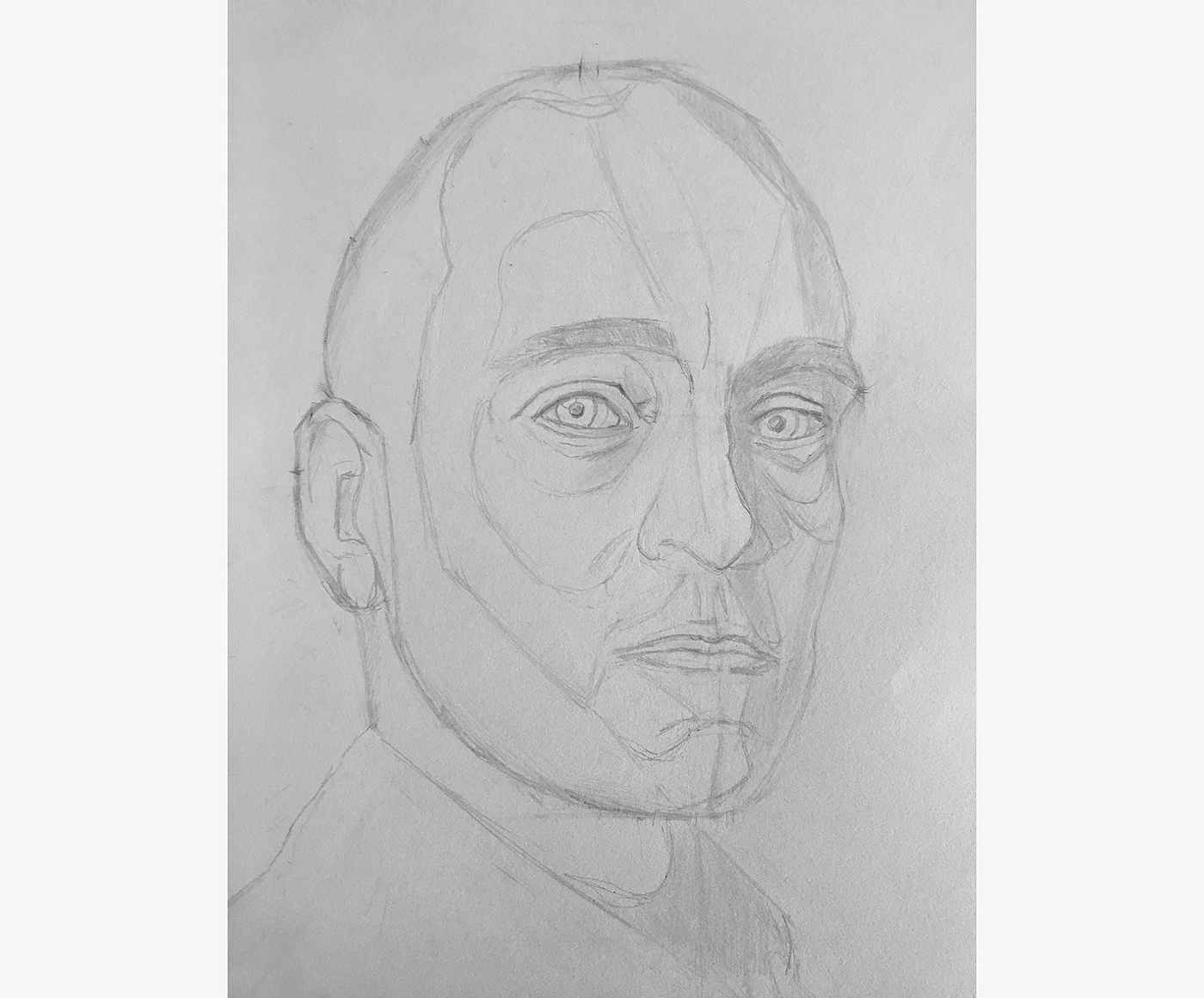
Nose washed.
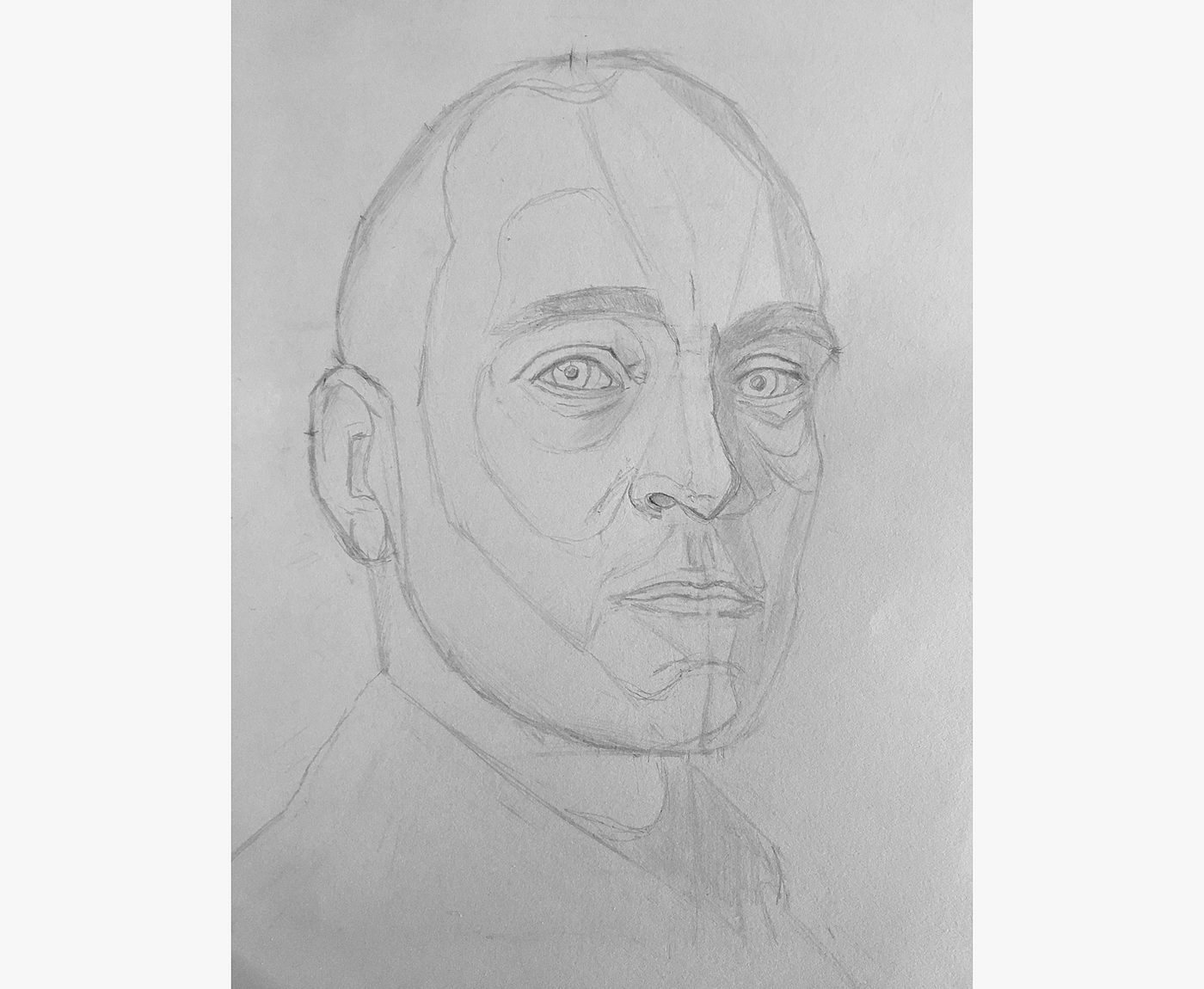
Lips washed.
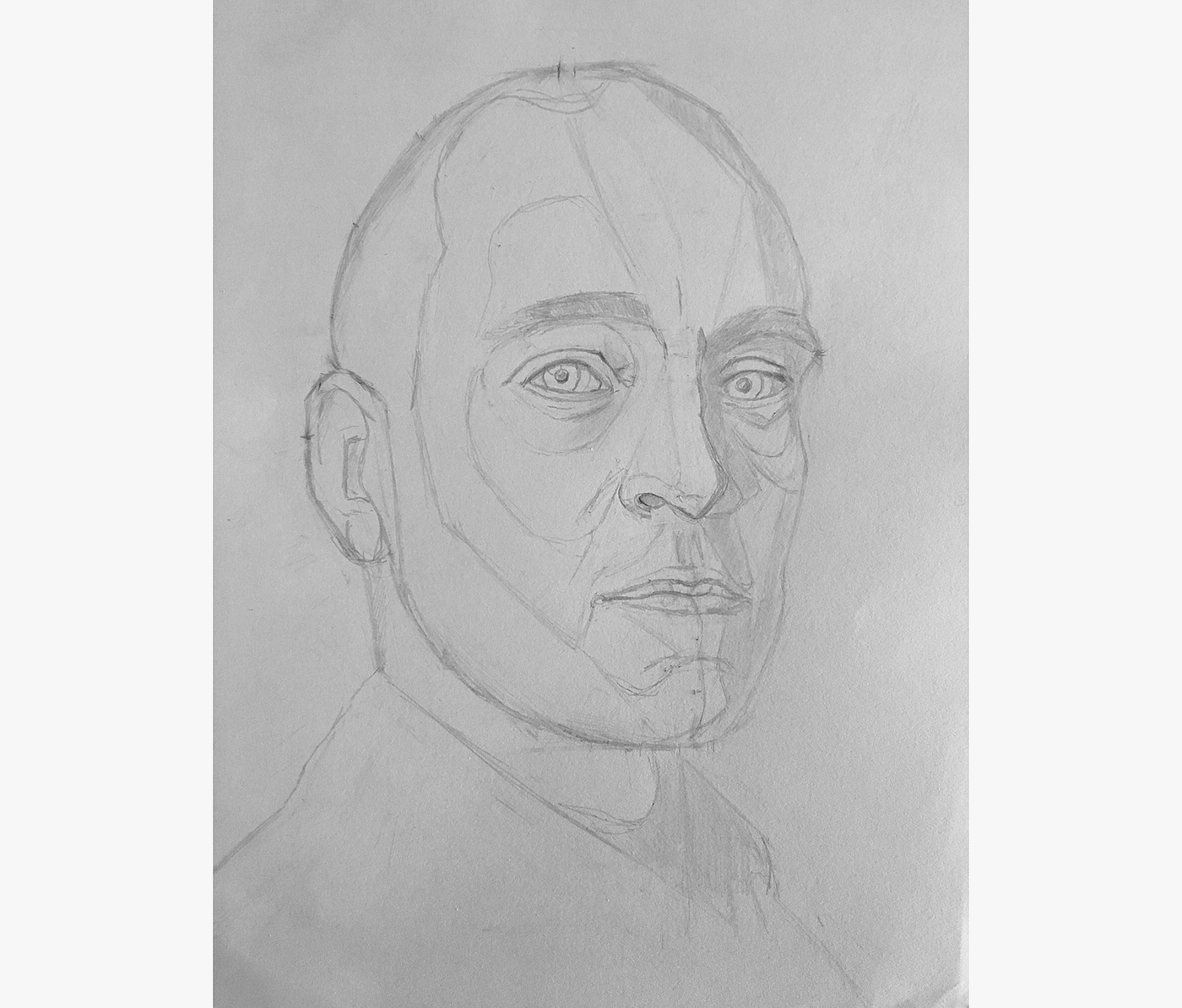
Finally, I finished up for the day with the ear.
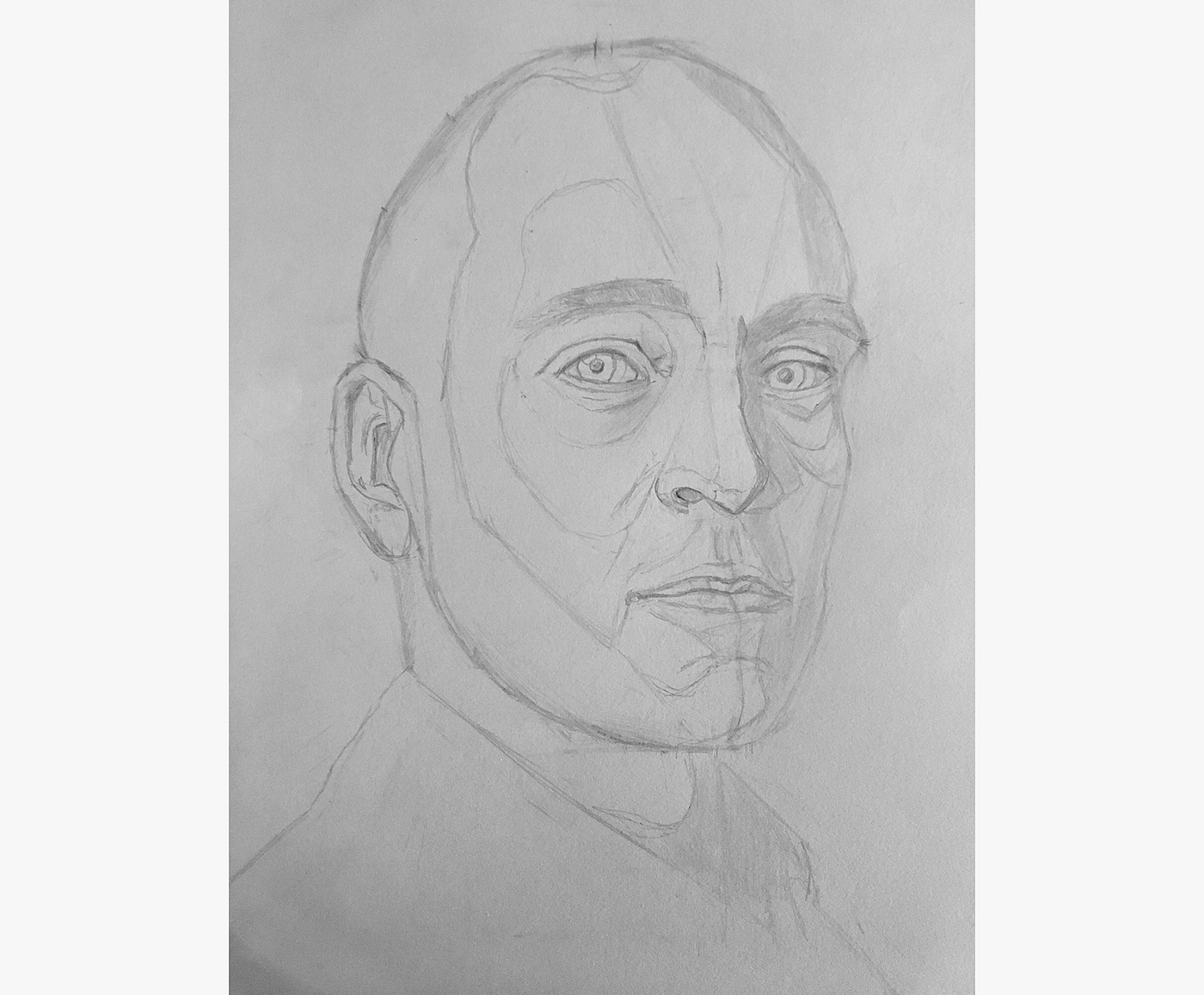
After 7.v hours of piece of work (2.v hours over the past iii days), I'm finally hopefully that this portrait will resemble Derren Brown.
Tomorrow, I'll starting adding tonal values (i.e. shading) to the drawing.
Observation virtually today's session: Based on the output from today, it may seem like today'due south drawing was the nearly technically challenging. But, in fact, I found just the opposite.
Considering I spent the past two days meticulously locating and blocking in the features, information technology was very easy to add the incremental particular. (Trying to draw big shapes is much harder than trying to draw little shapes. Little shapes are a lot easier to visually understand and replicate)
In fact, I doubtable that today was least consequential to the outcome of the portrait. If I mess up the shape of the head and the location of the features, I have very little chance of capturing a likeness. If the features are not quite accurately detailed, but in the correct place, I even so might accept something…

Yesterday, after 7.5 hours of piece of work, I finally finished sketching / laying out my first portrait. Today, I started adding tonal values (a.k.a. "shading the drawing").
Earlier I show today's progress, I want to share two techniques I learned that make it significantly easier to accurately add tonal values to portraits.
1. Showtime with the almost farthermost values and then run across in the center
The human center is actually bad at assessing tonal values in isolation — which is why your brain thinks squares A and B below are very unlike colors, when, in fact, they are the same.

Thus, instead of relying on visual inferences, tonal values tin exist better approximated through a simple, not-so-interpretative procedure.
Here'due south how it works:
Start past identifying the absolute darkest and absolute lightest areas of the drawing. For the darkest areas, shade them as dark as yous can/want. For the lightest areas, highlight them as light equally you can/desire.
This establishes the unabridged tonal range of the drawing, which is called the cardinal of the drawing.
Establishing the key is straightforward, and doesn't require much visual estimation (i.e. it'due south piece of cake to find the lightest lights and the darkest darks).
Once the central is established, and the lightest and darkest values are in place, the intermediate values need to exist introduced. Again, this can be washed procedurally, by identifying and shading/highlighting the areas which are slightly lighter than the darkest darks and slightly darker than the lightest lights. Continuing recursively in this mode, the tonal values eventually meet in the heart, and the drawing (or the relevant office of the cartoon) is consummate.
ii. Squint to better see tonal shapes
When keying the drawing (and developing tonal values in full general) information technology's important that the shapes of the tonal areas are captured accurately.
In other words, if the highlight on the forehead is angular, drawing it with rounded edges wouldn't properly capture the form.
This sounds obvious, but once more, your encephalon and visual organization tin trick on you. Your encephalon is attempting to see a face (via your psychologically skewed, emotions-based mental model of a face), and not just tonal blobs.
In fact, this psychological problem of misinterpreting faces is and so common, there are entire drawing systems (like drawing upside downward, drawing the negative space around the face, etc.) designed to combat these problems.
Side note: Hither's a video of Derren Dark-brown, the subject of my portrait, when he used to have hair, experimenting with some of these alternative methods of painting. It's a pretty cool trick.(If you're going to watch, stick it out until the end).
In order to accurately run into tonal shapes, and avert psychological errors, I've institute ane method to be surprisingly successful: squinting.
Basically, yous wait at the surface area you lot want to depict, squint your optics (and so the image becomes blurred and your encephalon no longer sees a face), and identify the tonal shapes you see through your eyelashes. This works super well. (I didn't invent this method, I've just validated that it works for me).
Today's progress
With these techniques newly-learned, I began to add together tonal values to my Derren Chocolate-brown portrait.
Start, I started with the eye.

In the class, the teacher mentioned that it'due south practiced to starting time with a pocket-size area that exhibits the full range of tones.
However, the heart was too modest to assist effectively establish the central. Then, I keyed the drawing more aggressively, starting with the shadow on the olfactory organ and the highlights on the forehead and cheek.
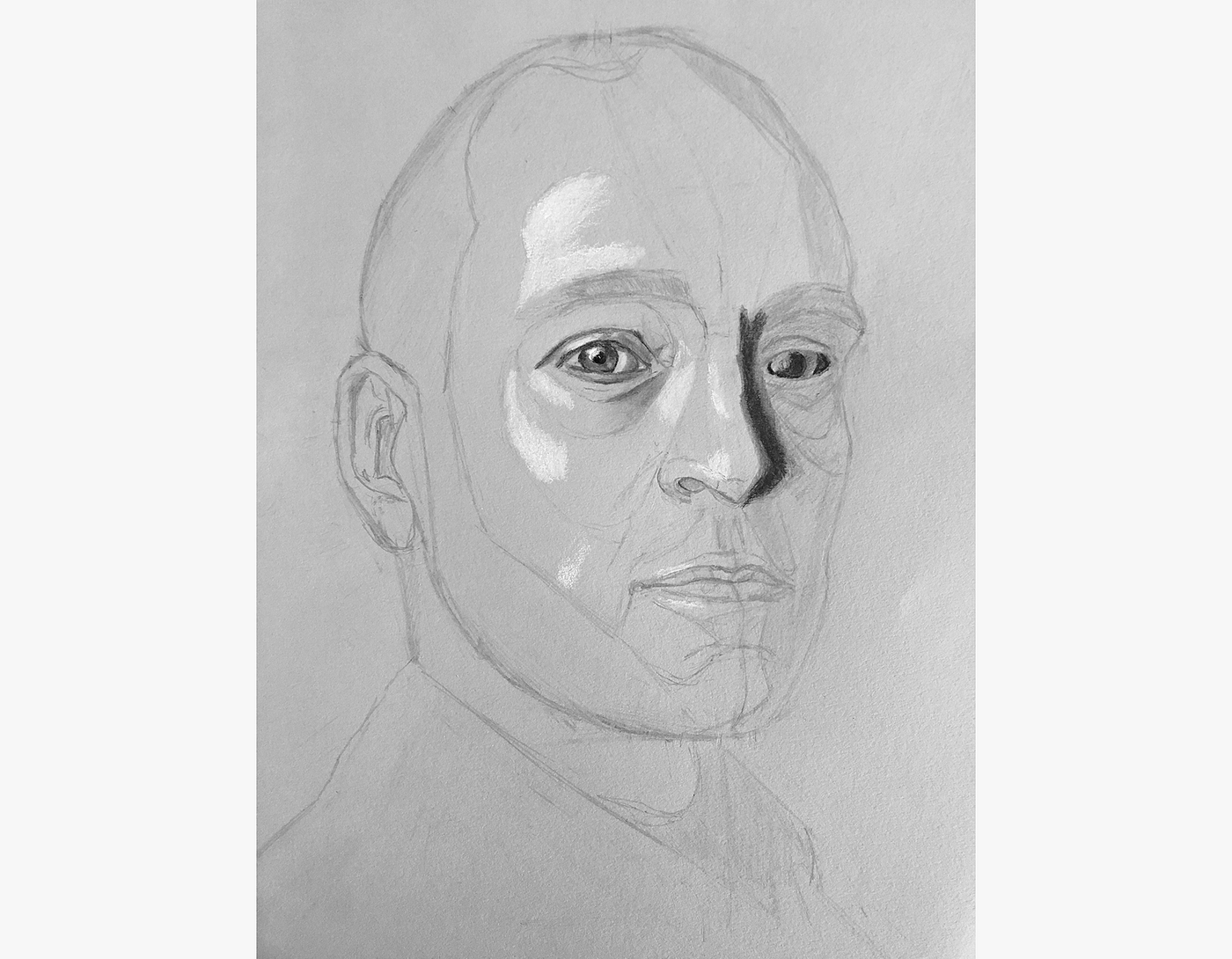
I connected shading the darkest areas along the right side of the face.
Additionally, while doing this, to check the accuracy of my key, I started developing the eye.
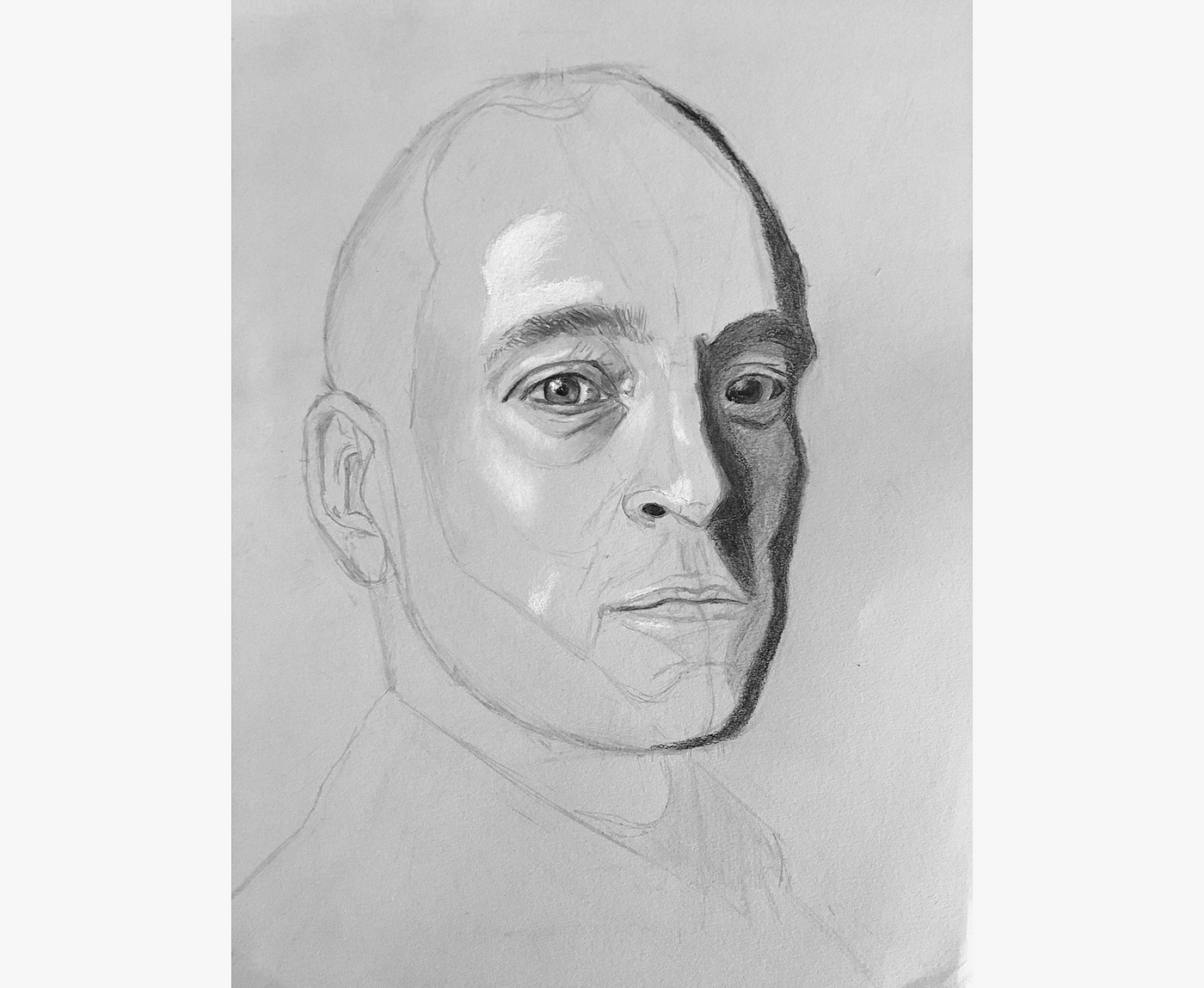
I finished up my key, by adding shadows to the lower confront and the back of the head, and was ready to begin modeling the form (finding the intermediate values between the darks and lights).
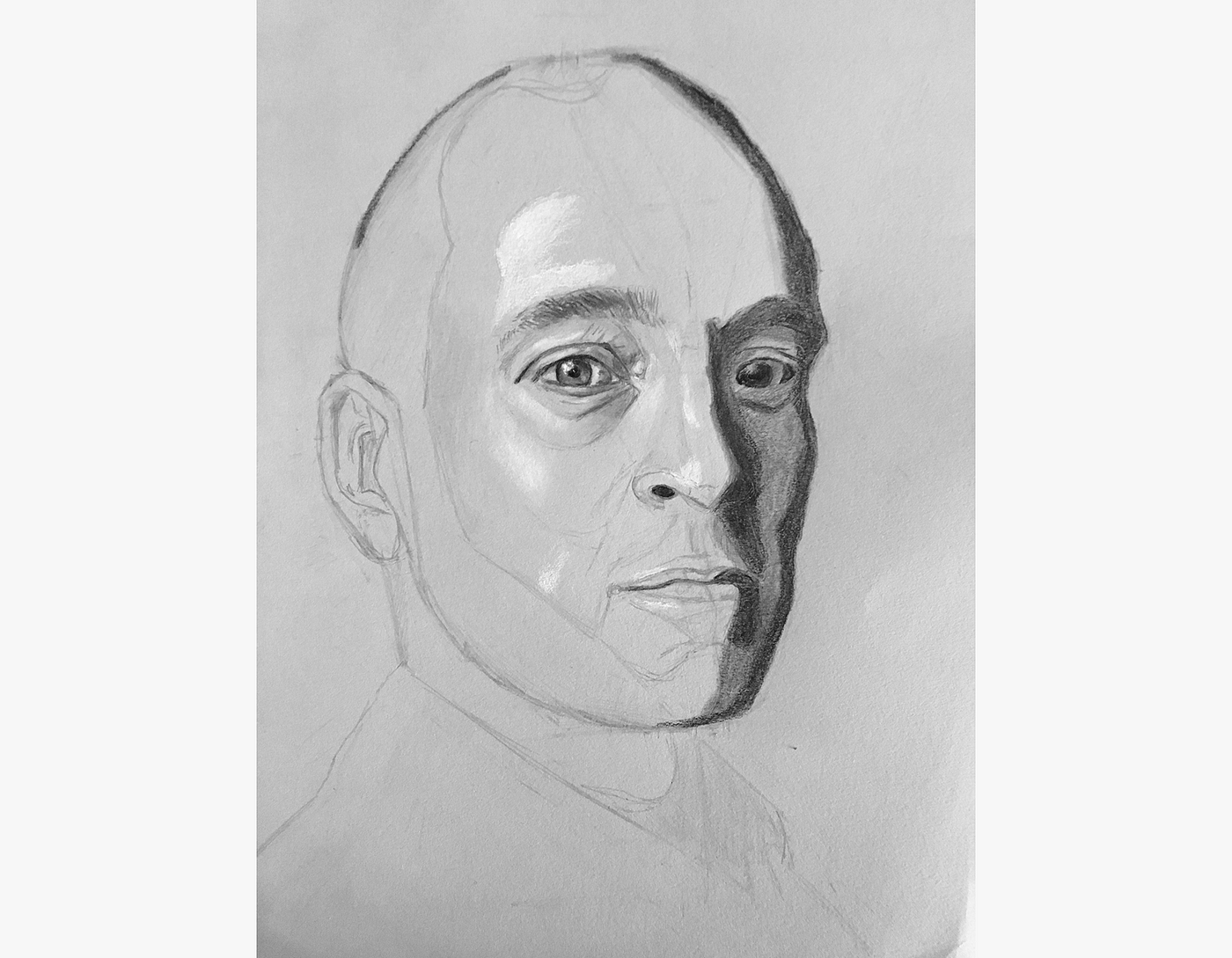
I started with the brow.
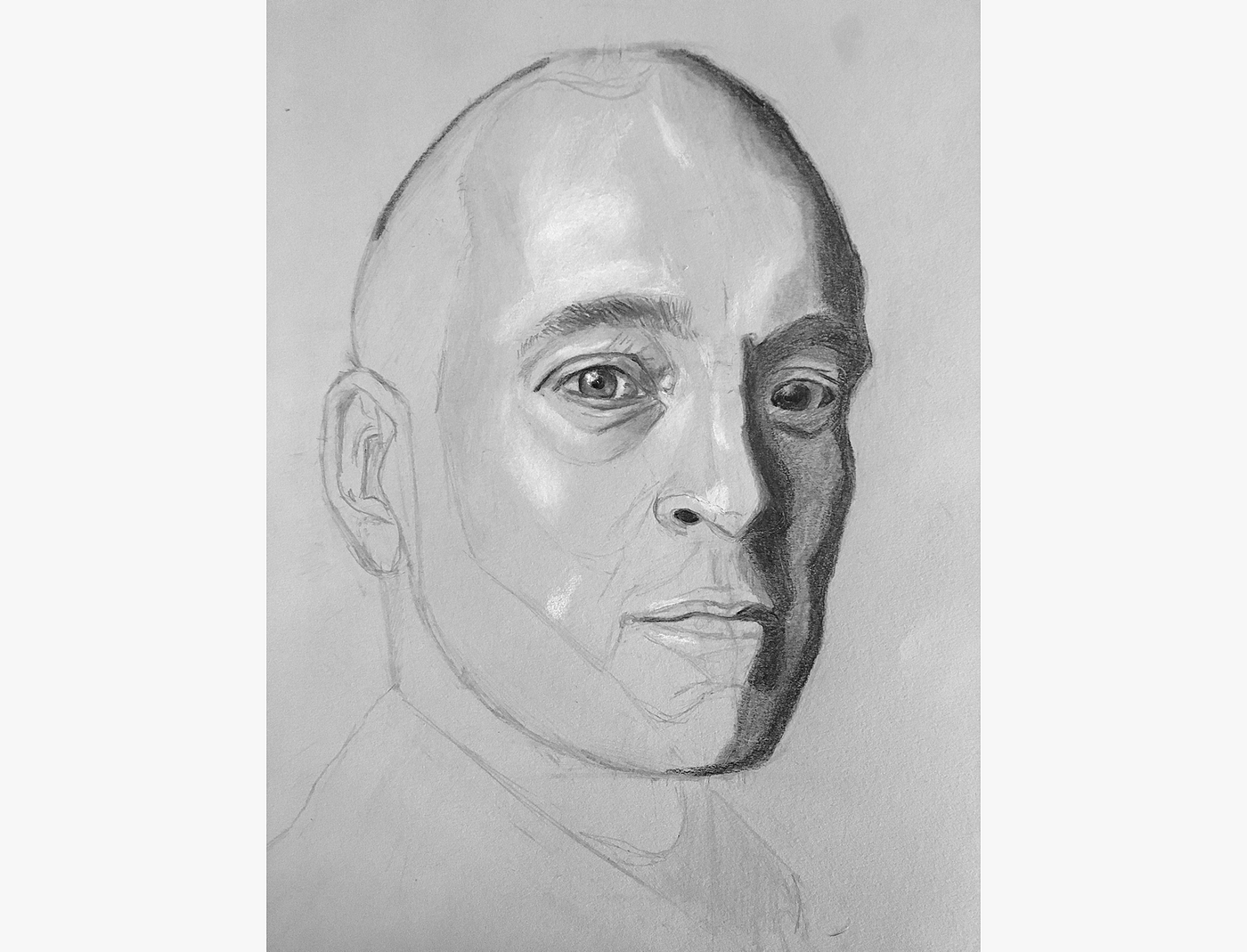
Added a flake more detail.
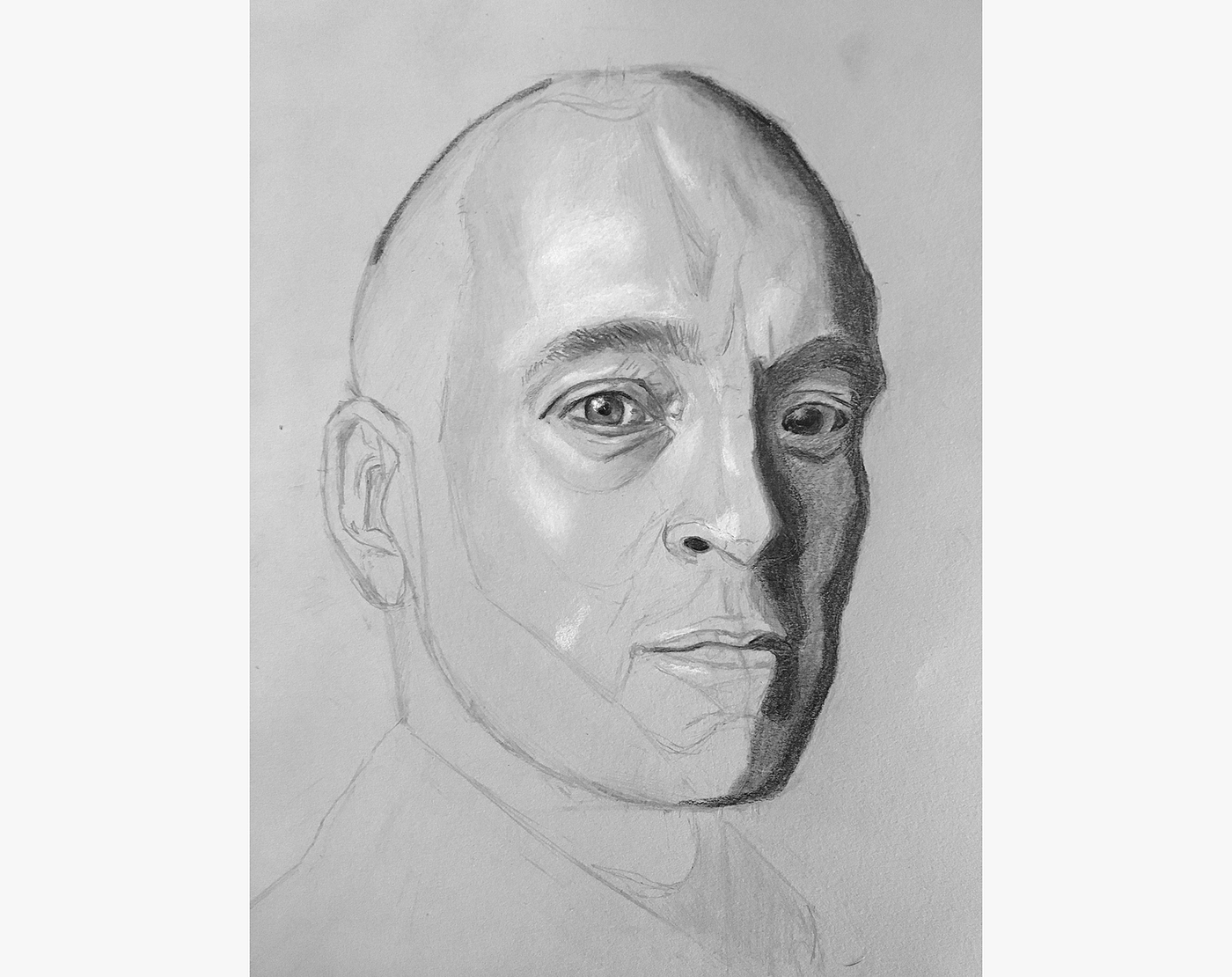
And then smoothed everything out.
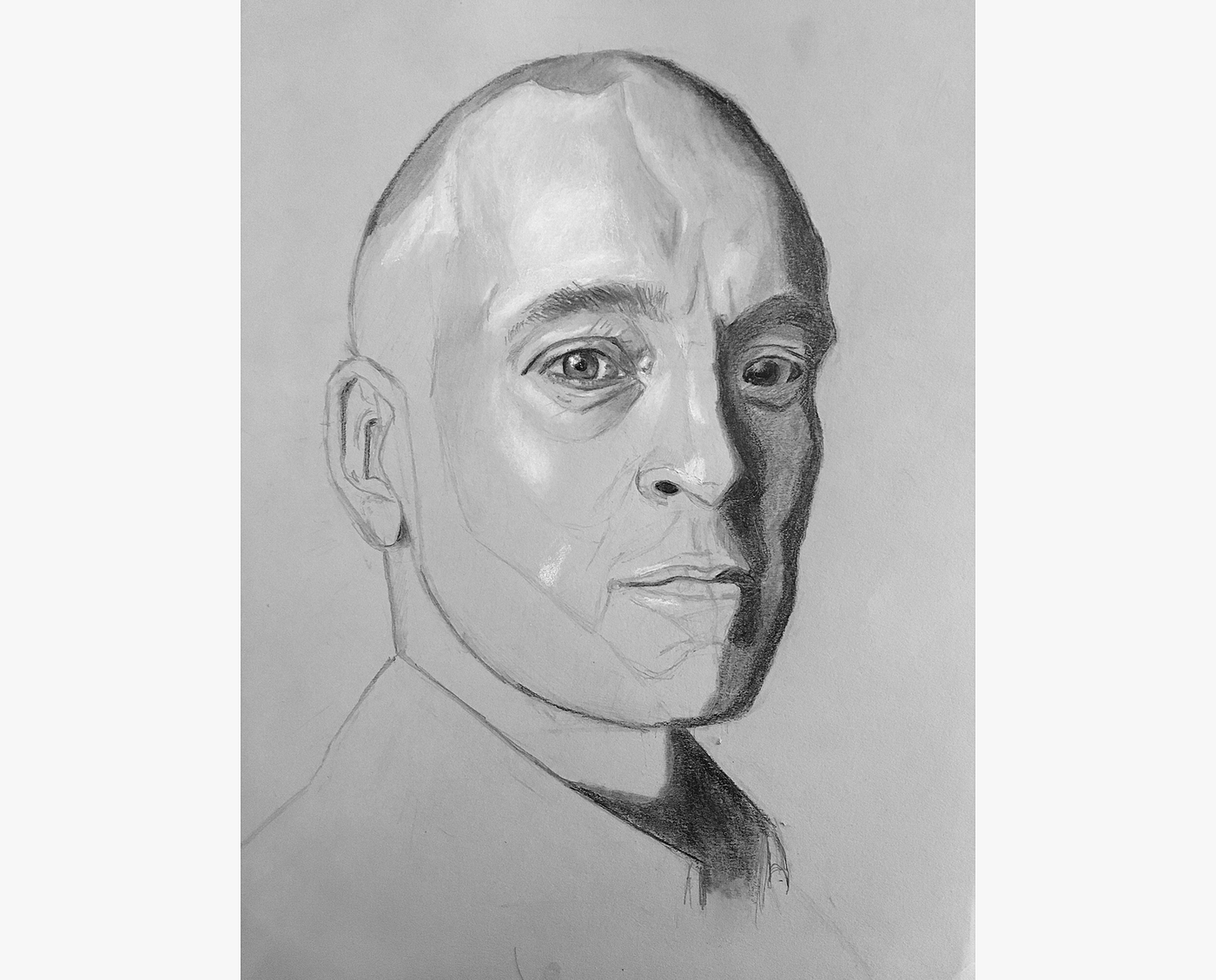
This is where I stopped for the day, subsequently some other 2.5 hours of working.
Derren looks a bit too shiny correct now — a bit similar a mannequin or the Tin Man — but I'm optimistic that this issue will vanish once I model the balance of the form.
I'chiliad guessing I accept another five hours of work left on this.

Today, similar yesterday, I connected calculation tonal values to the portrait. I spent a niggling less than ii hours, and am getting really excited nearly the results.
Here'southward where I stopped yesterday.

I proceeded today by first addressing the nose.
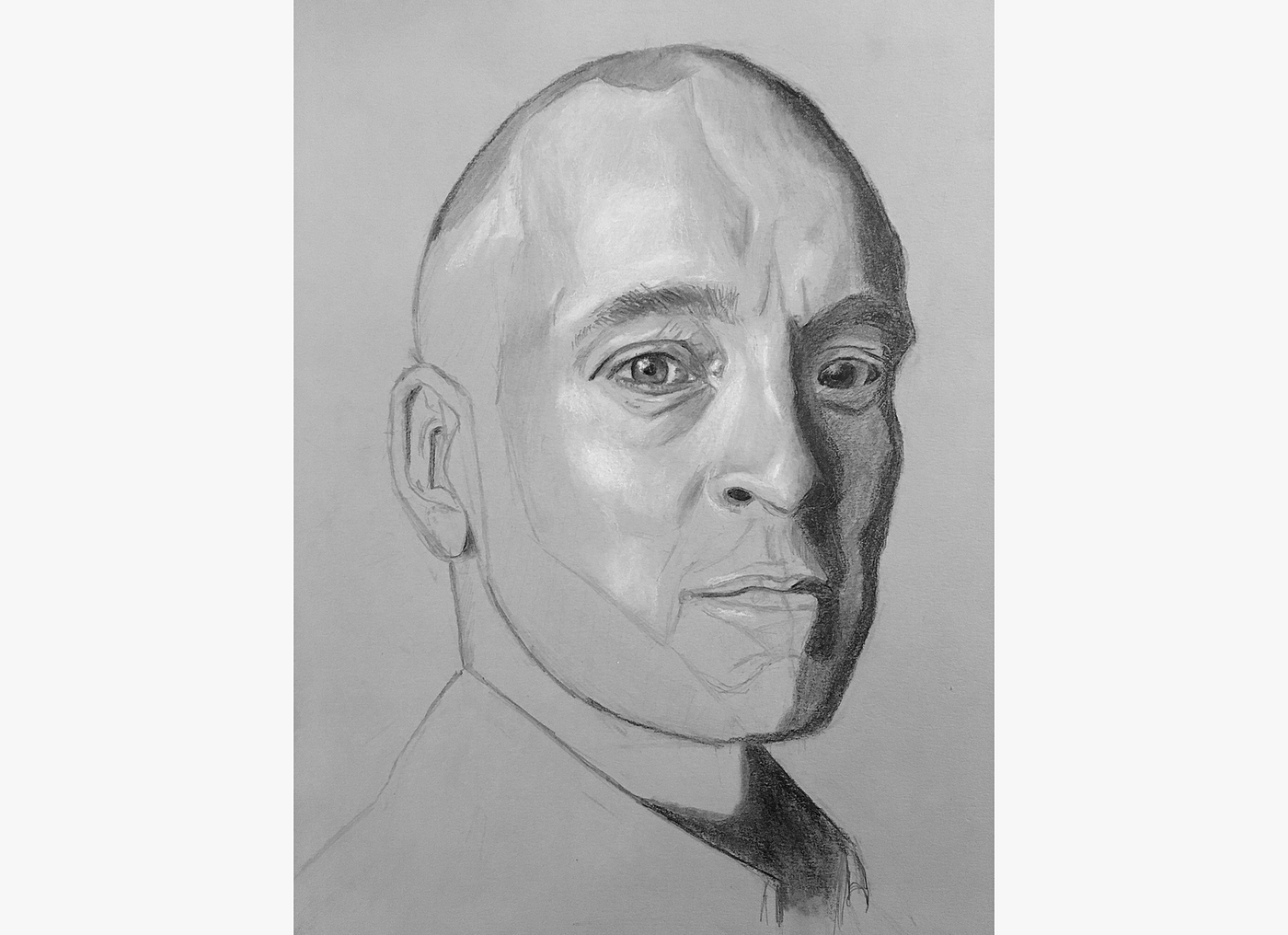
Then, I addressed the correct half of the face up — further developing the shadow.

Side by side, I moved on to Derren's hair and beard.
Since the demo portrait in form is based on a long-haired female model, I had to do a scrap more freestyling at this bespeak. I call back it works.
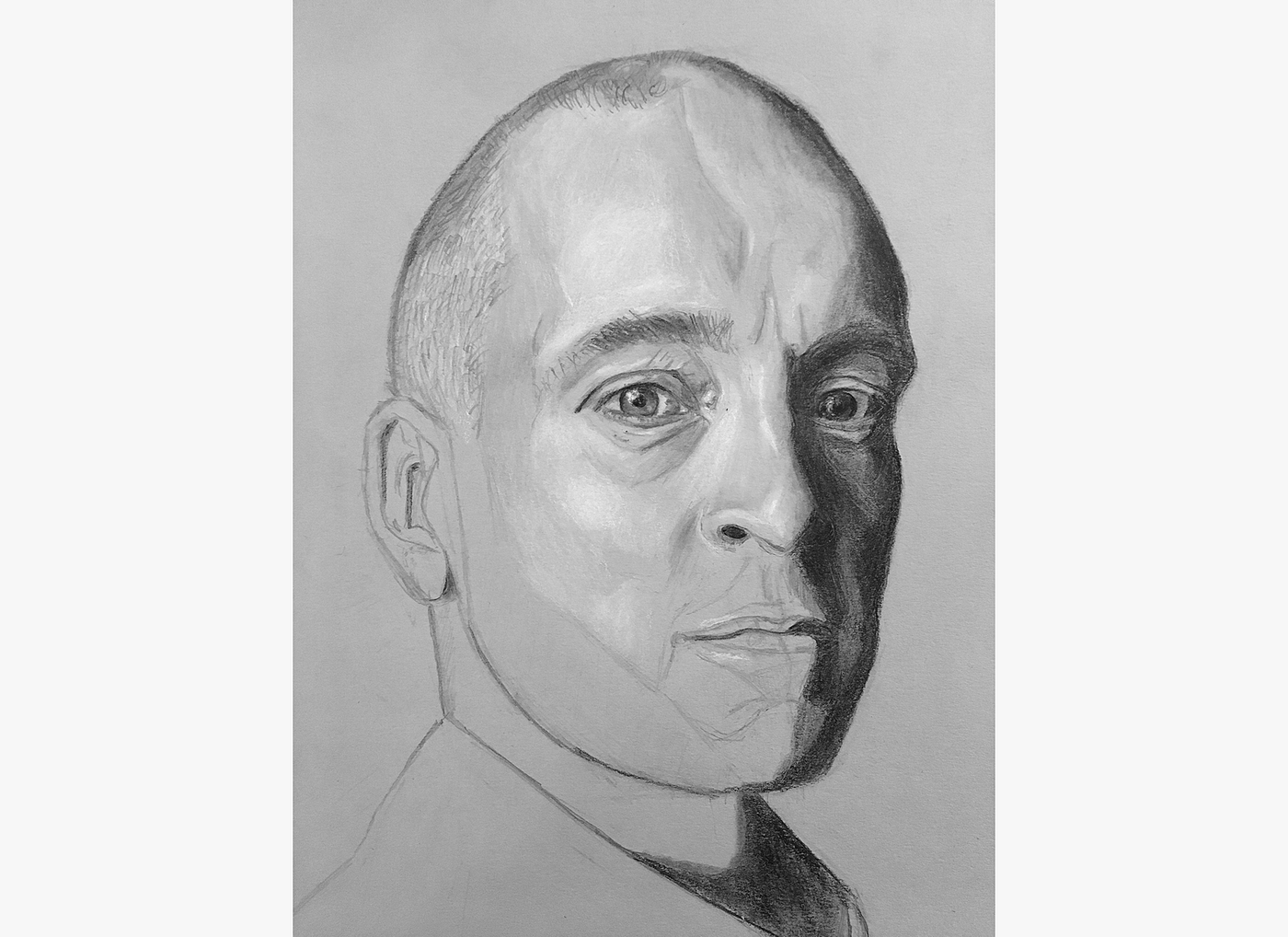
I continued with the upper part of the bristles, and finished up for the 24-hour interval.
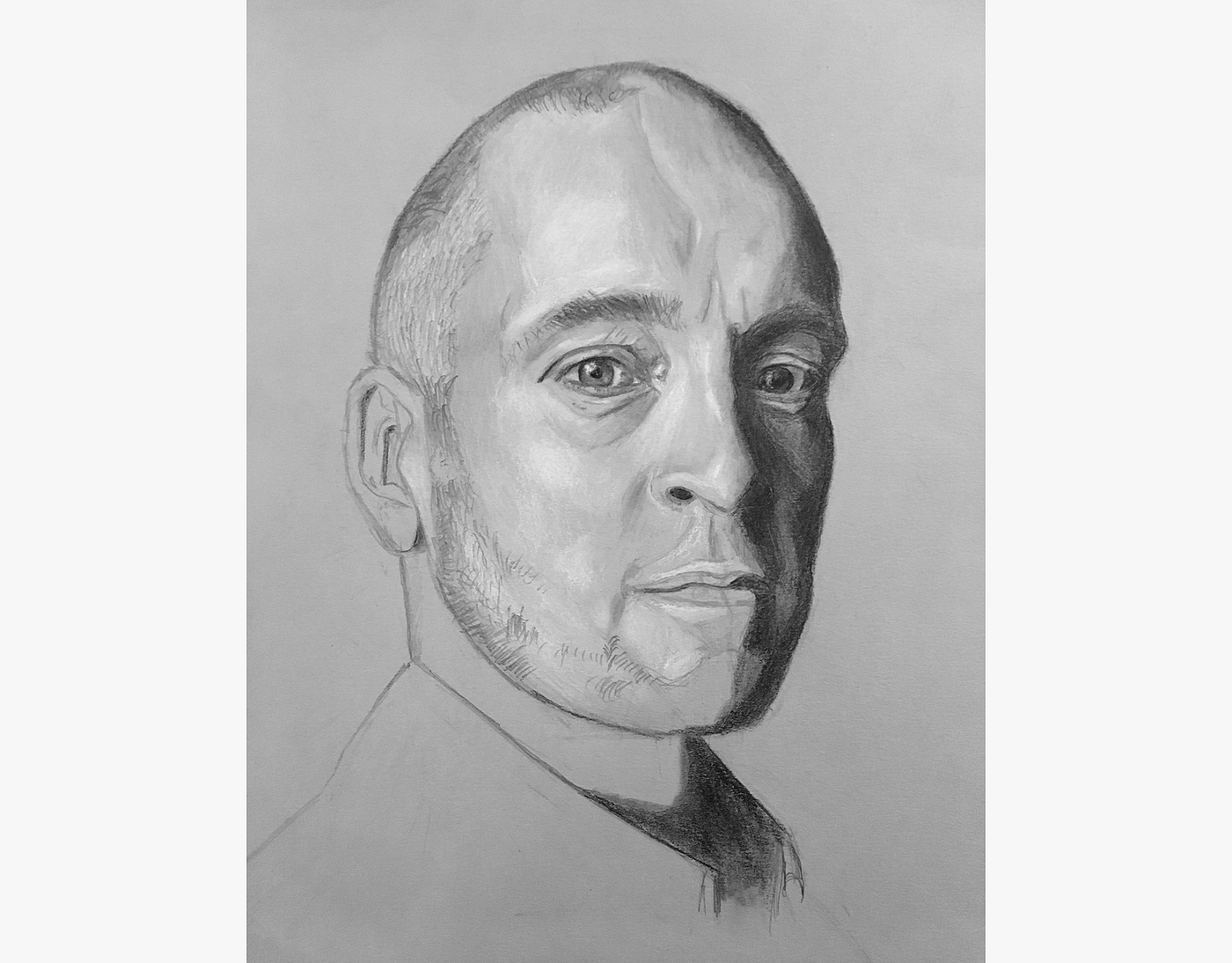
Tomorrow, I need to finish the oral cavity, the ear, the neck, the lower part of the beard, and perhaps the clothing.
Getting close…

Today, afterward another 2.v hours of piece of work, I finally completed my Derren Brown portrait.
In the coming days, I will write a few detailed posts well-nigh what I've learned, how I programme to move forward, etc., but for now, I'll just share the final photos of my progress.
Today's progress
I started off by detailing the lips.
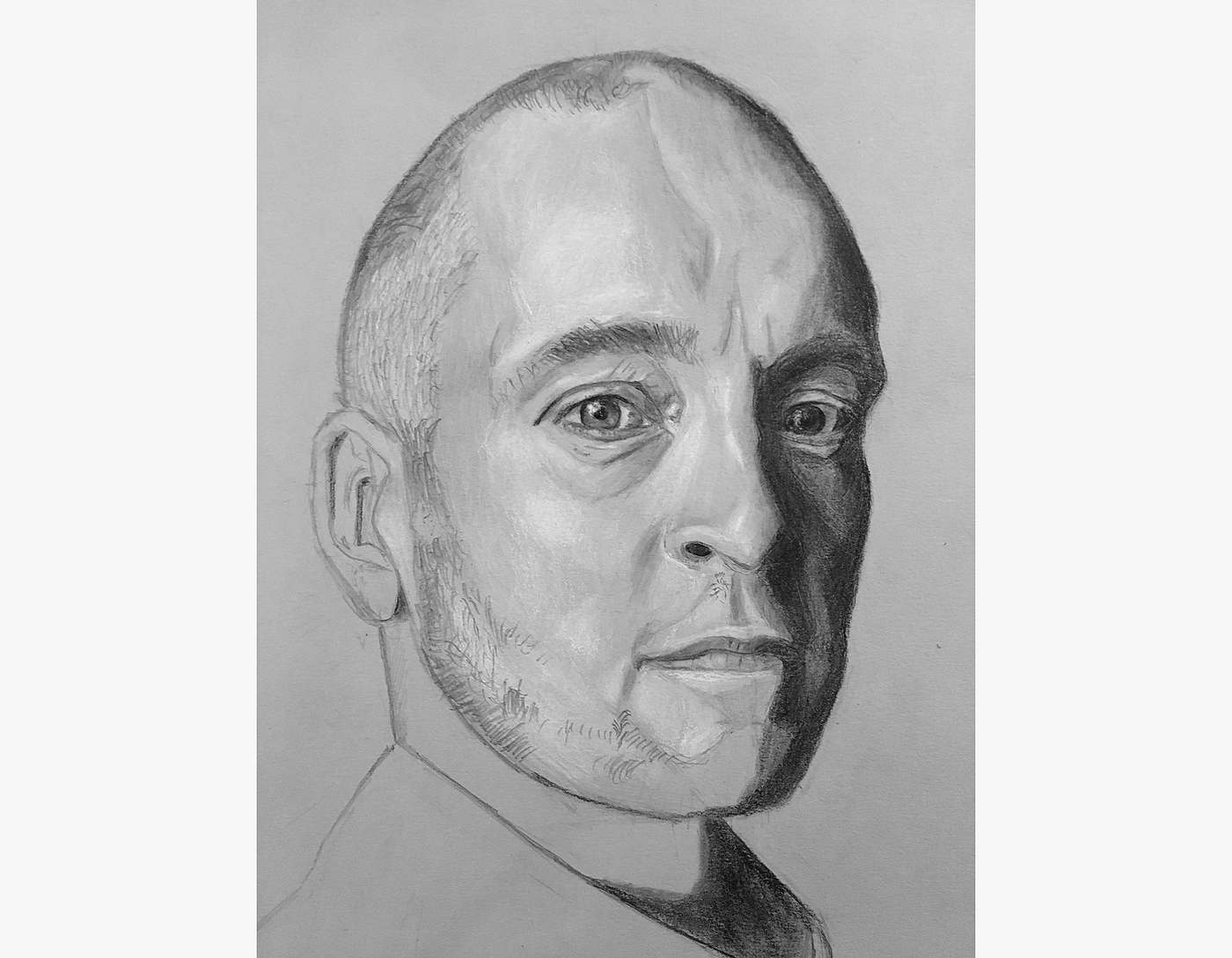
And then, I added the mustache.

With this facial hair momentum, I finished off the beard.
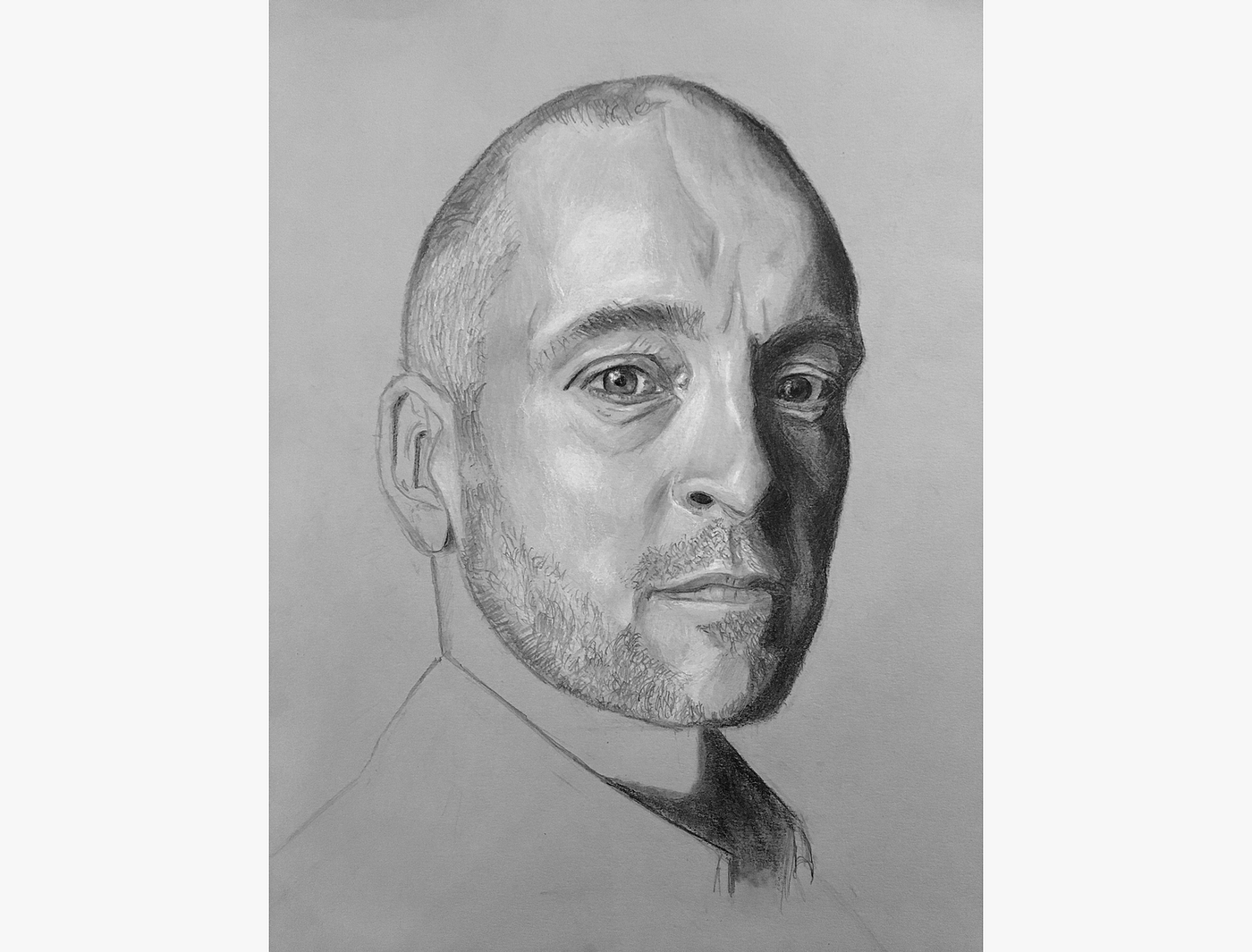
And then, the ear.
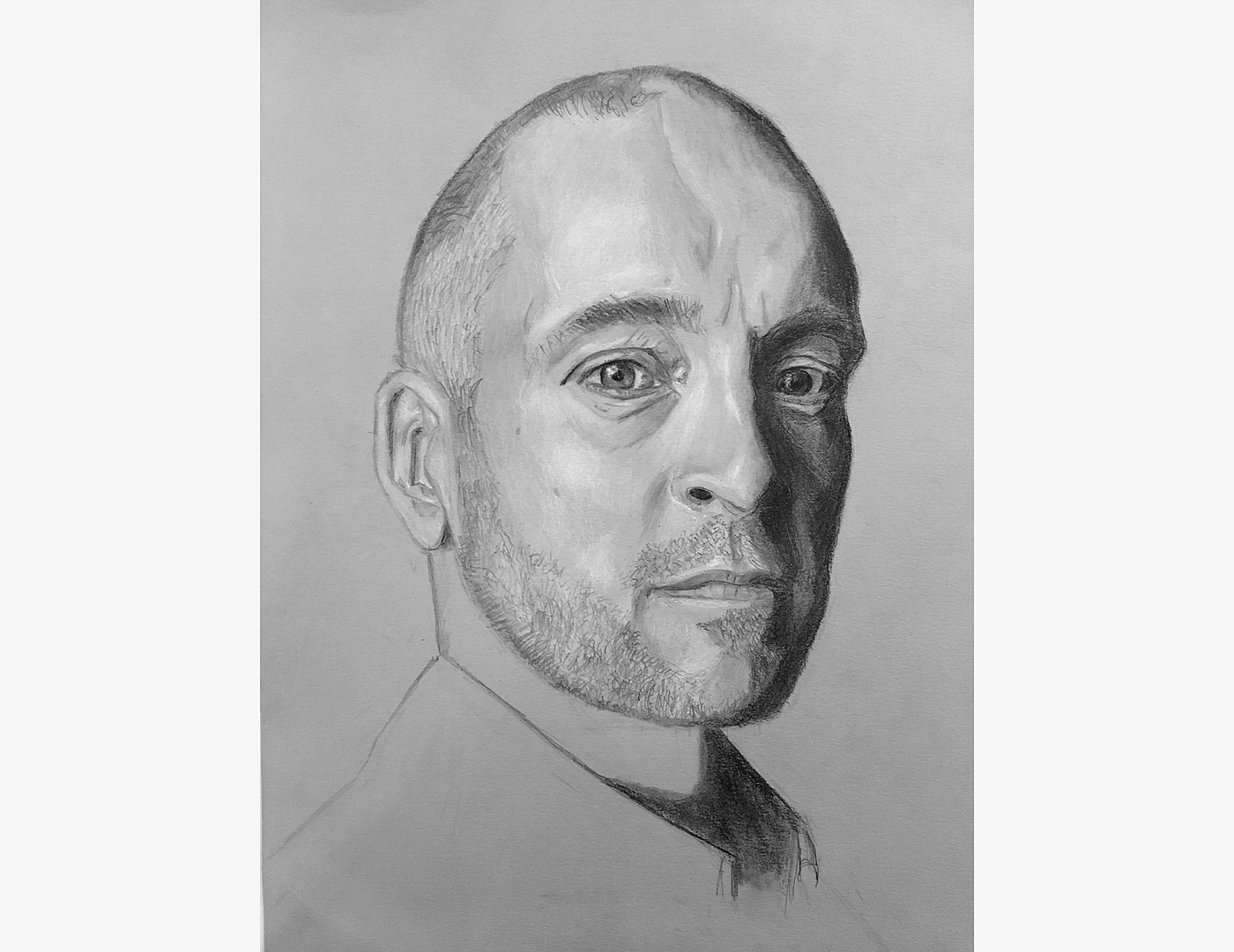
Finally, I completed the neck, decided not to address the dress, signed information technology, and I was done.
For my first portrait of the month, I'one thousand quite happy with how it turned out.
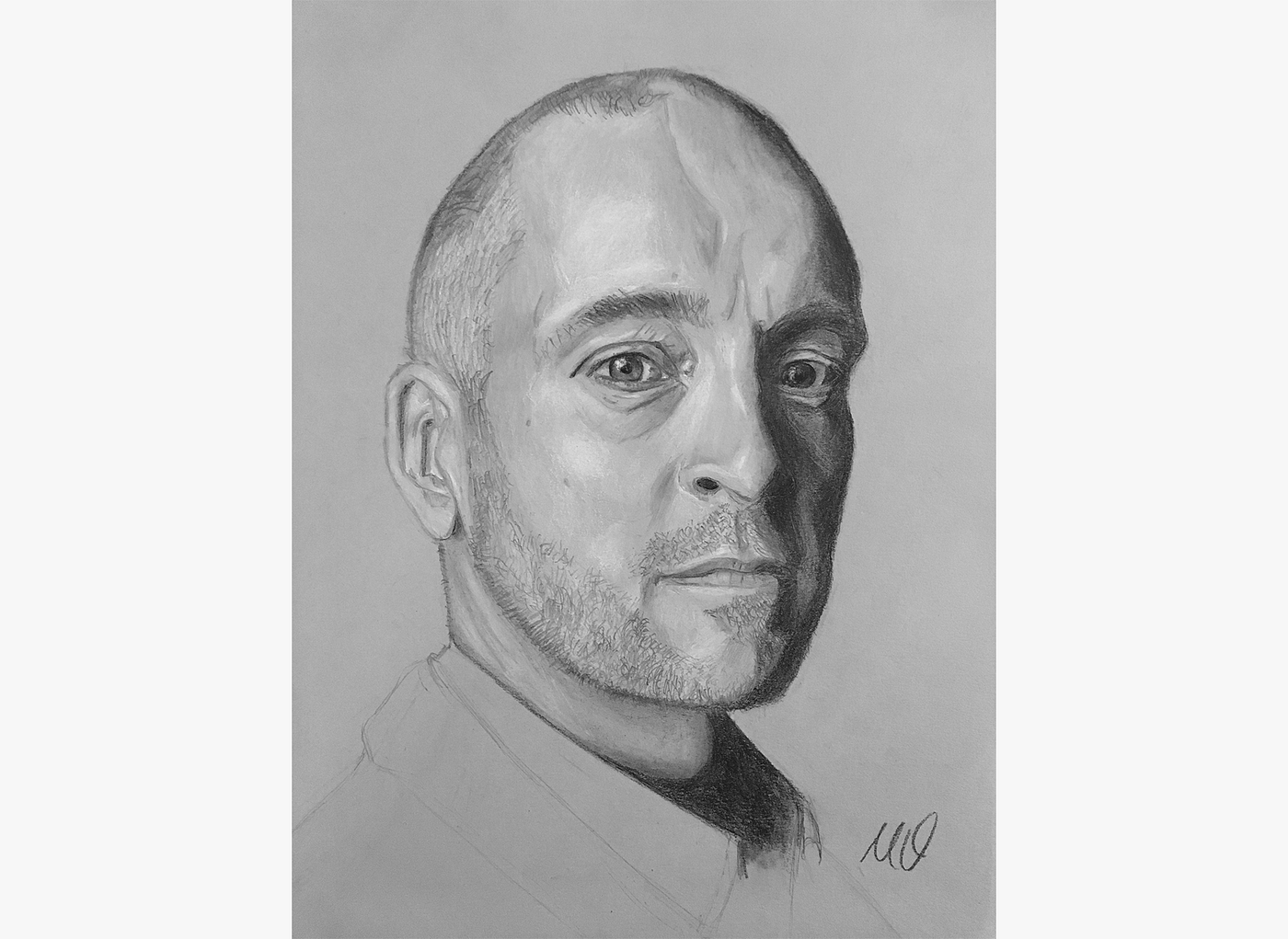

Nine days ago, I began my thirty-day quest to learn how to draw photorealistic portraits. Since so, I've watched the entire 10 hours of the Vitruvian Studio drawing course, every bit well as spent 14.5 hours working on my first portrait.
Here's the effect…

And hither's a video documenting the progression.
Considering where I started only nine days agone (run across the before portrait), information technology'south hard for me to believe that I actually drew this. It'due south not perfect, but I'm definitely excited near the effect.
Part of me lacks the motivation to continue drawing, every bit I feel like I've already achieved my goal. The other (more overpowering) role of me realizes that I take another 21 days to amend even further, so that'southward what I program to do.
In item, I'm going try to reduce the amount of fourth dimension necessary to consummate a portrait like this. With some practice, I think I can reduce my fourth dimension downward from 14.v hours to 4–5 hours.
Tomorrow, I'm going to go through my previous posts (ane, 2, 3, 4, 5, 6) and write up a "Portrait Drawing Crook Sheet". And so, I'm going to break down the cheat sheet into isolated, practicable skills and drills, piece of work on those individual skills for i–2 weeks, and then start working on my cocky-portrait to terminate off the month.

Hither is my "Portrait Cartoon Cheat Sheet", which features step-past-footstep instructions on how to draw a portrait.
These steps are based on the splendid portrait cartoon course by Vitruvian Studio, which I highly recommend you purchase if y'all are serious most learning how to draw.
The Instructions
- Marking the top of the head. Arbitrarily draw a line towards the summit of the folio. This represents the meridian of the head.
- Marker the bottom of the chin. Arbitrarily draw a line almost the lower third of the page. This represents the bottom of the chin.
- Mark the notch of the neck. On the subject, using your pencil as a guide, measure the distance from the everyman point of the caput to the notch of the neck. Determine how many of these distances tin can fit inside the vertical distance of the head. Use this is as guide to draw a horizontal line towards the bottom of the page to represent the notch of the neck.
- Find the highest point of the caput. Arbitrarily determine a bespeak on the top line. This represents the highest point of the head. Often, on the subject, this point sits far dorsum on the caput.
- Observe the lowest bespeak of the mentum. Using your pencil equally a guide, determine the angle from the highest point of the head to the lowest indicate of the chin. Draw a line at this bending from the highest point of the head (as marked on the page) downward towards the bottom of the chin line. Describe a dash where these lines intersect. This intersection represents the lowest betoken of the chin.
- Find the leftmost boundary. Place the leftmost boundary on your subject area. Determine the angle to this leftmost point from the highest point, and draw a line at that angle from the highest signal towards the leftmost boundary on the folio. Exercise the same from the lowest point. Draw a marking where these two lines intersect. This intersection represents the leftmost boundary. The technique used to find this boundary is called triangulation.
- Find the rightmost boundary. Again, triangulate from the highest and lowest points to find the rightmost boundary of the head.
- Check the bending. On the subject, utilize your pencil to find the bending betwixt the leftmost and rightmost boundaries. Bank check if this angle matches the angle represented on the page. If not, retriangulate and check again.
- Draw the outer-boundary of the head and hair. Triangulate points around the head and connect them with straight lines. In one case the general shape seems right, smooth out the kinks. Check the angles between various points on the subject and on the page to make sure everything looks correct. If there seems to be inconsistencies, retriangulate and accommodate. Do the same for the hair line.
- Describe the vertical heart line. Pick some cardinal point that looks similar its on the vertical center line. Triangulate from outer-points inwards to observe this key bespeak. Bank check the angle from the bottom/center of the chin to this point. Use this as a guide to draw in the entire vertical center line. As the heart line approaches the top of the caput, information technology typically flattens, as it rounds back behind the head.
- Draw the level of the eyes. The level of the eyes typically falls about halfway between the top and bottom of the head. Use this as a starting point. Draw in this level, and and then bank check angles to ostend. Move upwards or down until everything checks out.
- Draw in the level of the brows and bottom of the nose. If you divide the face length into thirds, typically the level of the brows fall on the upper third line and the level of the nose falls on the lesser third line. Use this equally a starting betoken. Draw in these level, and the check angles to ostend. Movement the level upward or downward until everything checks out.
- Draw in the level of the showtime of the nose. The nose begins somewhere betwixt the level of the brows and the level of the eyes. Gauge where this is and draw information technology in.
- Draw in the lesser and centre of the lips. If you divide the distance between the bottom of the nose and the lesser of the mentum into halves, the level of the bottom of the lips typically falls at the halfway signal. Use this as a starting betoken to describe in this level. Then, gauge where the middle of the lips falls relative to the distance between the bottom of the lips and the bottom of the olfactory organ. Draw that in.
- Adjust the center line for the nose. Starting from the level of the start of the olfactory organ, adjust the center line so its bending matches the center line of the nose. Typically this will exist in two parts. The angle outwards from the level of the start of the nose to the peak of the olfactory organ, and the angle inwards from the acme of the olfactory organ to the bottom of the nose.
- Adjust the eye line for the mouth. The mouth typically has some volume, which pushes the center line forward. Adapt the center line forward below the nose to account for the book in the mouth.
- Draw in the shape of the optics and eye sockets. Triangulate the corners of the optics, and and so depict in the complete shapes. Do the aforementioned for the lids and the eye sockets.
- Draw in the shape of the brows. Triangulate the corners of the brows, and then draw in the consummate shapes.
- Depict in the shape of the nose. Triangulate the peak of the nose and the fly of the olfactory organ. Then, draw in the complete shape.
- Draw in the shape of the mouth. Triangulate the corners of the rima oris. Then, draw in the consummate shape.
- Depict in the level of the mentum. Triangulate the level of the mentum, and draw a line to distinguish the shape.
- Draw in the shape of the ear. Triangulate points of bending-modify effectually the ear. Connect these points with appropriately angled lines, and and then smooth out the kinks.
- Depict in shadow shapes. Identify shapes of chief shadow areas. Triangulate their boundaries and draw them in.
- Darken the shadow shapes. Lightly shade in the shadow areas of the portrait. Use a soft, make clean pigment brush to smooth out the material on the page. This will introduce some iii-dimensionality to your portrait, which should assist you better visualize if annihilation doesn't seem quite right. If there is something that seems wrong, gear up it.
- Detail the eyes. Draw in the iris, pupils, and other details.
- Detail the nose. Draw in the nostrils and other details.
- Detail the lips. Smooth out the shape of the lips.
- Detail the ear. Draw in some of the main inner land marks.
- Primal the cartoon. Identify the lightest and darkest tones on the subject, and add together these tones to the folio.
- Modeling an surface area. Selection an expanse of the caput (like the forehead), and particular some of the master places of tone-alter. Identify and add in the main light and dark areas. Using a shading stump and the necessary pencils, fill in the transition tones. To ameliorate see the shapes of highlights and shadow, squint your eyes until the confront isn't recognizable as a face up, simply rather a collection of tonal blobs.
- Model the remaining areas. Continue every bit above until all areas are modeled.
- Sign it. And you lot're done.

A few days ago, I finished drawing my kickoff portrait. Since then, I've reread my notes, reviewed some parts of the course, and wrote up my "Portrait Drawing Cheat Sheet".
With all the steps documented, it's now time to deliberately practice the well-nigh important skills.
In particular, every bit I said on Twenty-four hour period 35, I believe that it's nearly of import to accurately capture the proportions of the head, the head shape, and the level of the features. If these things are done correctly, the rest of the process is very forgiving. If not, the portrait will end up beautifully shaded, only won't expect like the subject area.
Today, I'm going to do finding the correct proportions of the subject field's head using a few celebrities: Matt Damon, Natalie Portman, and Morgan Freeman.
Matt Damon
Here'southward the photo I'm using.
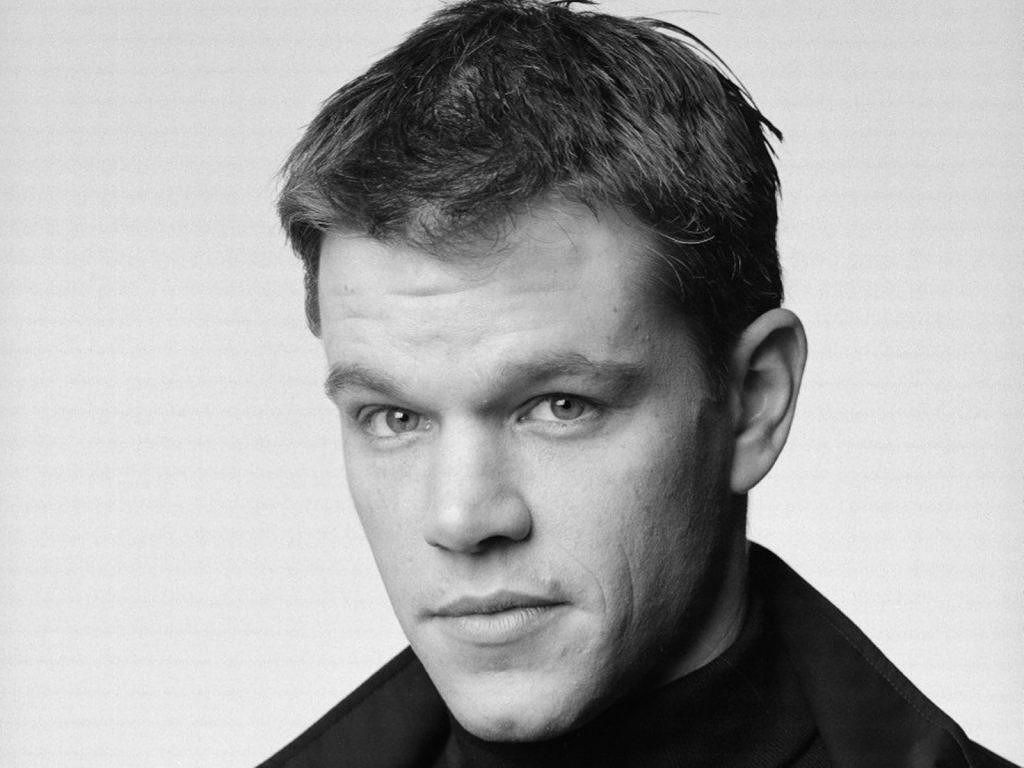
Here's my endeavour to locate the summit of his head, the lowest point of his mentum (which is located on the chin's left side), the leftmost signal of his cheek, and the rightmost point of his ear.
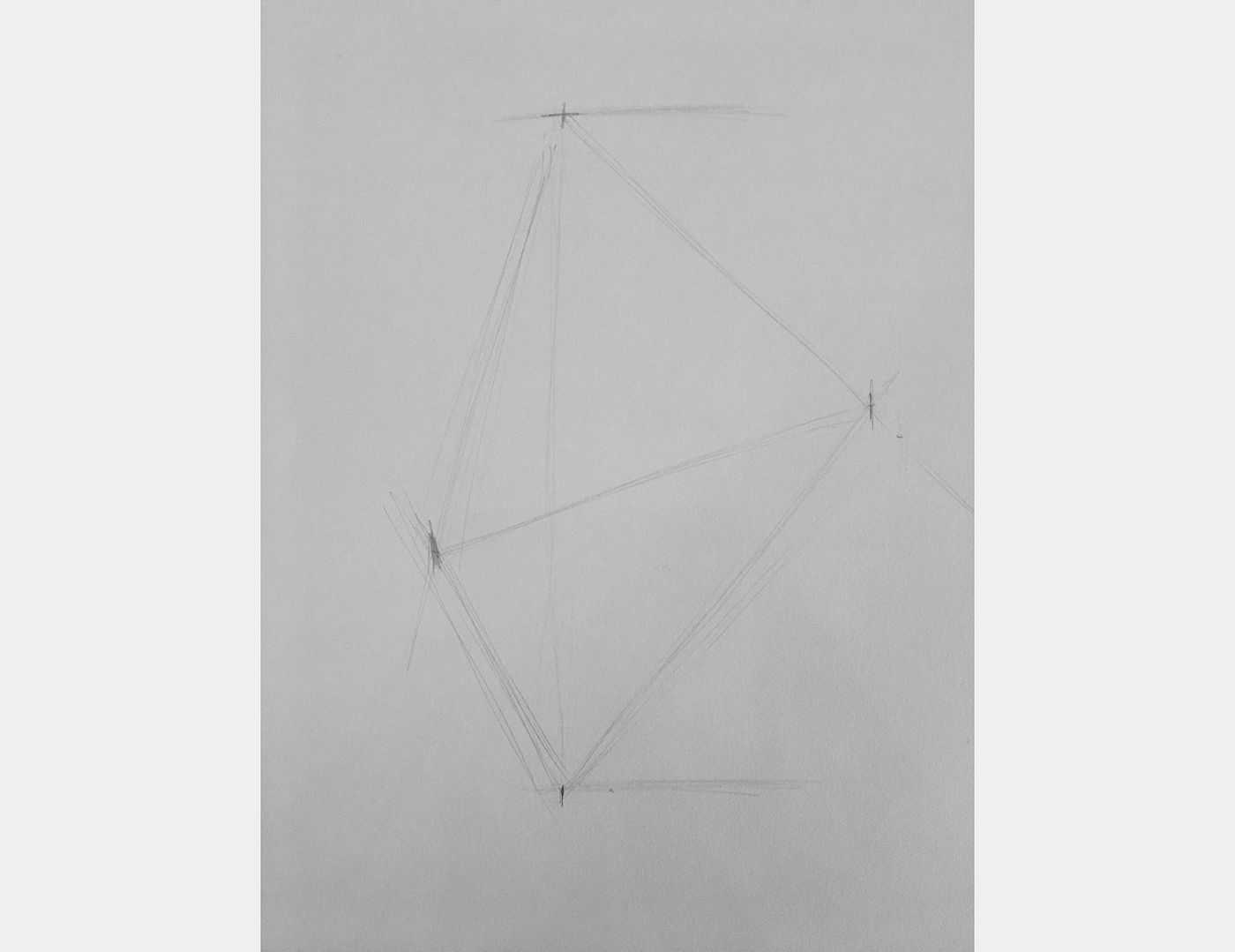
In Photoshop, I overlaid my sketch on the photo to check. I was pretty accurate.

Natalie Portman
Here'due south Natalie.
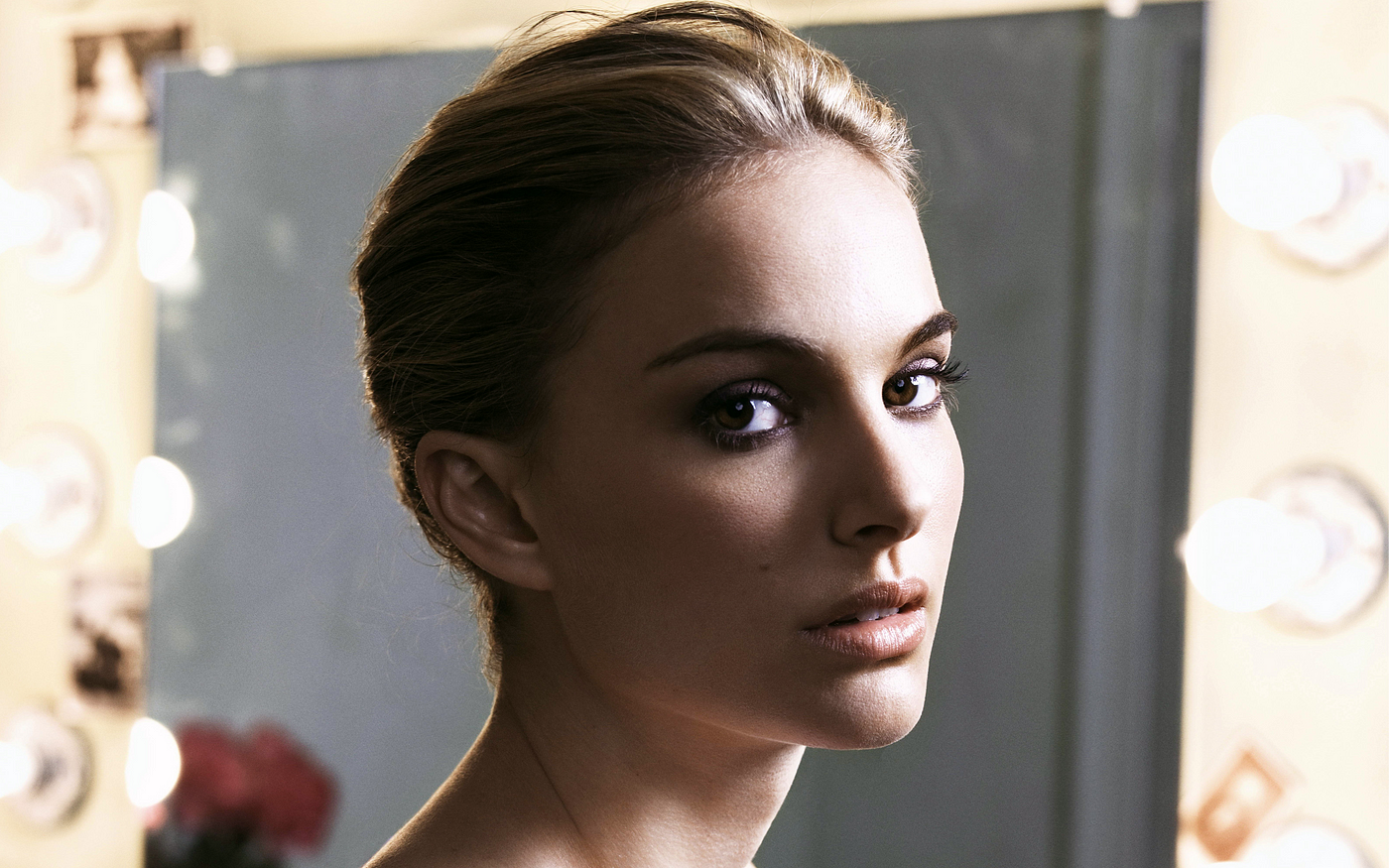
And here's my try to locate the acme of her pilus, the everyman point of her chin (once more on the chin'south left side), the rightmost point of her cheek, the leftmost indicate of her hair, and the notch of her cervix.
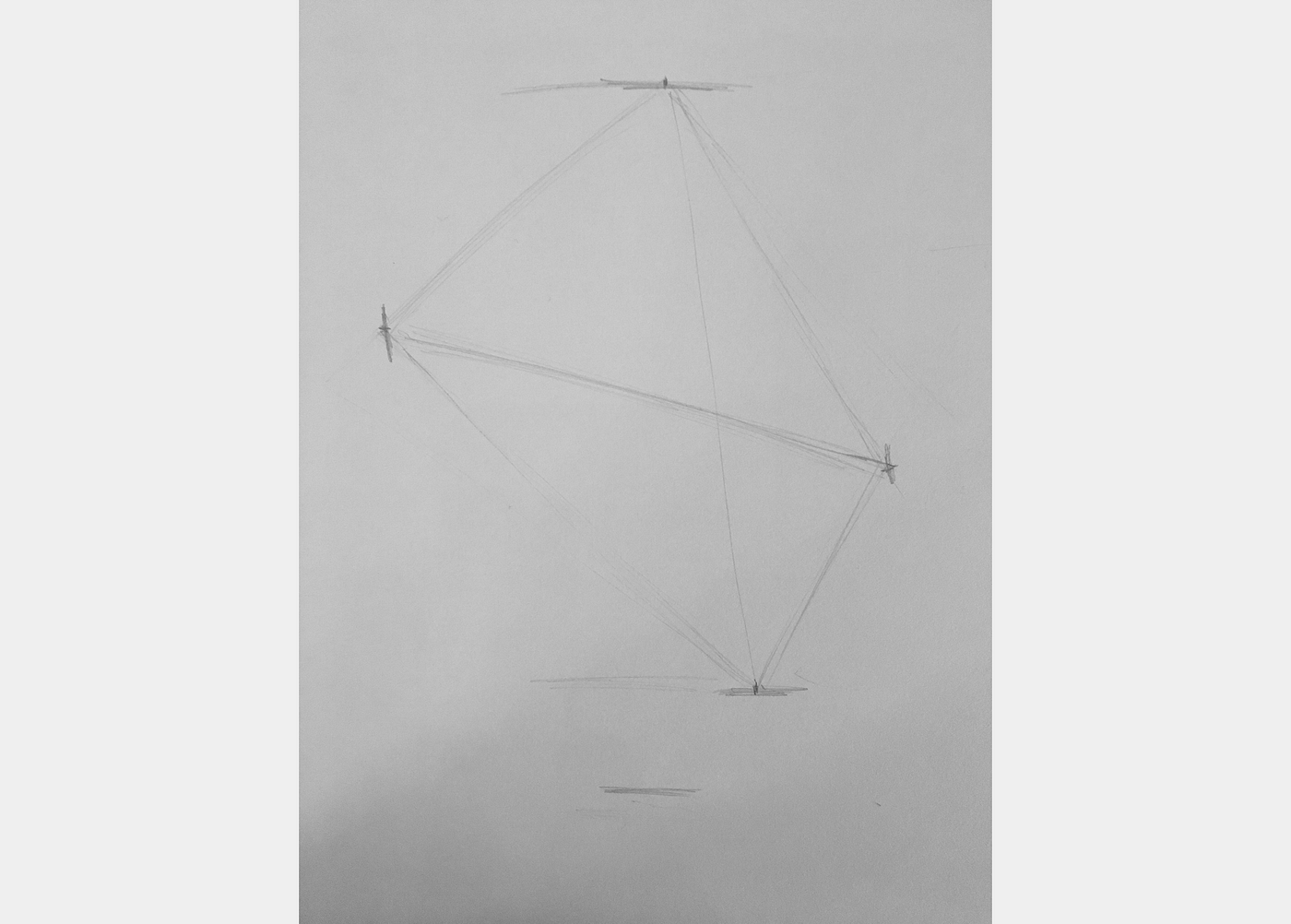
Checking in Photoshop, everything seems pretty accurate. Although, the depression point of the mentum may be slightly likewise far left.
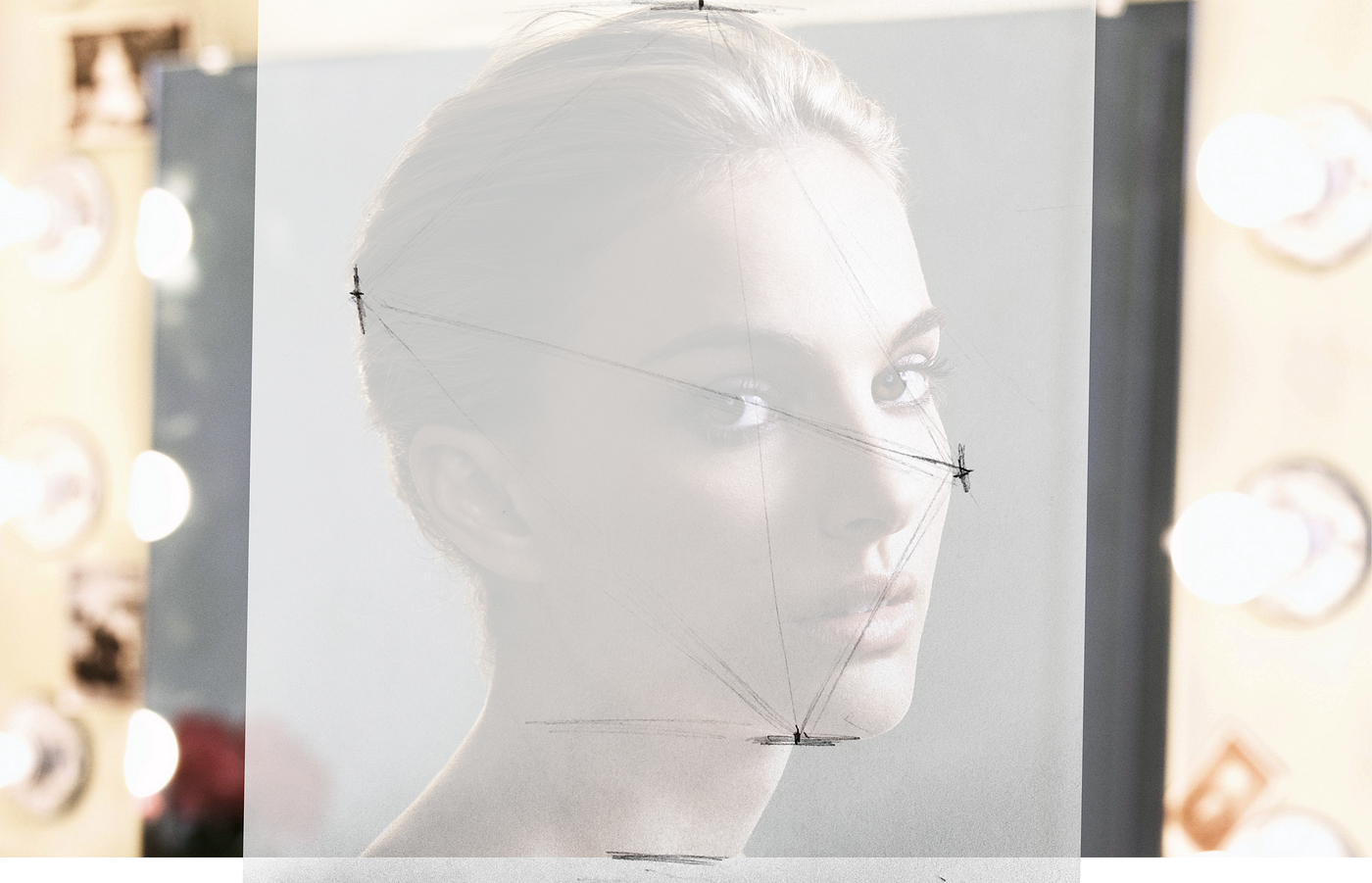
Morgan Freeman
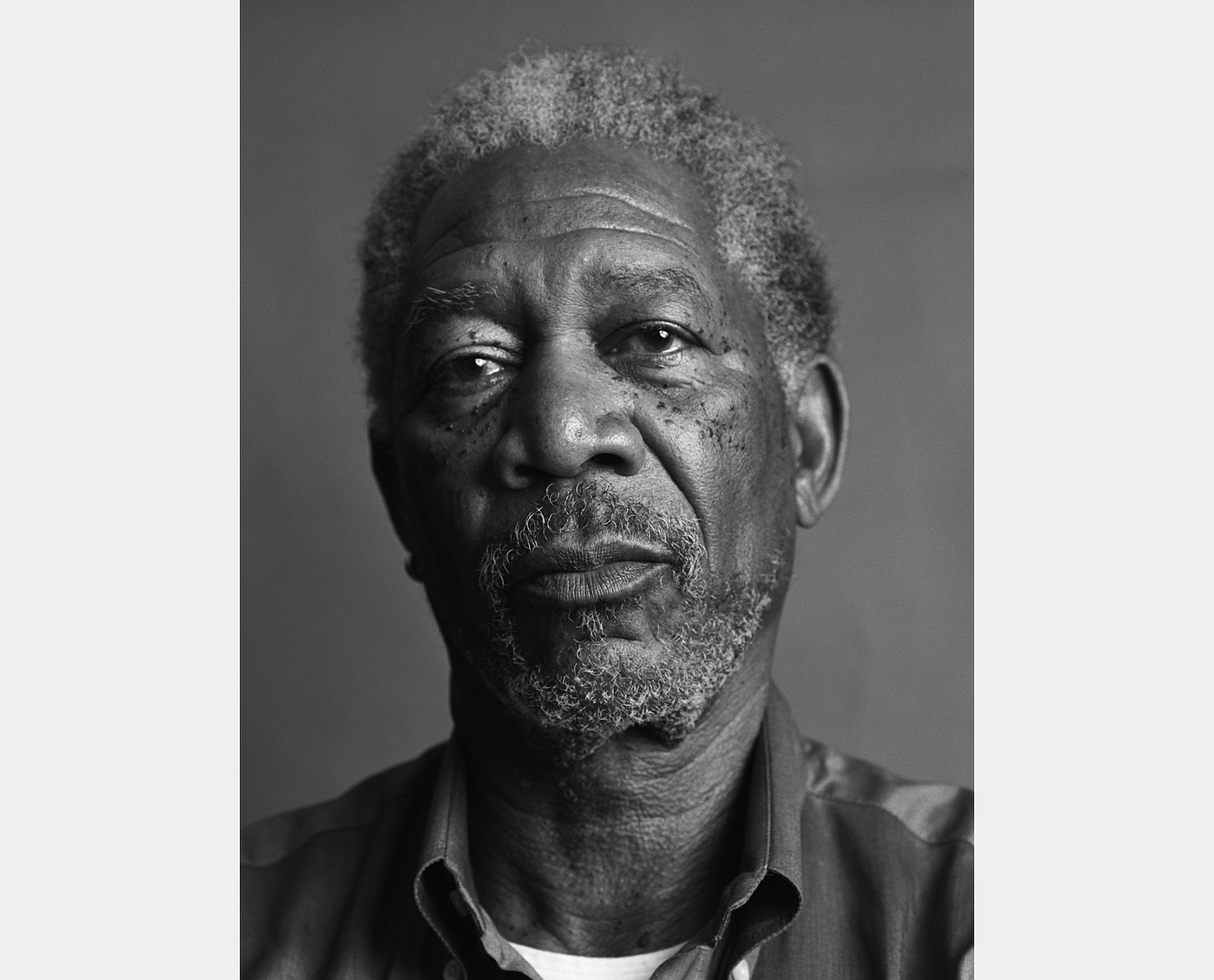
Hither I effort to locate the elevation of his head, the lowest point of his chin, the rightmost point of his ear, the leftmost signal of his ear, and the notch of his cervix.
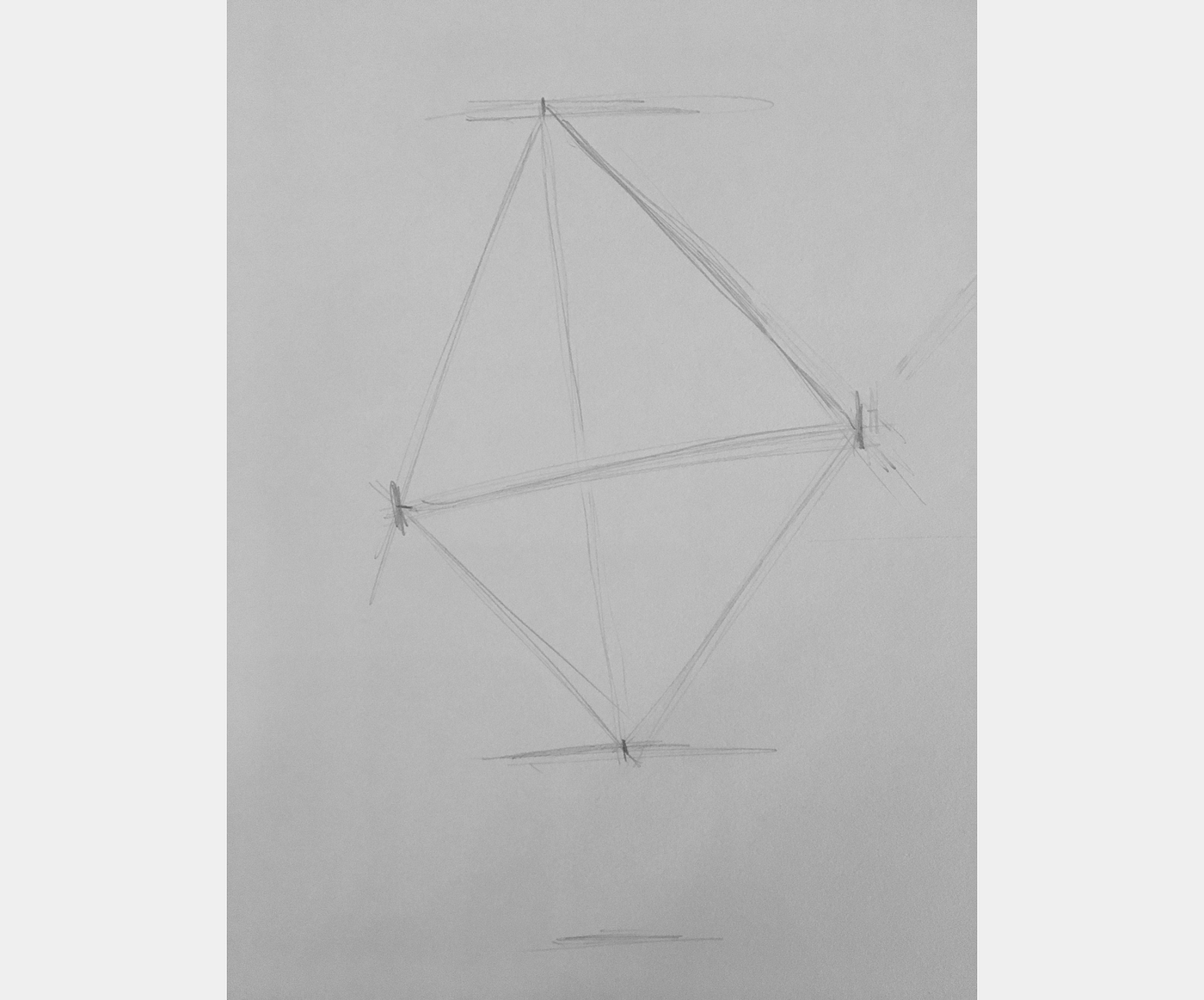
This one looks right on the money.

With each of the sketches, unlike with my Derren Chocolate-brown portrait, I felt that I was able to see the bending on the subject field and accurately replicate it on the page with limited effort.
This is a good sign…

Yesterday, I practiced triangulating the proportions of a few celebrity heads.
For example, here's i I did of Natalie Portman.
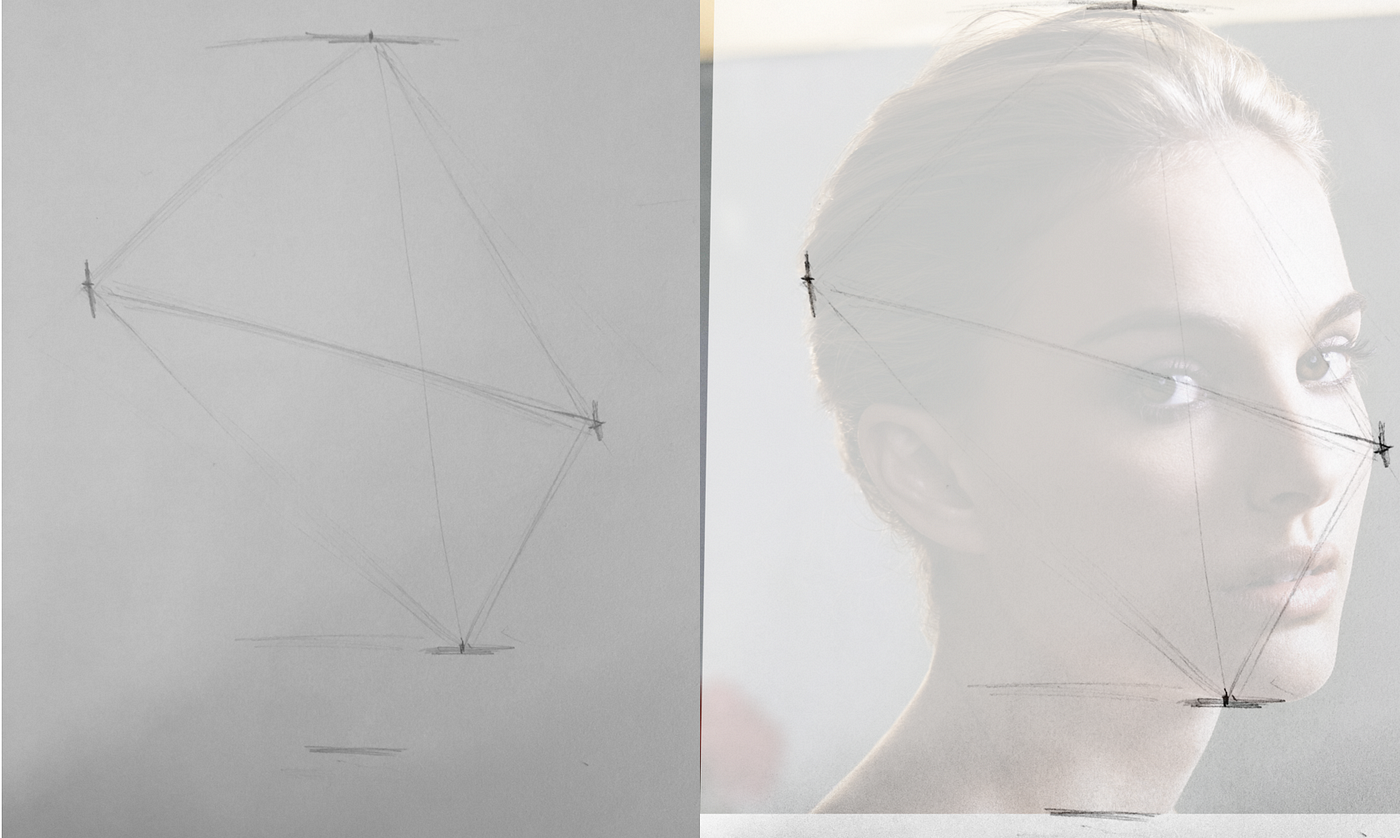
Today, I practiced triangulating the complete head shape and gauging the level of features.
It took almost 45 minutes.
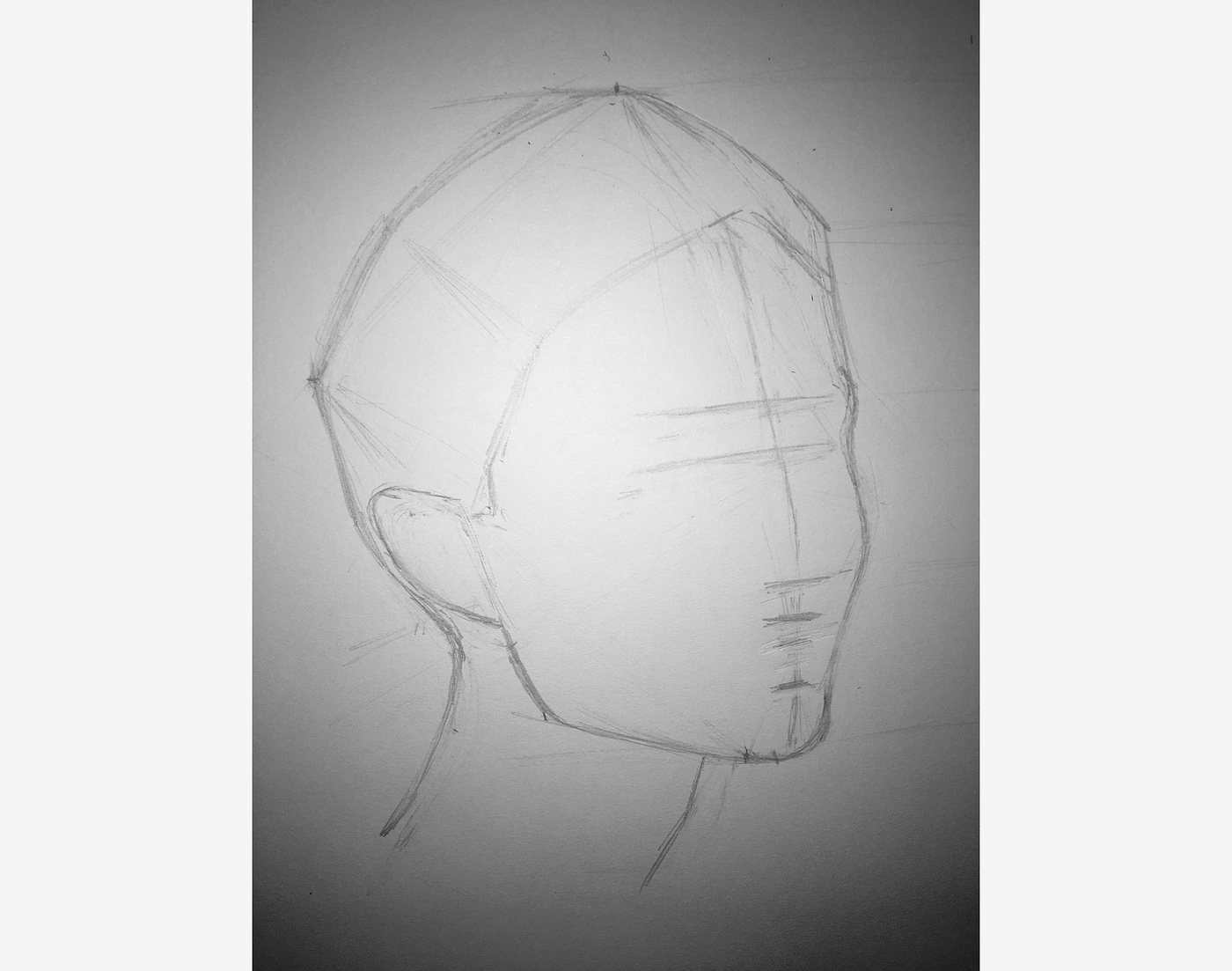
To assess my work, I overlaid the sketch on Natalie.

My Critique
- The face shape is accurate
- The level of the features is accurate
- The bending of the features is accurate
- The middle line curves a little too quickly as it moves upward between the eyes
- The neck shape is inaccurate — I particularly misestimated the starting betoken of the cervix on the right side.
- Above the correct eye, the angle of the head/hair is too steep
- The peak of the head is also steep
- The bending of the hair higher up the ear isn't steep enough
Overall, I'd give the sketch a B-.
Since I was accurate with the face shape and the level of features, if I continued working, I doubtable I would develop the face fairly accurately. Equally a outcome, I would likely accept enough authentic information to gradually correct the major mistakes with the head and pilus shape.
Tomorrow, I'll do again on a different celebrity.

Today, I didn't have also much time to describe. So, I quickly progressed the Matt Damon sketch I started 2 days ago.
Here's what I shared on Dominicus.
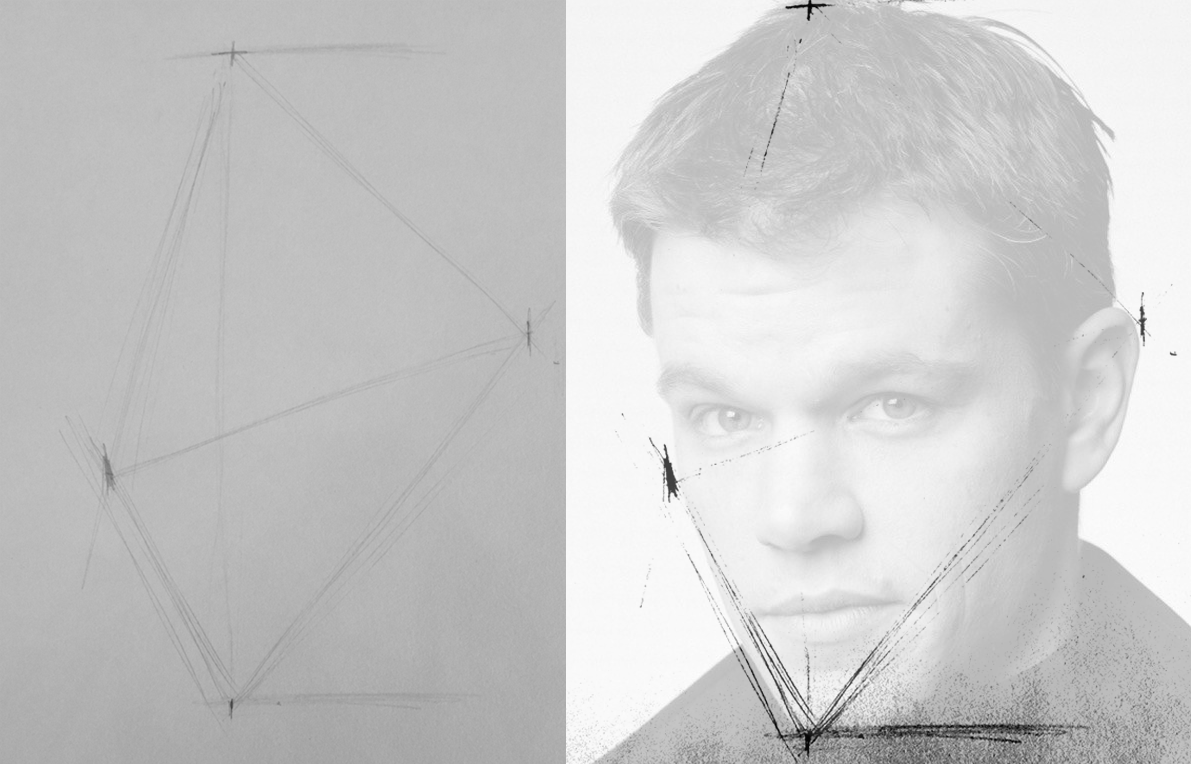
Today, I spent 30 minutes sketching the head shape and characteristic guides.
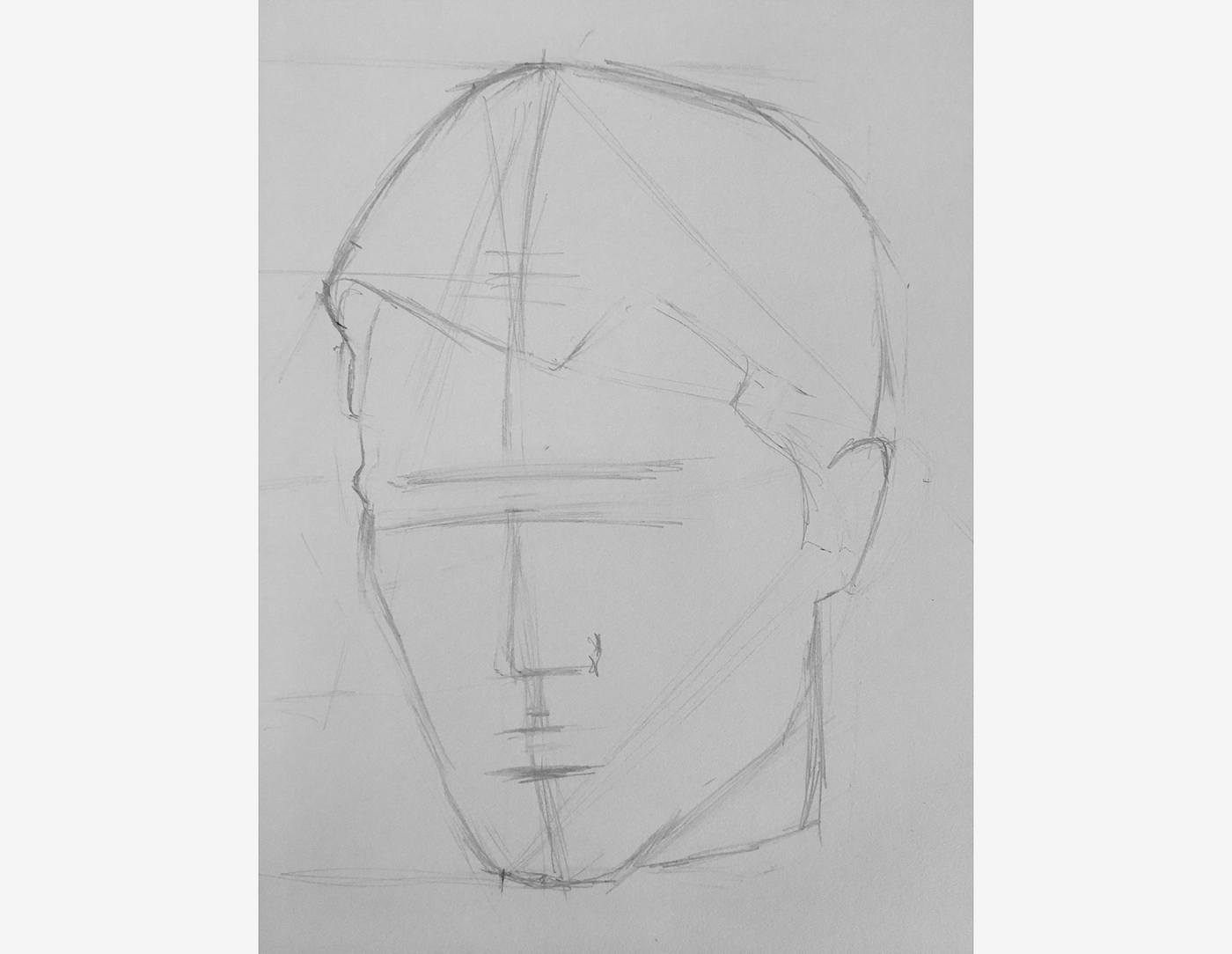
Just looking at the sketch, the caput shapes seems a little narrow for Matt Damon. But, overlaid on the photograph, it seems to match upward.
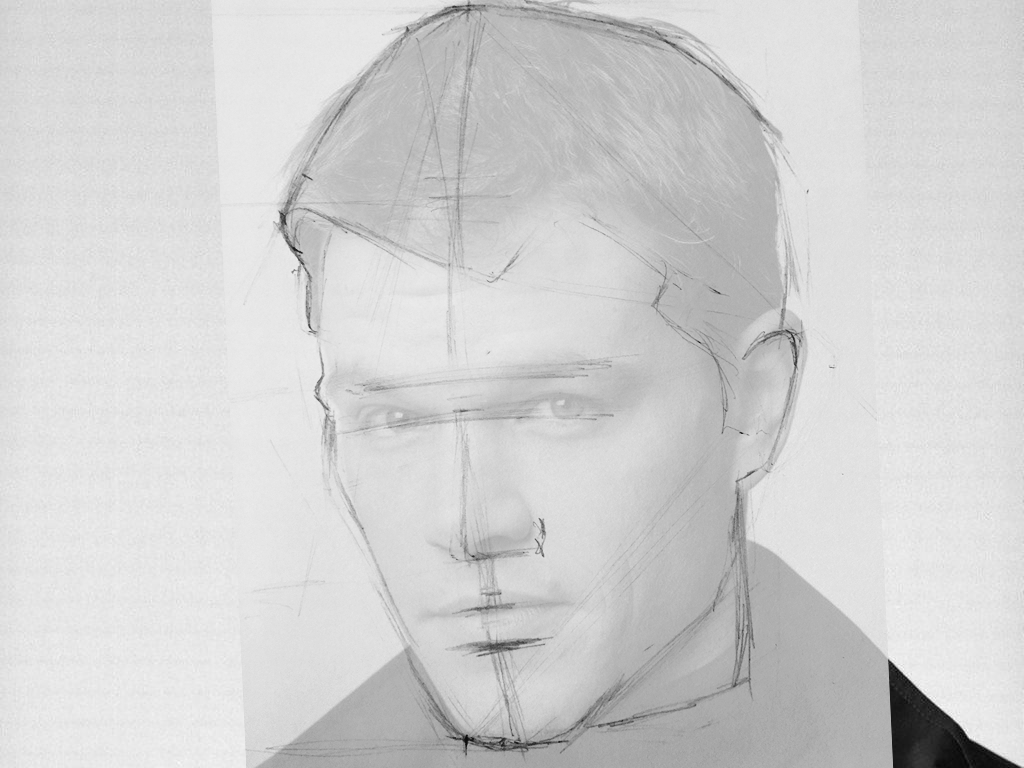
With the exception of the oddly tiny ear, everything else seems to line up well. The head shape, face shape, and hair shape seem accurate. The level of the features and the center line seem authentic. The fly of the nose is a bit too far to the right, simply I really only threw that in for fun.
Overall, I'm pretty happy with the upshot — especially since I sketched this fairly quickly. I guess that means I'm improving…

Last calendar month, when I was learning to memorize a deck of cards at grandmaster speeds, I started unintentionally seeing playing cards in the real-earth. In particular, real-globe things (similar wheelchairs and airplanes), which have association in my mnemonic system, were triggering images of playing cards, without whatever witting thought on my function.
But, I was rewiring my brain.
This month, as I learn to draw faces, I'm experiencing a new phenomenon… For the past few days, I've institute myself scrutinizing and deconstructing other people'south faces on the train, at work, on the street, at Whole Foods, etc. Wherever there is a face, I tin can't aid but try to analyze it, and imagine how I'd draw it.
Now (and I hope this eventually wears off), when I see a new face, my outset instinct is to estimate the ratio between the acme and width of the head. Other times, I just await to meet what shapes the eye sockets are. Or how prominent the brow ridge is. Or if the nose and brows equally break the face up in thirds.
Basically, I tin can't stop staring at people.
So, thank y'all people of San Francisco for non getting totally creeped out. I promise I'll end soon.

For the past couple days, I've been itching to outset my cocky-portrait. So, today, I did just that.
After working for about an 60 minutes, I was able to finish sketching the outline of the head, pilus, and neck.
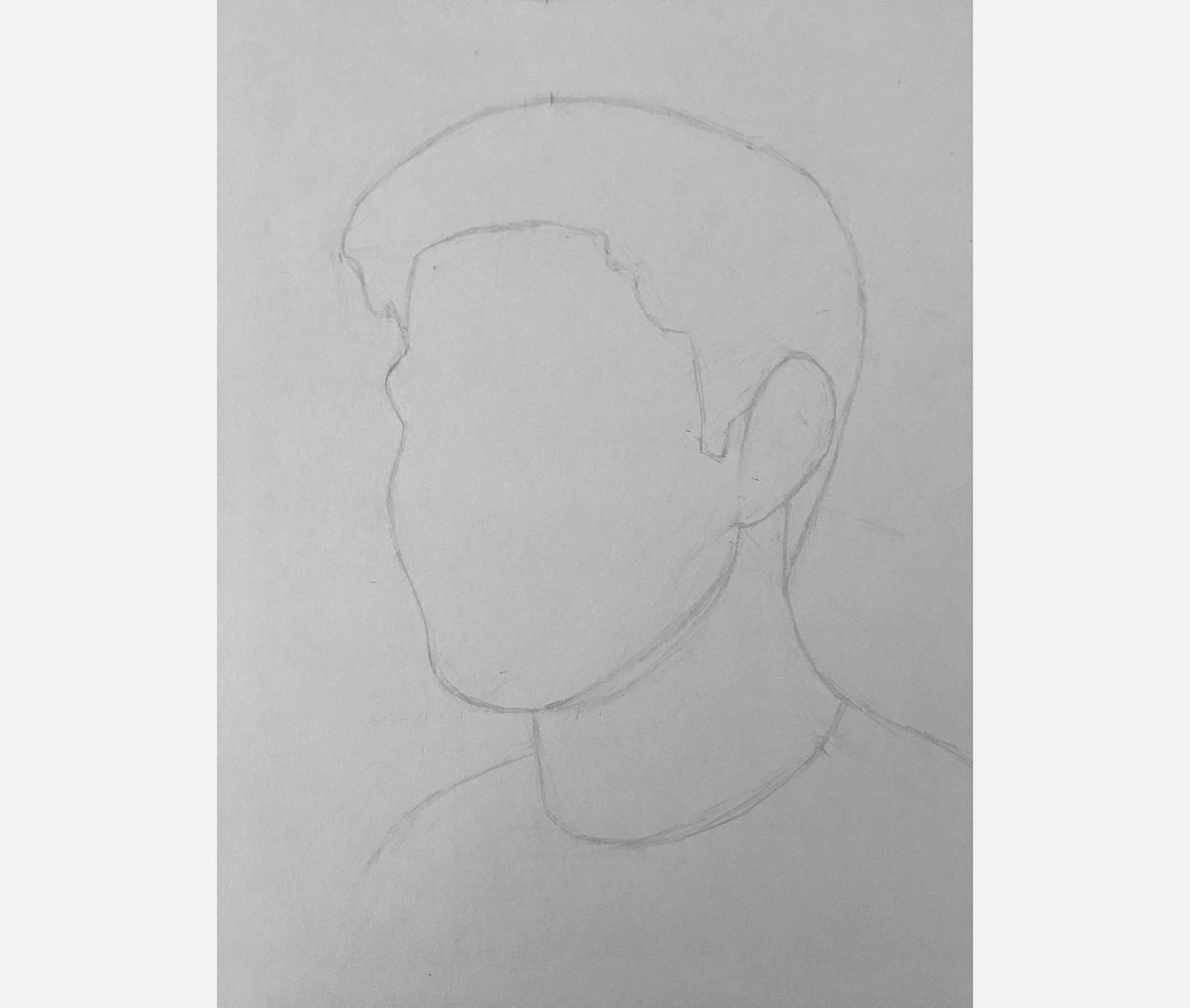
And here's a video of today's progression.
So far, so adept. Tomorrow, I'll start blocking in the features.

Today, I continued working on my cocky-portrait. Although it's coming together nicely, I made a mistake upfront that'due south definitely costing me now.
Earlier, I get to that, though, let me first share today's progress.

My fault
Although I'm loving the composition of my self-portrait, I've sadly depict everything 10–20% likewise small-scale.
Take a look at the self-portrait side-by-side with the Derren Brown portrait. My caput is noticeably smaller.
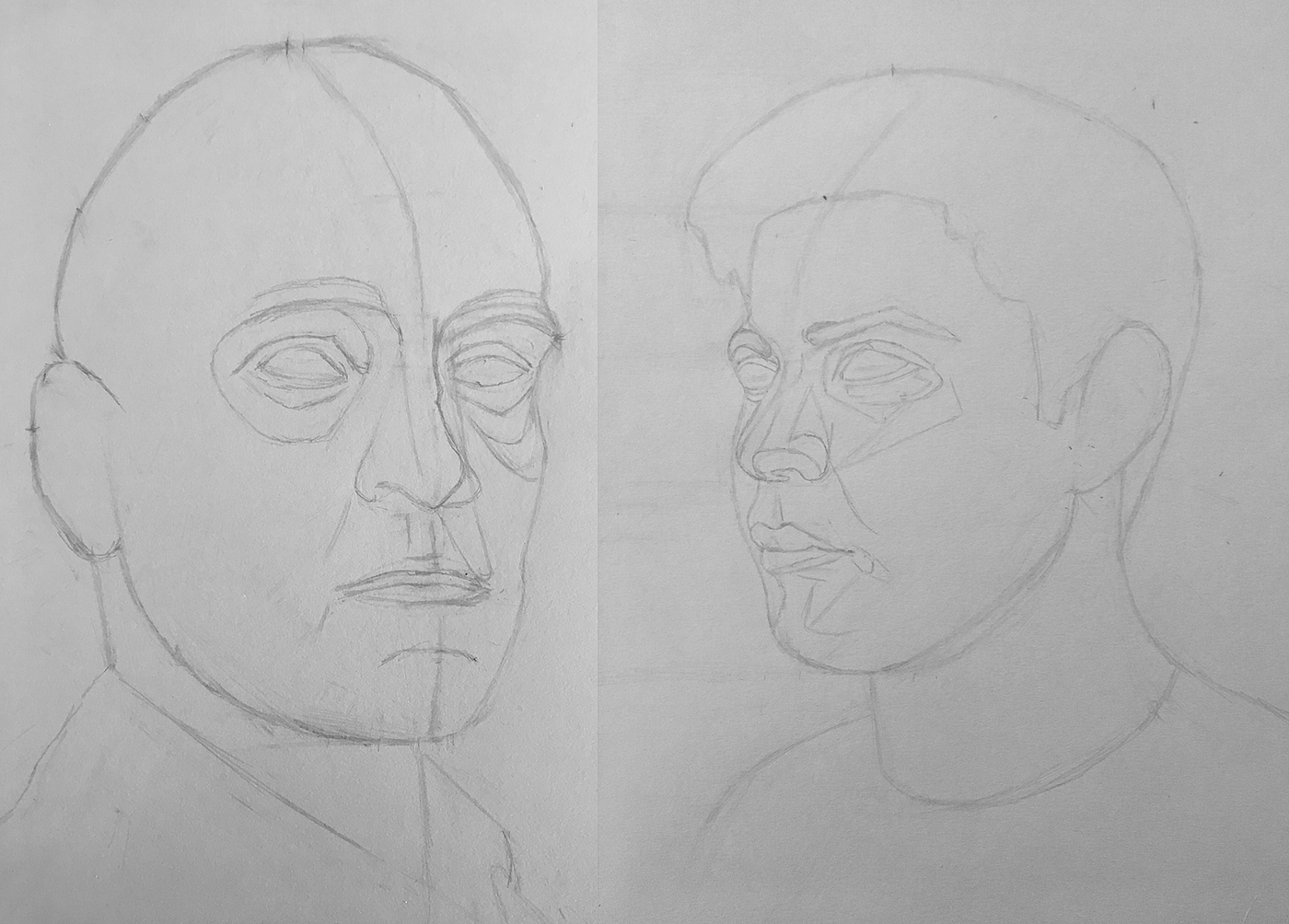
Again, I think this is okay compositionally, only it's nonetheless a scrap of a problem — particularly, for 2 reasons.
- A smaller cartoon offers smaller margins for error. If I slightly misplace the corner of the mouth or the height of the brow, the altitude between the correct and incorrect placements represents a proportionally larger departure on a smaller drawing. In other words, smaller drawings are less forgiving and errors are more pronounced.
- A smaller drawing means finer details. My pencil sharpener doesn't seem to work very well with the pencils I have, which means I'one thousand drawing the tiny eyelids on my cocky-portrait with a tree trunk. Basically, the smaller drawing requires that I work in finer areas, which is challenging with the tools I have.
Withal, I will persist, since, even with the sizing error (and the associated challenges), I'1000 quite happy with the portrait so far.
In fact, challenges are probably a good matter (I hope). Ideally, they push me to become a better artist.
Anyway, I think the takeaway is that I need to invest in a ameliorate pencil sharpener…

Today, my self-portrait progress is broken into ii parts:
- Finishing the sketch
- Defacing the sketch (a.yard.a. adding tonal values)
Finishing the sketch
Yesterday, I was able to sketch about 80% of the portrait. Today, I but need to add together the last details.
I kickoff by blocking in shadow areas near the mouth, on the brow, and on the neck.

Then, I darken the pilus and eyebrows.
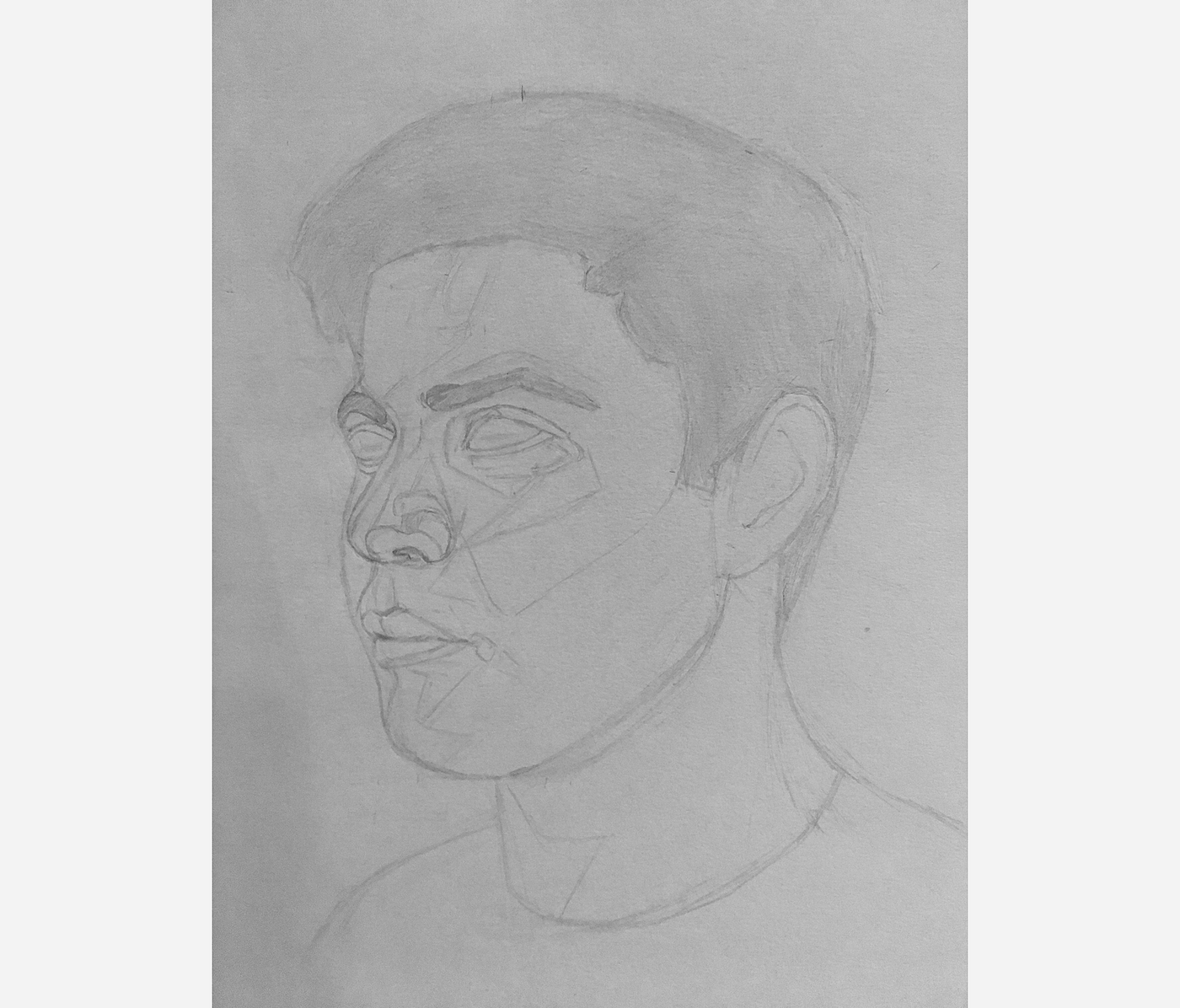
I add detail to the eyes, and the portrait jumps to life.
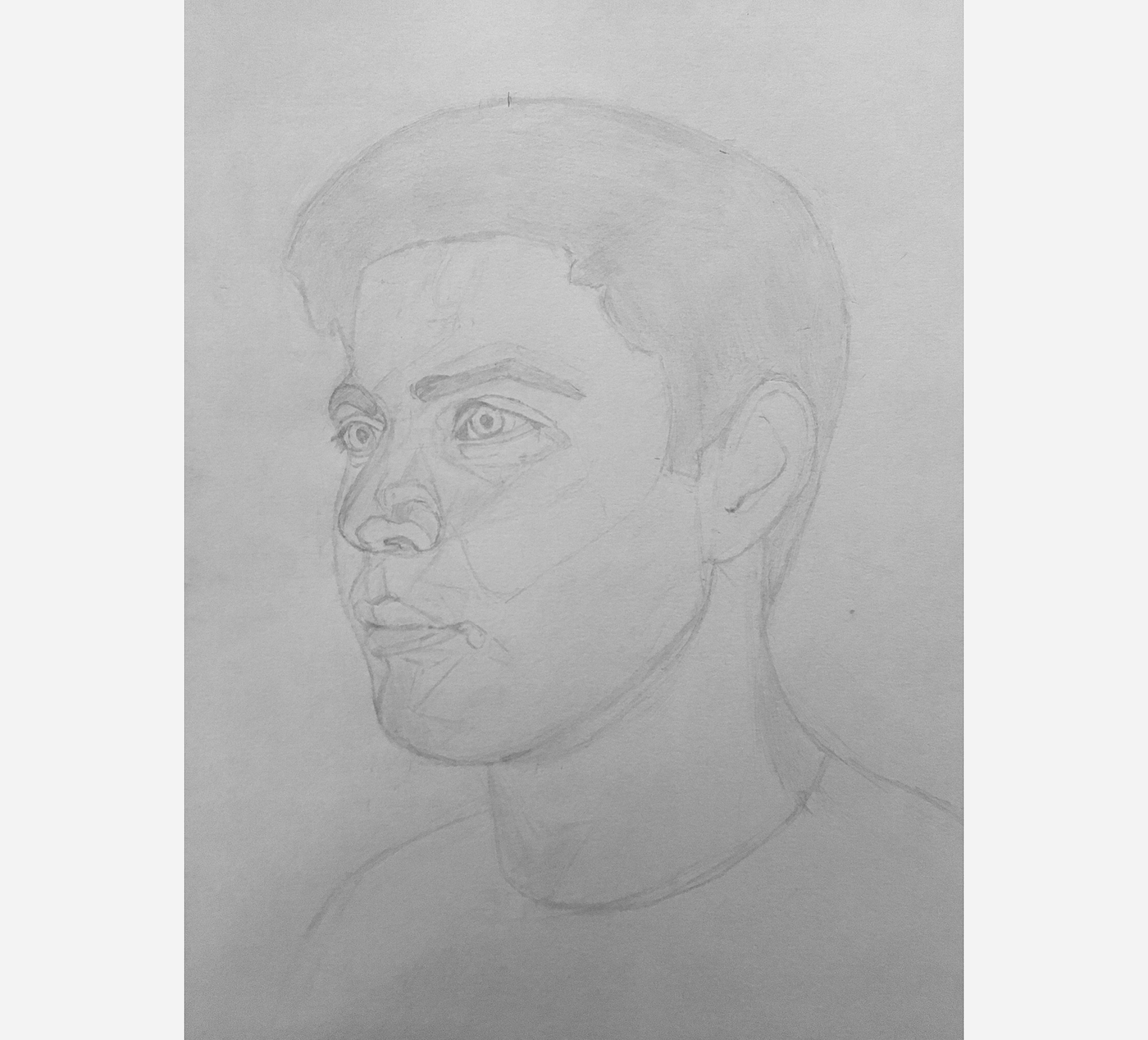
Finally, I detail the ear, which is one of my favorite parts of the whole procedure. (Ears are just weird looking and fun to draw)
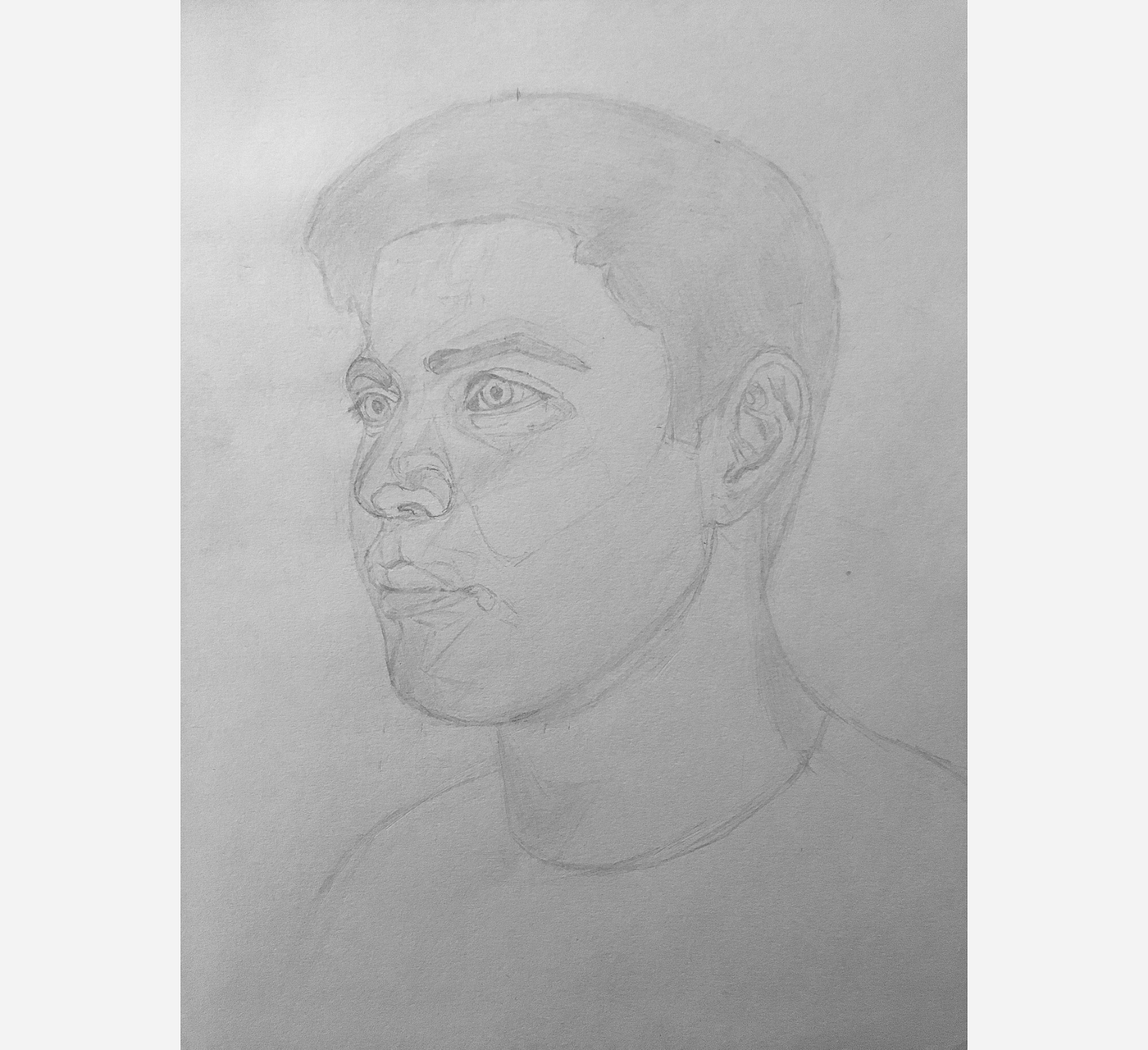
With the ear done, my sketch is complete.
Interestingly, this completeness is a bit problematic: Because the sketch feels whole (and, from my perspective, represents an interesting, standalone slice of fine art), I struggle to proceed working on information technology.
The portrait only feels balanced at this point. As presently as I start adding tonal values, that remainder will be disrupted, and won't render until I'one thousand nearly washed with the whole portrait.
It almost feels unnatural to add together tonal values to the sketch, as if I'm defacing something I worked difficult to create.
Nevertheless, I must continue. So, here I go… Time to temporarily deface my work.
Defacing my portrait
I commencement by blackening i of the eyebrows. This is easy, and hopefully will assistance me build momentum.
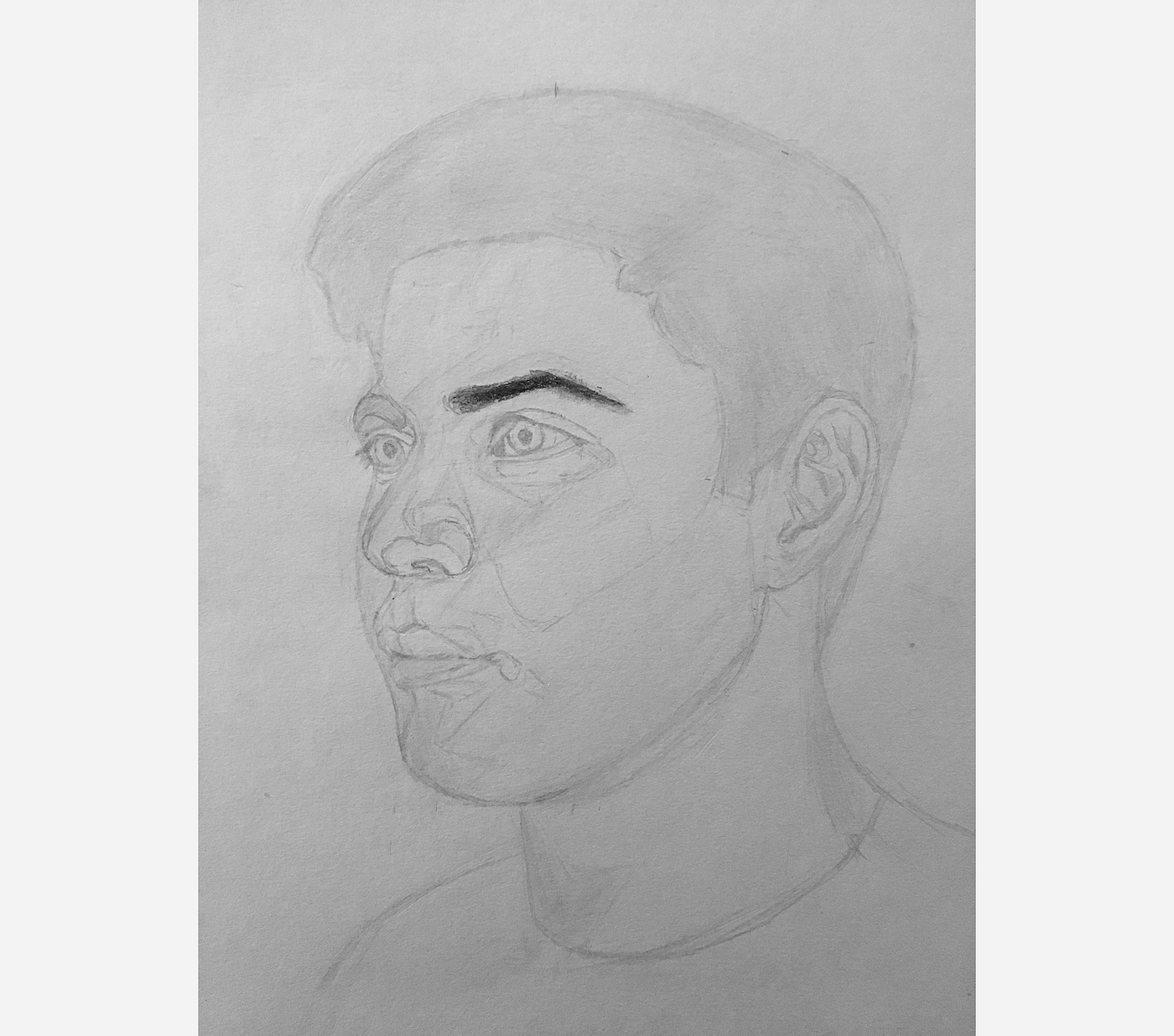
I continue with my black pencil, darkening the other eyebrow and the hair.
I can't seem to easily become the pilus to be one smooth blackness mass. Instead, the grain of the paper is very noticeable, giving me a dainty salted look. Fifty-fifty afterwards aggressive blending with a blending stump and a dry out castor, I still can't get the textile distributed nicely on the paper.
I may need to invest in some powder graphite (but I'll return to this later).
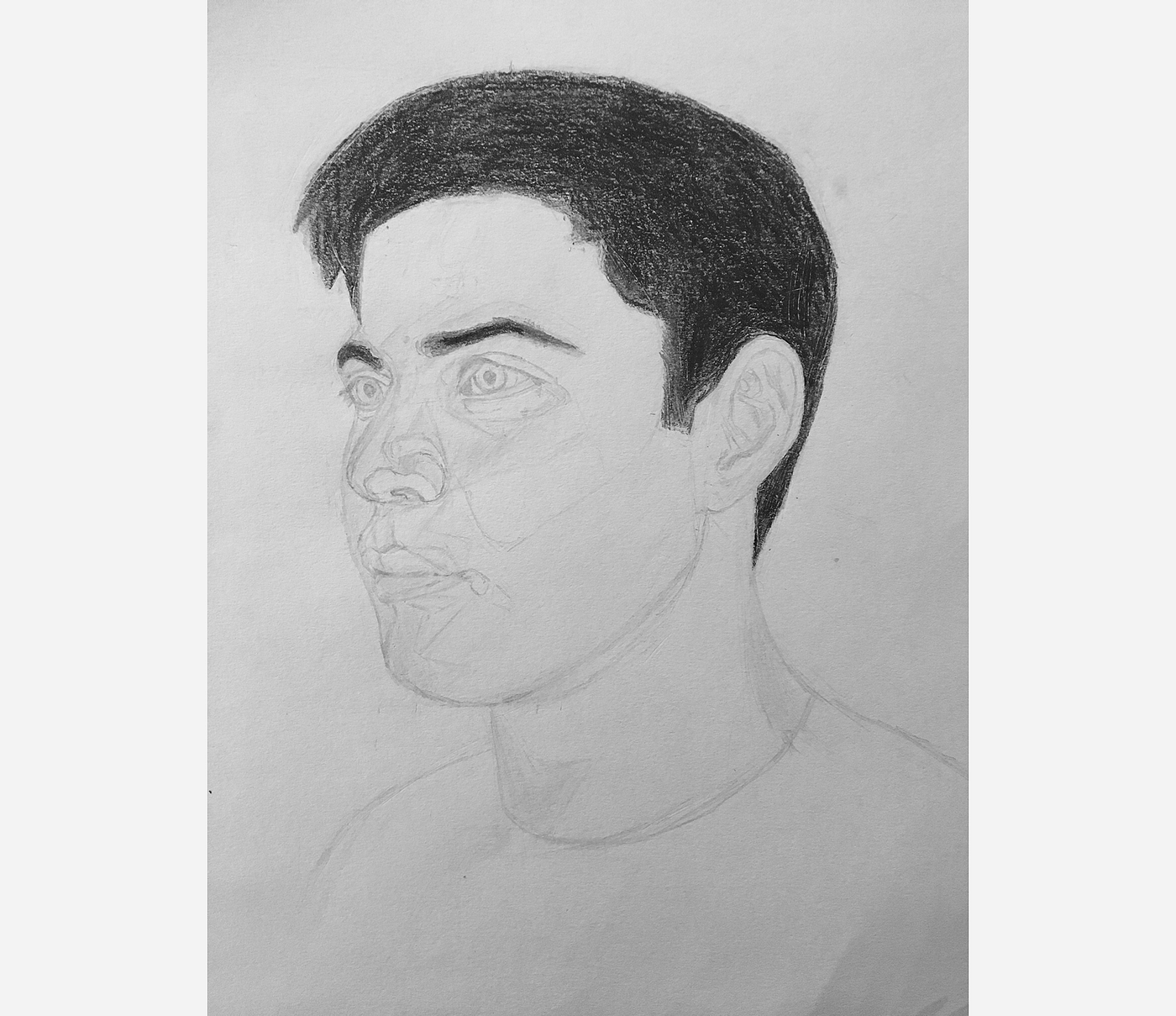
Next, I start on the prominent eye. This is where the real defacing starts, as it's going to be a while until it doesn't wait like I'm wearing makeup.
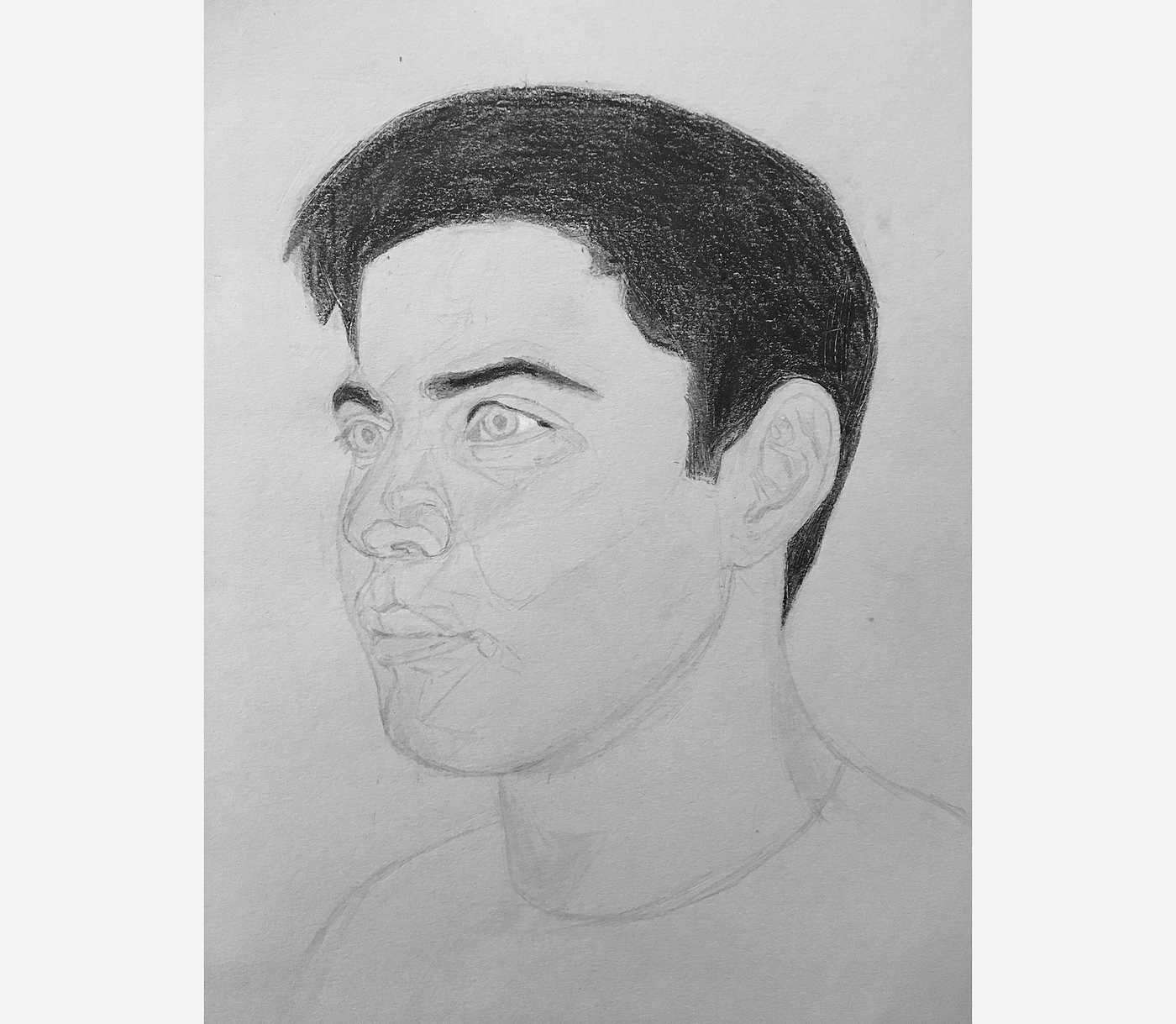
After many more minutes of work on the centre, I stop for the nighttime. I'll continue more tomorrow.
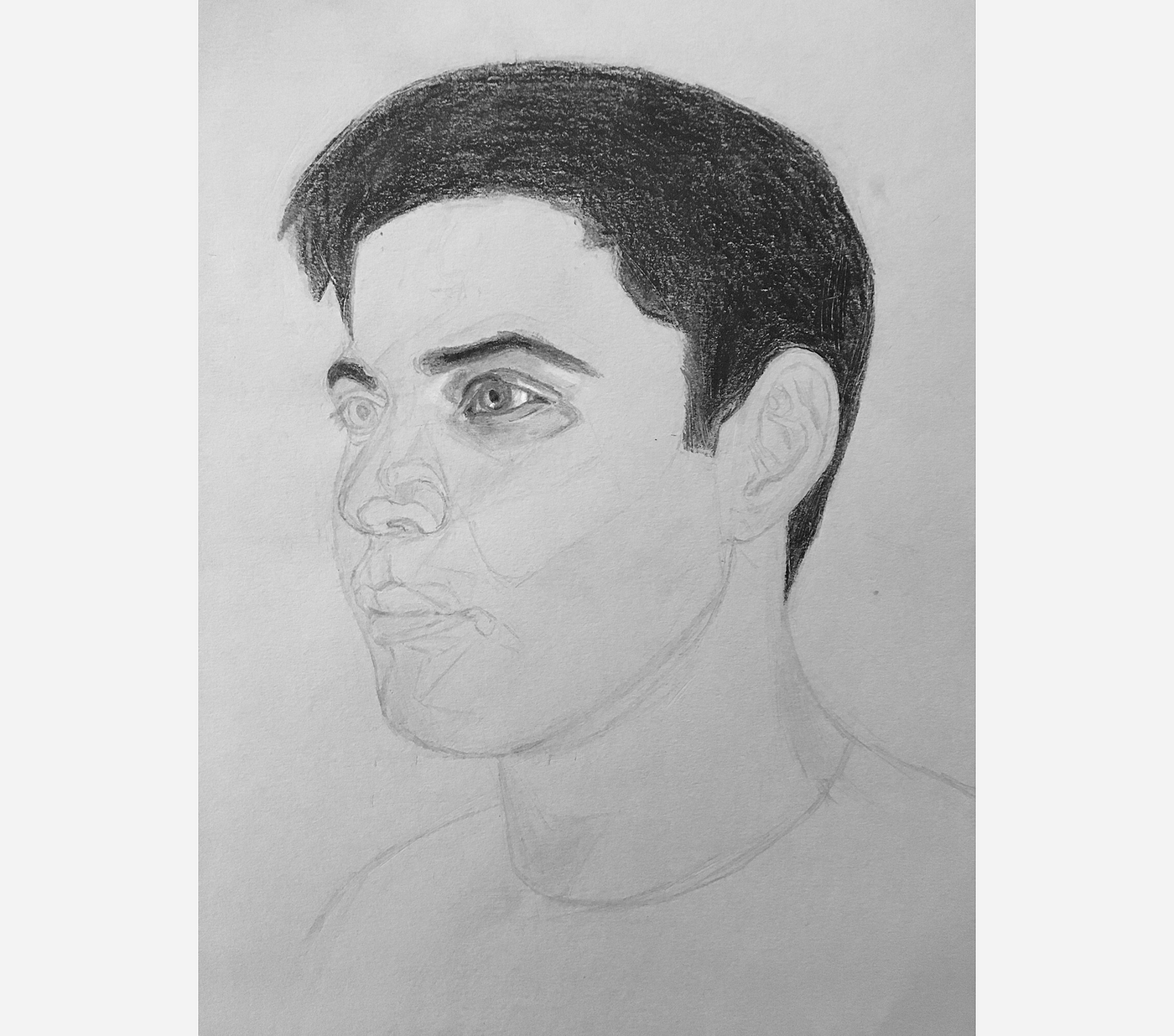

Today, I spent a couple hours working on the eyes and nose expanse of my self-portrait.
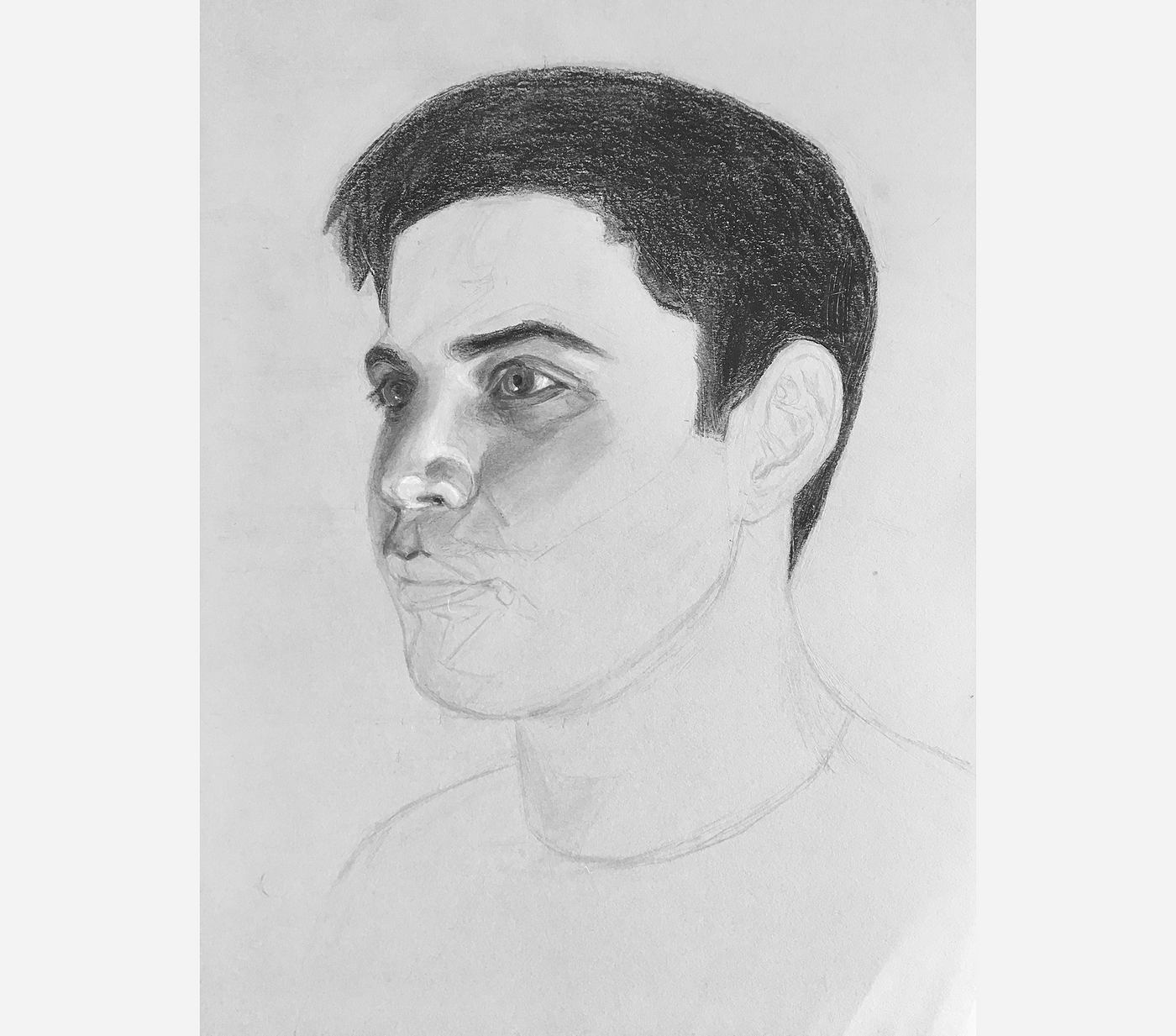
My tonal approach is noticeably different than that used on the Derren Brown portrait.

With Derren, I wanted to ensure the portrait emanated three-dimensionality, so I pushed aggressively on the contrast of the portrait. I also didn't care much for the micro-gradations of shadow/light, as I was more than concerned with the definiteness of the bigger shapes.
As a result, the portrait definitely has a stunning roundness, but I wouldn't call it photorealistic.
Thus, this time around, with my self-portrait, I'm aiming to more closely match tones, while also paying attention to the smaller areas of low-cal fall-off. With this attending, my promise is to create a more realistic rendering of my face.
It's still hard to tell whether I'll be successful, but we'll find out soon…

In nearly of my posts, I tend to be pretty positive (i.due east. "Whoa, today went ameliorate than expected…", "I'chiliad really pleased with today'due south progress…", "I can't believe how good this is…", etc.).
This is more often than not because I'1000 very bullish on this entire project.
Nevertheless, in my past three posts (I made a mistake, Intentionally defacing my cocky-portrait, and Fighting for photorealism), I've tried to interrupt this trend, and share some of the day-to-twenty-four hours challenges I face up.
While I am nonetheless very positive about this project, and happily take on the micro-challenges, I thought sharing some of these things would be more interesting than writing near how every mean solar day is always better than the concluding.
Anyhow, continuing with this theme, today, I want to share an interesting struggle.
The Calorie-free Situation in San Francisco
For some (perhaps, legal) reason, most apartments in San Francisco don't have overhead lights in their main living areas. Normally, apartments only have overhead lights in the bathroom and (sometimes) the kitchen, which is the instance for my apartment.
As a issue, the residue of my apartment is lit via Ikea floor lamps, which, although they practice a 90% adept job, it turns out, at night, there's but non enough light for item-oriented drawing.
During the sketching phase of my self-portrait, I didn't need to run across precise tone, so sketching at night was no problem.
However, now that I'chiliad trying to carefully model the lights/shadows of my confront, I need more light.
I considered drawing in the bath, but this isn't entirely comfortable. Especially because I was worried that the portrait would go moisture/damaged on the sink, whose counter is the most viable drawing area.
Since, without deconstruction, the kitchen table doesn't fit through the bath door (I tried…), I needed to find somewhere else to work tonight.
I concluded up across the street from my flat at a well-lit coworking space, which was groovy for drawing, but not-so-great for picture-taking. The affluence of overhead lights meant that, however I positioned my body, I was always casting a shadow on the portrait.
Thus, once I finished cartoon, I came back to my dark apartment to snap a photo.
After my lite-seeking take chances, here'due south what I was able to accomplish.
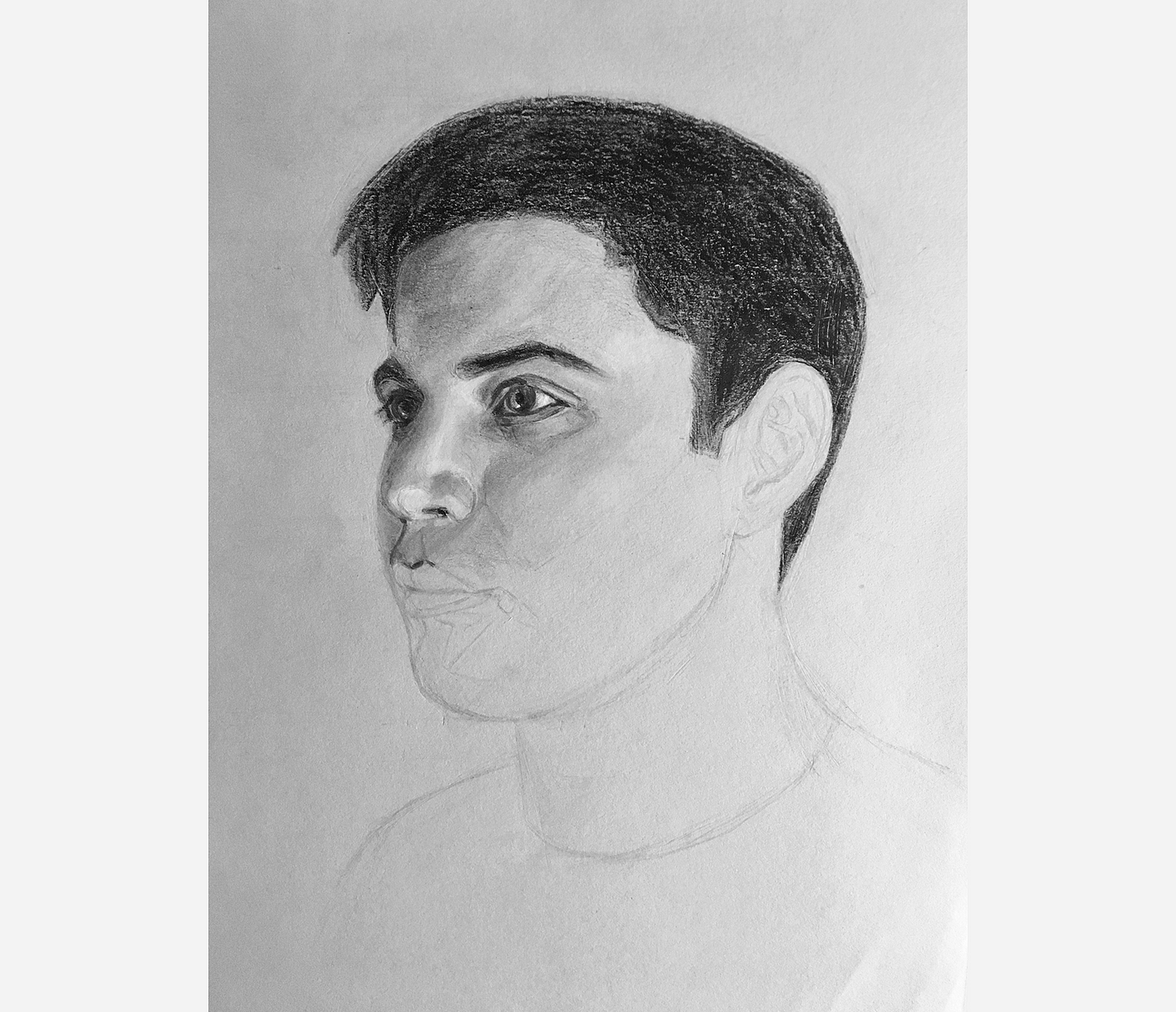

Today, I only had x minutes to depict, then I spent all x darkening the hair and eyebrows on my self-portrait, until they were as black every bit I could become them.
This profoundly improved the portrait in two ways:
- The relative tones of the face to the hair are much more accurate now, which helps with realism.
- The shape of the hair on the left side of the portrait wasn't quite right, so this gave me the hazard to fix it.
Here'due south the before…
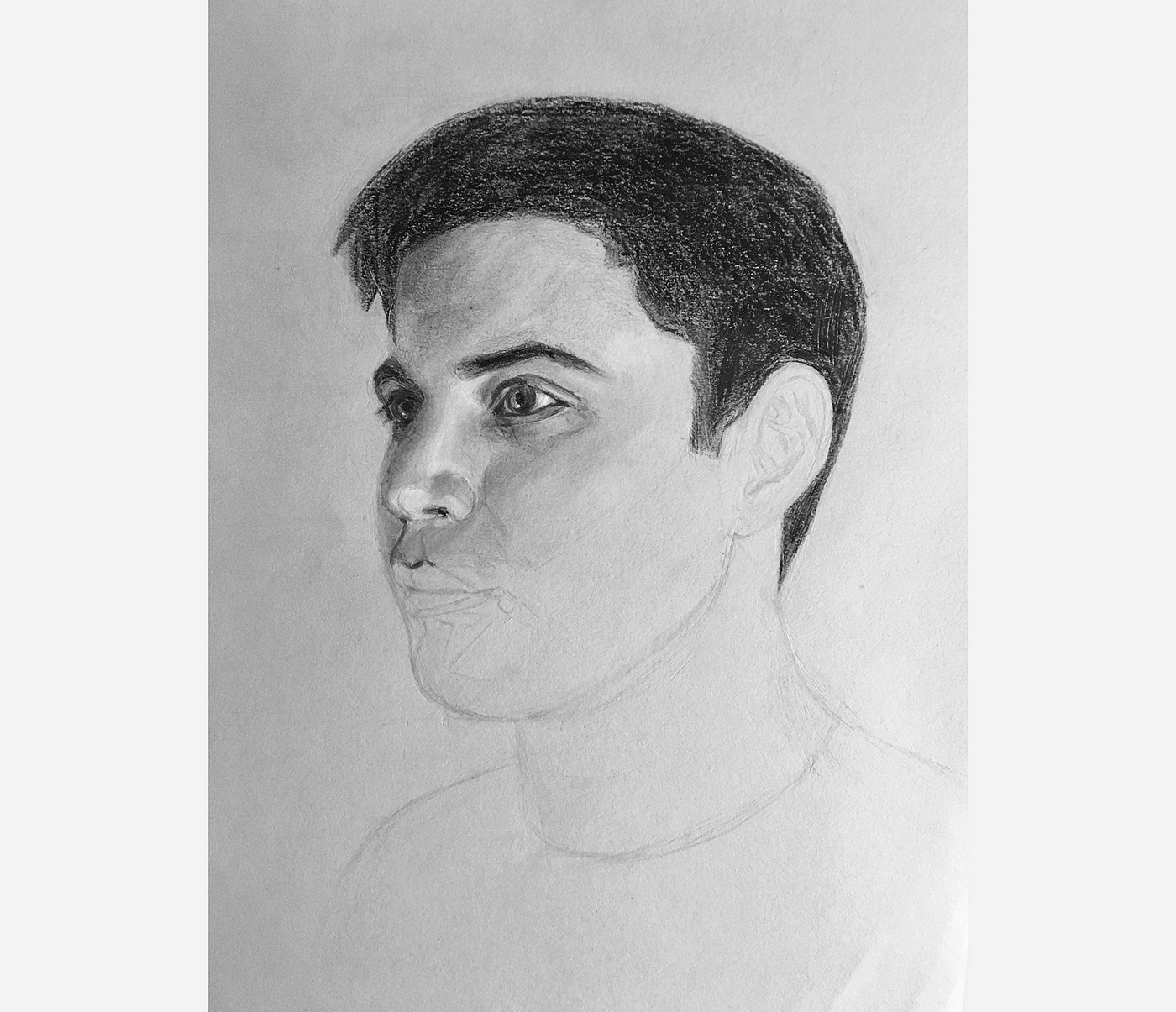
And the later on
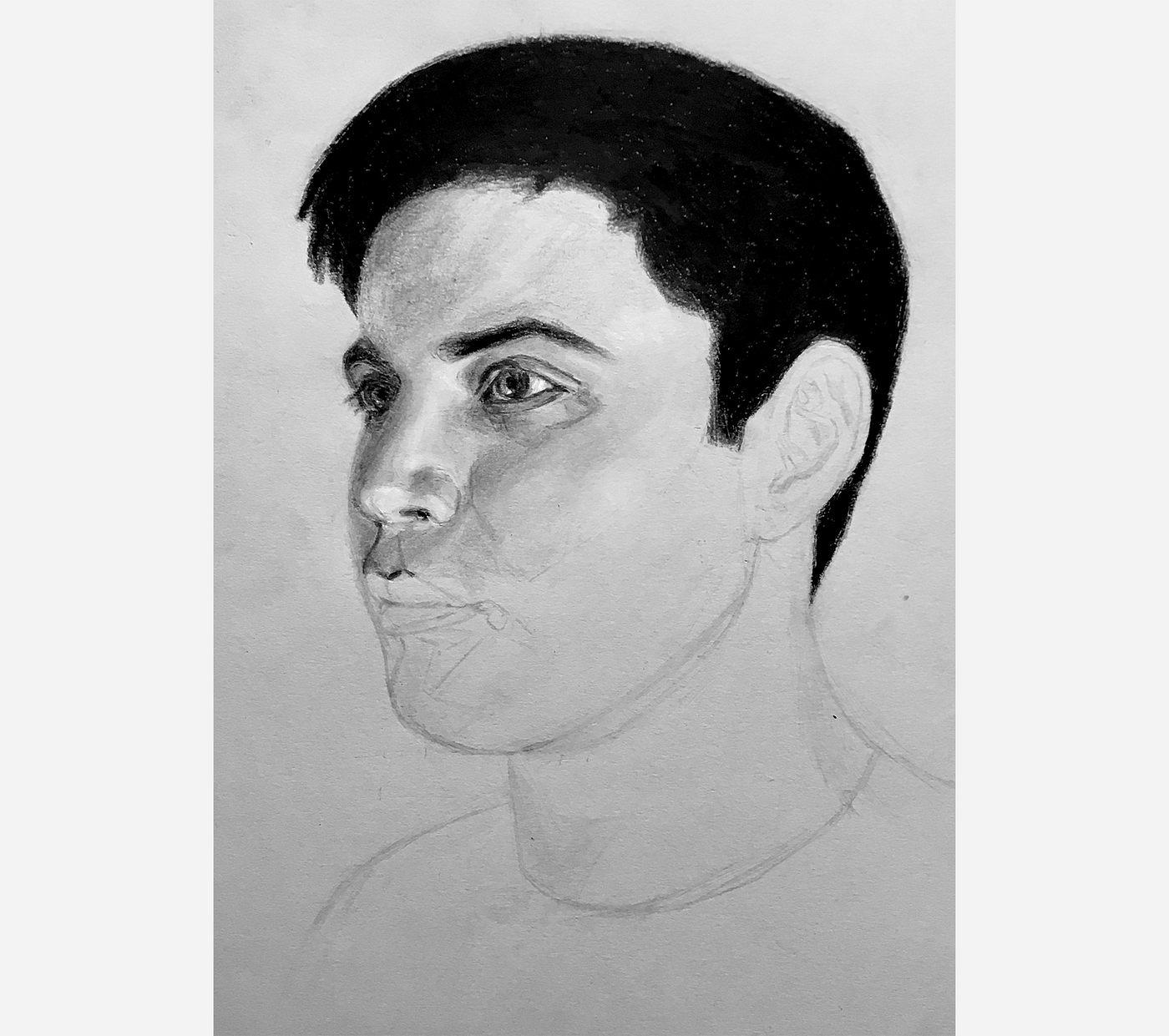
At offset, the blackness of the pilus is a chip jarring, but it accurately represents the "exposure" I'm going for (where the hair is emitting no light, and thus, shows up as pure black).
Although today's darkening session improved things, the portrait still seems a fleck odd and unbalanced because of the nakedness of the mouth and cheek. I'll beginning tackling those areas tomorrow.

Yesterday, I declared that today I would get-go working on the mouth and cheek areas of my cocky-portrait. And nevertheless, somehow, the day is over, and the oral cavity and cheek areas are nevertheless naked.
Instead, I got caught upwards making micro-changes to the parts of the portrait I've already worked on (the optics, nose, brow, etc.). It seems I tin brand small improvements forever.
This is clearly not the right arroyo. Especially because… As I brainstorm shading the mouth, I will need to make adjustments to the olfactory organ expanse, so everything fits together. As I brainstorm shading the cheek, I volition need to make adjustments to the eye area, then everything fits together. And so on.
Perhaps, I'm simply stalling out of fear: Once the oral fissure and cheek are developed, I'll have a much amend idea if the portrait is any skilful.
If I am fearful, I definitely need to get over it.
To exercise and then, tomorrow, I'll focus, not on perfectly detailing the mouth and cheek, merely instead, broadly blocking in the right tonal values.
With the general tones in place, I'll have plenty momentum to push the portrait towards completion.

Today, I spent an 60 minutes developing out the rest of my self-portrait.
It went from looking similar this…
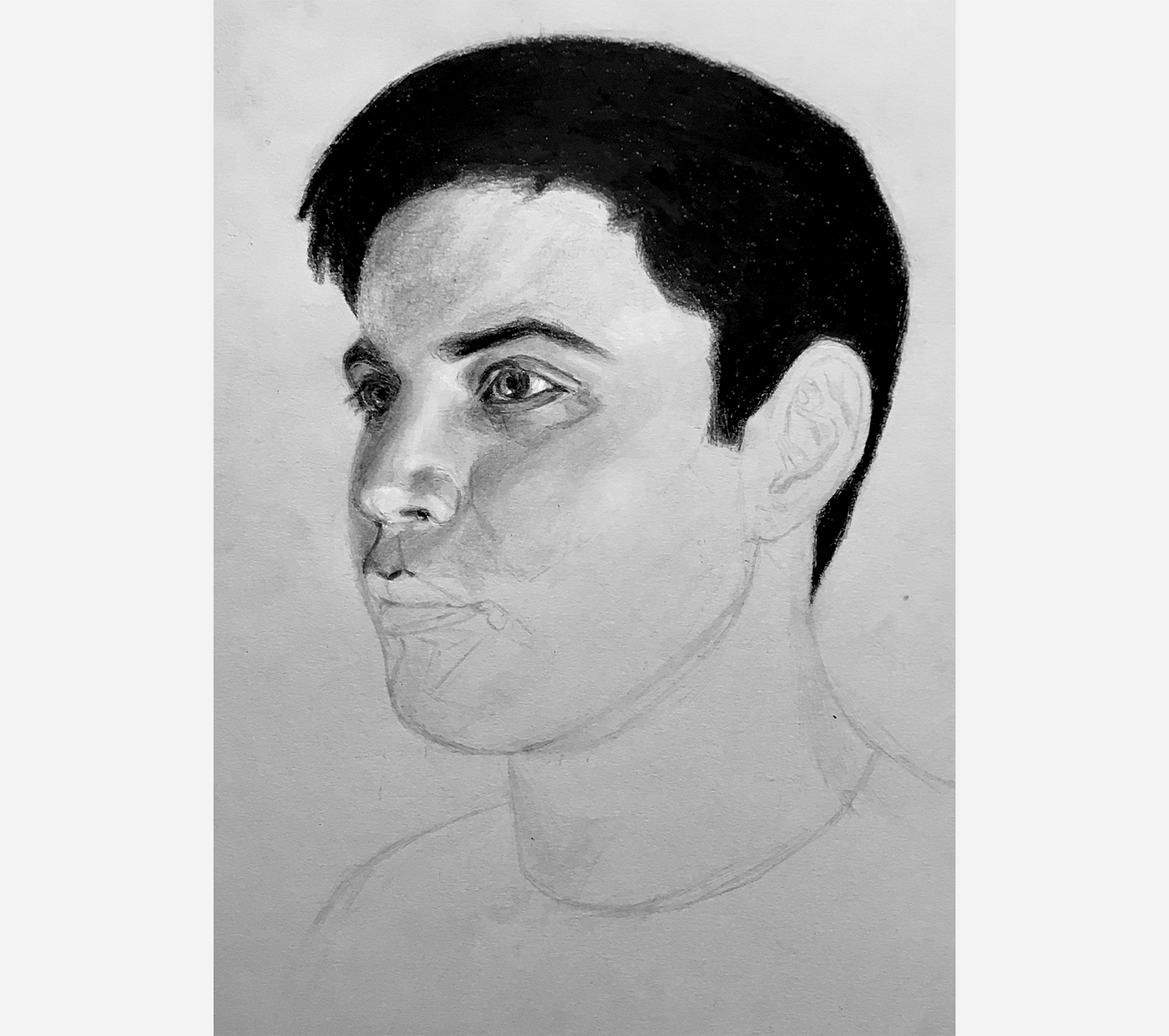
To looking like this.

Information technology'due south starting to await similar me, simply information technology still looks like a drawing — generally because I oasis't blended the newly developed areas like the neck, cheek, mouth, ear, forehead, etc. Pretty much the whole thing.
I've been holding off on the blending because my blending stump is unusably dingy.
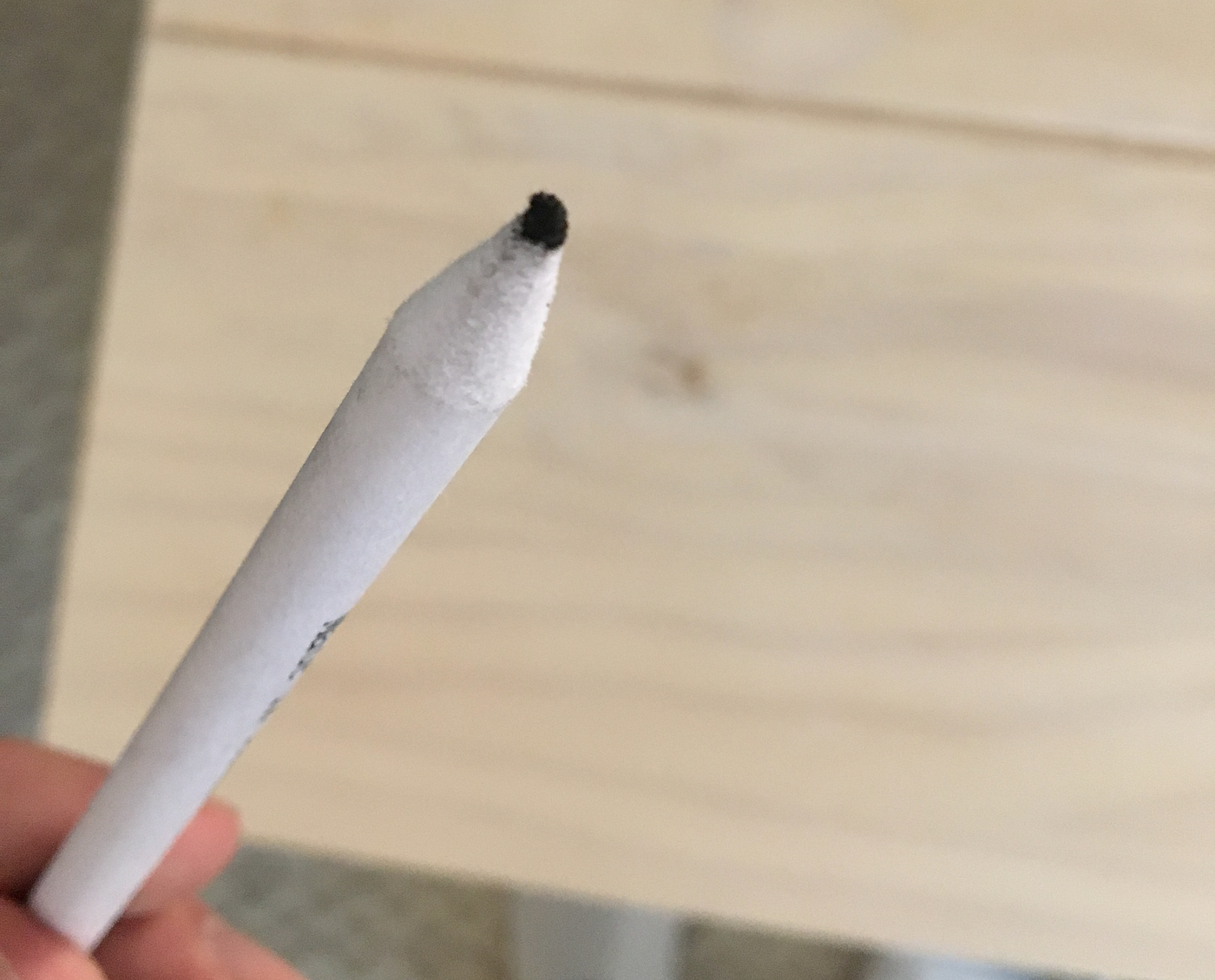
Tomorrow, I'll go swing by the art store and pick up a few fresh ones.

I picked up some new blending stumps today, and went to work smoothing the value changes over my face and cervix. Here'due south the result…

When compared with the before, the difference is pretty striking. In the earlier portrait, I look like a sickly, pencil-sketched version of myself, while the after version has a much nicer roundness and weight to it.
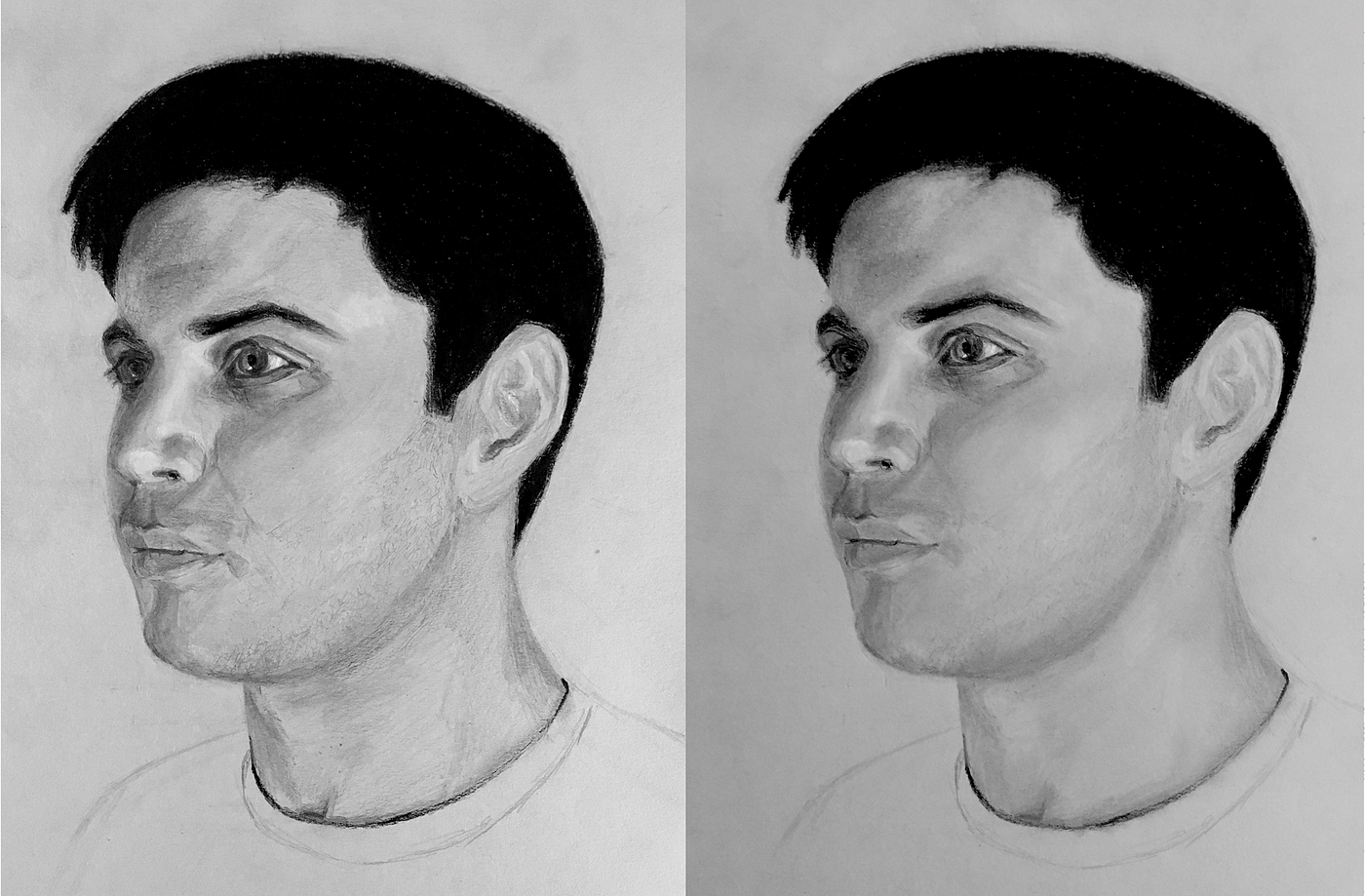
Tomorrow, I'll brand some minor tweaks, sign it, and hang it on the wall.

24 days agone, to kicking off December'due south challenge, I tried to depict a cocky-portrait.
Then, over the adjacent 3.v weeks, I completed a ten-hr drawing course, drew a few other people, and then spent 8 hours on a new self-portrait.
Here are the before and after.

And here'southward a time-lapse of the 8 hours of cartoon.
I'm happy with the result, and really think the cocky-portrait looks a lot like me.
Tomorrow, I'll write up a more thorough critique. Simply until so, I'yard declaring this month'due south challenge a success.

Yesterday, I alleged this month'due south claiming a success, noting the differences between my before and after self-portraits.

And while my nearly recent cocky-portrait is a major comeback, and does look very much like me, I still practise have some quick critical thoughts on it, which I've broken downwardly into two parts: 1. Likeness and 2. Artistry.
1. Likeness
- Overall, the likeness is strong. The portrait unequivocally looks like me. Although, it isn't perfect.
- My expression/emotion in the portrait is plausibly mine, especially in the eyes.
- The shape of hair near the ear and back of the head is very accurate. However, the hair line doesn't seem completely right, and information technology'south probably the second biggest reason why the portrait doesn't wait perfectly similar me. The pilus line should probably come down on the forehead and should be less rounded. When I snapped a photo of myself (on which I based this portrait), I had just gotten a shorter-than-normal haircut, which is probably why I'm not used to the haircut I drew.
- On paper, I feel I captured the nose perfectly, simply, as a outcome of the shadow, information technology may seem slightly too small/brusque. To address this, I could have accentuated the tonal departure between the cheek and the adumbral part of the nose, but I wanted to remain as tonally accurate every bit possible and chose non to.
- I'm very happy with how the neck turned out. Its weight and chief features (the Adam's apple and the notch at my collar line) seem authentic.
- There is something odd about the ear. It seems a bit out of place.
- The eyebrows may be the slightest chip sparse, but they are very close to reality.
- The biggest potential miss is my cheek. While I do have prominent cheeks when I grinning (which I'thou not doing hither), I too take a fairly slender face and a reasonably defined jaw. Depending on how I look at the cheek, it sometimes appears too circular and too full. Other times, when I look at the portrait, my eye renders this area properly. If anything, I probably could have fabricated the bottom of the face (in the rolling shadow) a bit more angular.
Nonetheless, even with these critiques in isolation, the portrait as a whole comes together nicely and captures a strong likeness. Thus, I've left information technology as is, since I care more nigh an overall likeness (versus a non-cohesive drove of individually accurate features).
2. Artistry
Before I drew my self-portrait, I drew a portrait of Derren Brown.

This portrait has ii big advantages over my self-portrait: one. The tonal range over the face up is much greater, and ii. The midtone of the face matches the tone of the newspaper.
With my self-portrait, I strayed from both of these advantages. For 1, on purpose. For the other, less so.
ane. Narrow tonal range
Purposefully, I chose to base of operations my self-portrait on a photo with a tighter tonal range, since I wanted to claiming and button my abilities (Cartoon a portrait with heavy contrast requires less subtly and is, in my stance, easier).
Arguably, the contrast of the Derren Brown portrait makes information technology a more than visually compelling portrait, simply this is some other topic completely (outset, I wanted to chief authentic portraiture before tackling well-composed portraiture).
Fifty-fifty with the narrow tonal range, my self-portrait still maintains a believable roundness and depth.
2. Dark midtones
Less purposefully, I chose a photograph where the midtone of my face up was darker than the paper.
This was a bit of a mistake, but a proficient learning opportunity. As a result of this determination, unlike with my Derren portrait, I had to pencil-shade the mid-tones on my face, leading to a slightly dirtier portrait. (In the case with Derren, where there were midtones, I left the bare paper untouched and clean).
Particularly before I smoothed out my face, information technology looked as if I had just been cleaning chimneys.
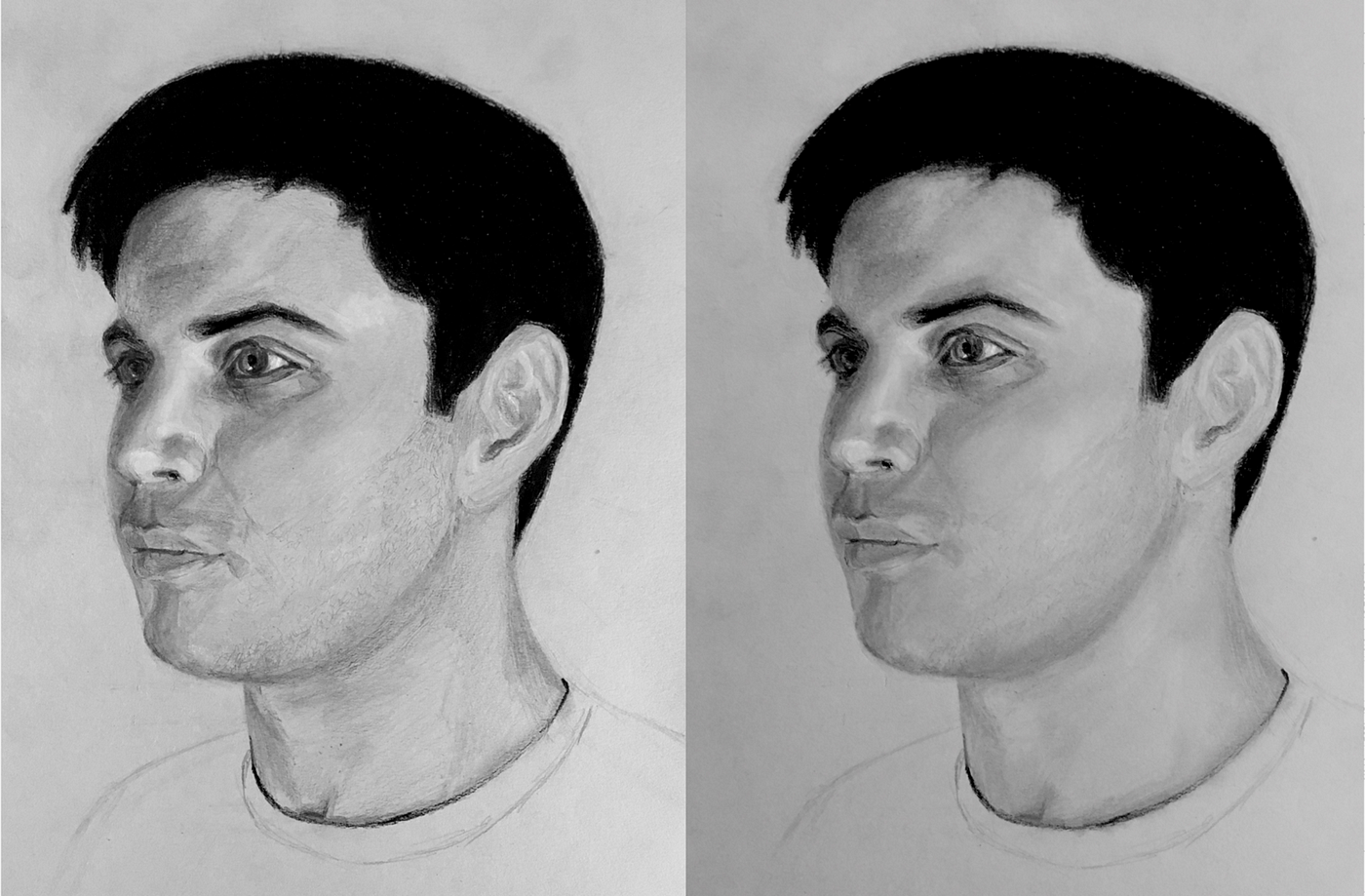
While the Derren Dark-brown portrait (with its ultra-contrasty tonal range) may exist a more dynamic portrait, my cocky portrait seems closer to photorealism, which is the master improvement I was aiming for.
Overall, I'thousand very happy with the outcome.

After spending nearly a month learning to draw portraits, I'k more than convinced than always that anyone tin can describe. Even if you lot don't accept any artistic talent.
To me, cartoon is a flake like doing your laundry. Before you practice information technology for the first fourth dimension, you feel information technology's much more complicated than information technology actually is, and thus, you lot experience incapable of trying. Then, you lot're shown that doing your laundry is only a matter of putting your clothes in the machine, pouring in some soap, and clicking a button. Much easier than yous thought.
It turns out drawing is very similar. From the outside, it seems much more than complex than it actually is. However, once you learn the ii or three basic principles, drawing (at least, at my level) becomes nearly as straight forward as doing your laundry.
In fact, in lodge to depict a reasonable portrait, you just need to know the two following skills:
one. Triangulation
2. "Outside-in" Shading
In one case you're equipped with these two techniques, you'll be prepare to follow the "Portrait Drawing Cheat Sheet" and draw your start portrait.
You'll be surprised at how well it goes. I know I was…


As I mentioned at the beginning of this calendar month, British illusionist Derren Brown originally inspired me to start drawing portraits. In fact, to acknowledge this inspiration, Derren was the bailiwick of my first portrait.

Withal, Derren didn't inspire me with his drawings, merely rather, his paintings, similar these…

Of class, these paintings are congenital on a prerequisite foundation of cartoon, but they as well innovate a whole new skill set that I would love to cultivate.
Watching Derren paint, it seems like there are clear parallels between shading a drawing and painting a portrait: He sets a mid-tone color, adds the lights and darks, works his fashion towards the center, and then adds detail.
At that place are also clearly major differences, like evaluating and mixing colors, general painting hygiene (letting paint dry out, etc.), and best practices I'm probably not yet aware of.
And while this seems like a major bound from my cartoon studies, I now take the artistic conviction to attempt a painting like this, without any (or very little) boosted instruction.
In the coming months, I plan to start sketching a portrait on canvas, and and then experimenting with pigment.

Concluding month, I memorized a shuffled deck of cards in nether two minutes, which required obsessive, consistent practice. If I were to stop practicing, over fourth dimension I would lose this skill.
However, I don't recall the same is true for my newly-found drawing skills. Mostly because… I didn't acquire anything new this month.
Well, that's not exactly correct. While I didn't cultivate any new cartoon-enabled motor skills or artistic skills, I did learned to structure my already-existing skills within of a better drawing process.
In other words, if I tin can think the process, which, in my opinion, just depends on two very straightforward insights, I will always be able to describe at the level I can now.
In 20 years, even if I don't practise from now until and so, as long as I can retrieve triangulation and outside-in shading, I will be able to fully replicate my results from this month.
I recollect that's a pretty cool thing, so look out for my Medium mail service in 20 years.

On December 1st, I drew this.

26 hours of practice later, I drew this.
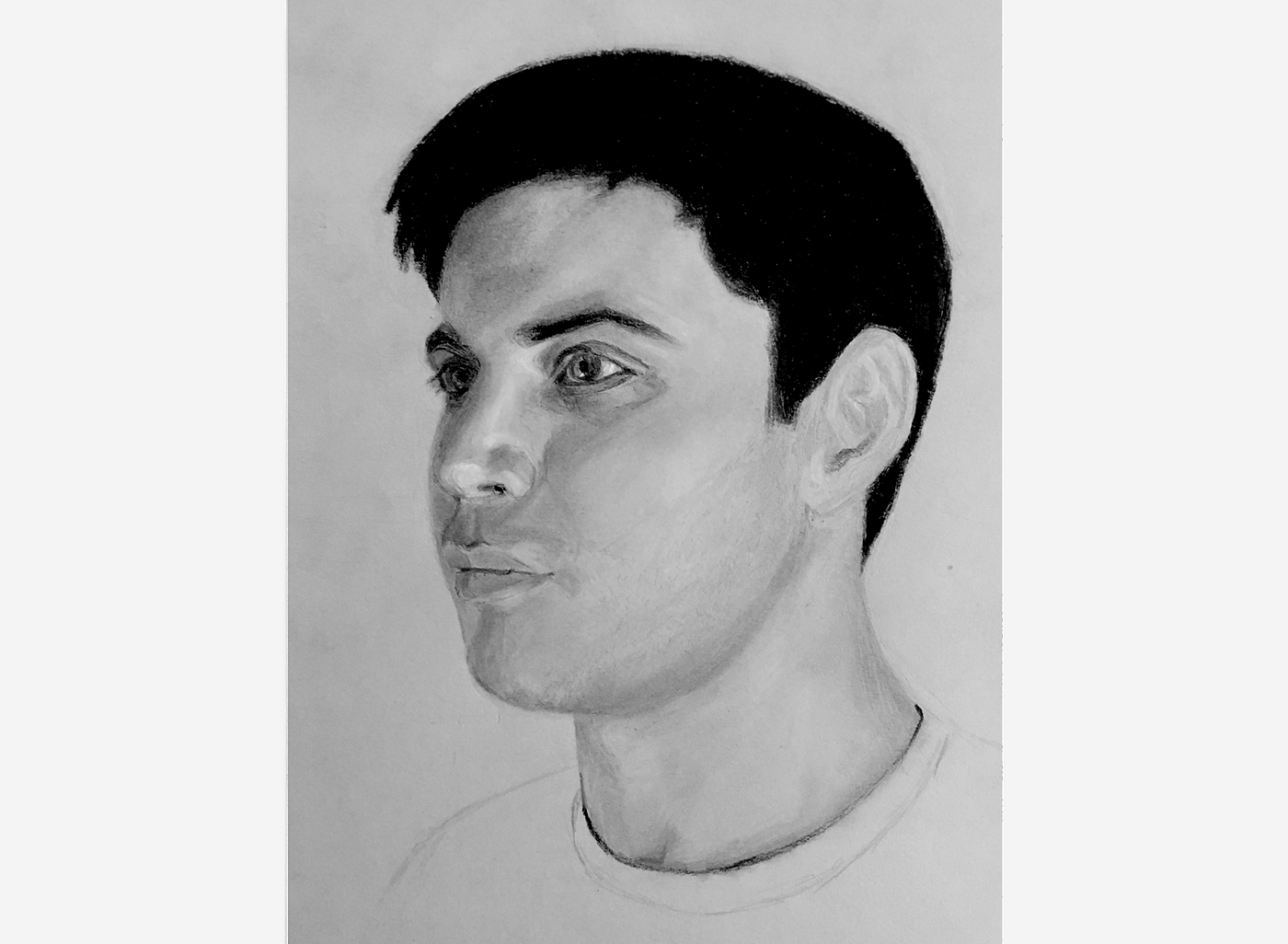
In other words, later on practicing for virtually an hour per day for 26 days, I majorly improved my portrait drawing skills.
Concluding calendar month, information technology only took me 22 hours to go a grandmaster of retentiveness.
I think this is going to exist a theme for the entire Calendar month to Master projection: If my practice is deliberate and consistent, information technology'southward going to have a lot less fourth dimension than expected to chief these seemingly expert-level skills.
The trick, then, is to create a machinery to forcefulness deliberate and consistent practise month after month. This is the hard function about learning these new skills, not the fourth dimension required.
Something to think about as you start planning your 2017 resolutions…

Today, I flew from San Francisco to Florida to see up with my family for a few days. I'll be here until Jan 4th.
I left all my cartoon supplies backside, so I'm definitely not cartoon any more this month.
I did, yet, bring a Rubik'due south Cube with me in preparation for January's challenge (which starts in ii days).
I'yard definitely eager to start a new challenge, since I like the thought of always existence in pursuit of something (which perhaps suggests that I demand to learn how to relax). Still, instead, these past two months, I've finished both challenges on Day 24 (of the calendar month), and thus, needed to expect, without a claiming, for a week, until the next one began/begins.
Should I just start the next challenge once I terminate the previous one? I'one thousand non sure. On ane mitt, this seems reasonable and time-efficient. On the other mitt, at that place is something very tidy about starting on the first of each calendar month.
Conspicuously, I take some amount of obsessive compulsiveness going on, merely I'g curious to know what you think…
Should I wait for the first of each month to start a new challenge, and enjoy my few days of relaxing (if bachelor), or should I just utilise my extra time towards futurity challenges and start immediately?
Let me know.

Today, to celebrate the New Year, I decided to compile my personal highlights from 2016, which includes Month to Master, but likewise everything else from my life.
Rather than writing another M2M mail service today, I'll encourage y'all to check out that post if you're interested.

This mail service is part of Max's year-long accelerated learning project, Month to Master.
Max Deutsch is the co-founder of Monthly — an online education platform that partners with some of the world'southward biggest YouTubers to create ane-month, highly-immersive online classes.
If you desire to follow forth with Max'southward twelvemonth-long accelerated learning project, make sure to follow this Medium business relationship.
For exclusive content on accelerated learning, discipline, and lifestyle blueprint, subscribe to my once-in-a-while newsletter.
Source: https://medium.com/@maxdeutsch/how-i-learned-to-draw-realistic-portraits-in-only-30-days-3fb8e8eccee0
Posted by: myerstoop1998.blogspot.com



0 Response to "How To Learn How To Draw Portraits"
Post a Comment